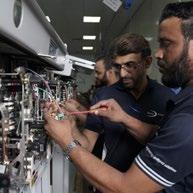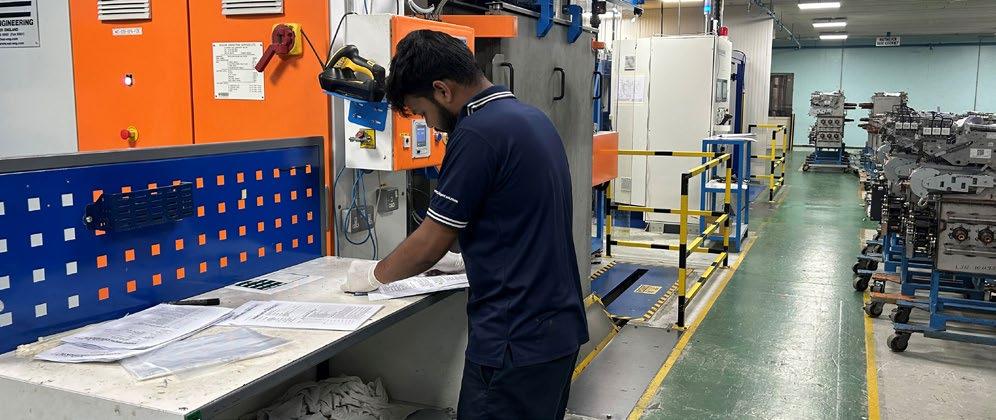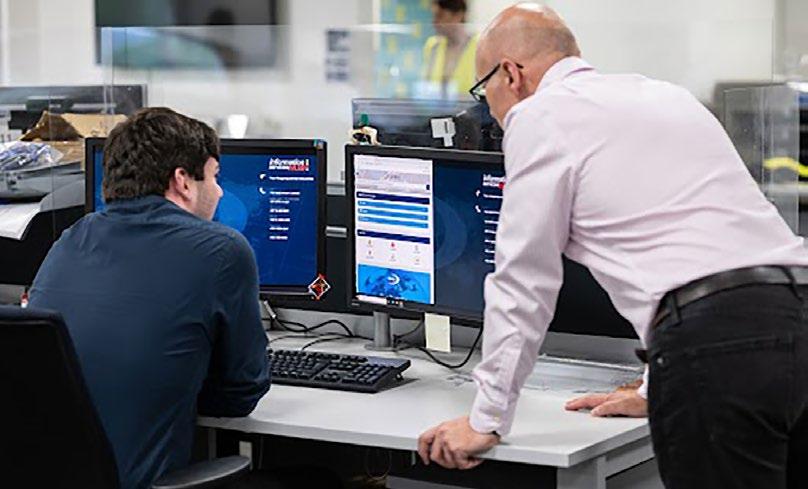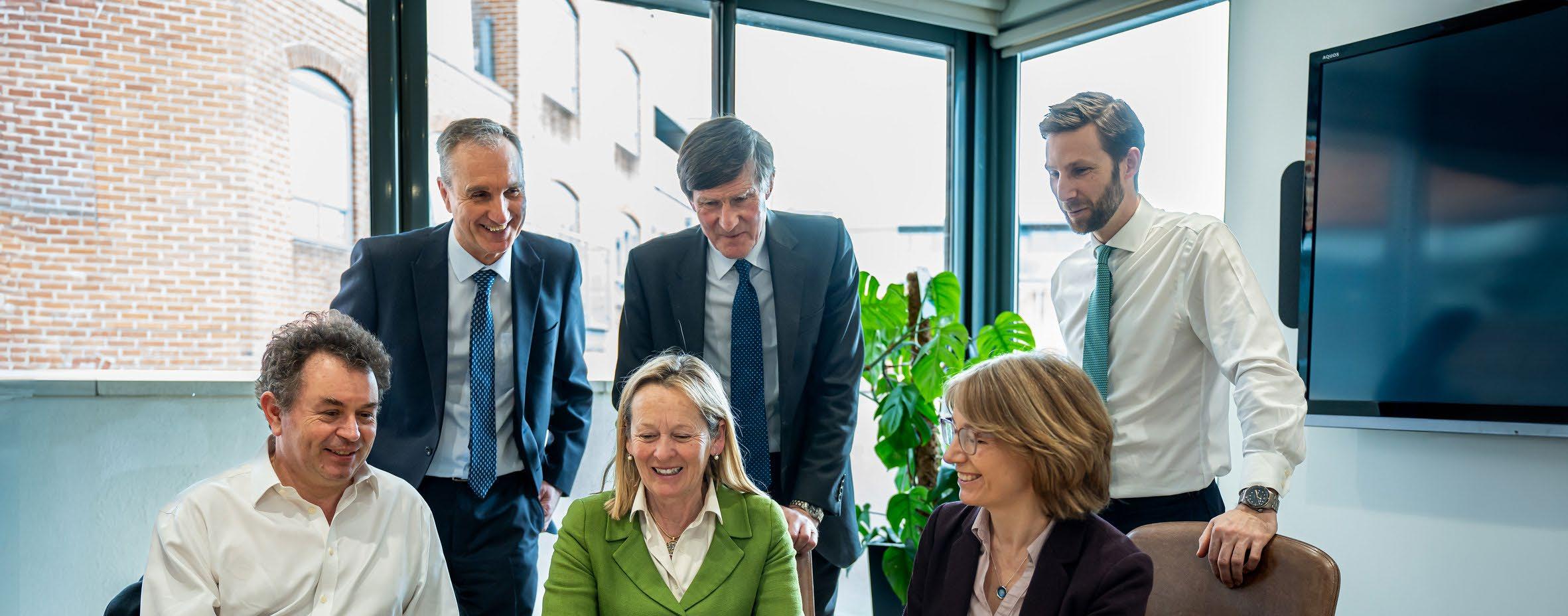

Lucy Group Ltd Eagle Works, Walton Well Road Oxford, OX2 6EE, UK t: + 44 (0)1865 518164 info@lucygroup.com www.lucygroup.com Registered office: Eagle Works, Walton Well Road, Oxford, OX2 6EE Registered number: 51908 England and Wales Lucy Group Ltd Annual Report & Accounts 2023 Making the built environment sustainable. Lucy Group Ltd Annual Report & Accounts 2023

Lucy Group is an international group that makes the built environment sustainable.
Our electric businesses advance the transition to a carbon-free world with infrastructure that enables renewable energy and smart cities.
Our real estate businesses support sustainable living through responsible property development and investment.

For more information visit our website: www.lucygroup.com




What’s in this report
P06
Our business in a nutshell
Summary profiles of our business units and their component parts.
P16
P24
P34
P56
Our sustainable approach
Business Overview Highlights 02 Chairman's Statement 04 Our Business at a Glance 06 Our Solutions 08 Our Locations 10 Our Purpose Framework 12 Strategic Report Market Overview 16 Case Studies 18 Our Business Model 24 Our Group Strategy 26 Key Performance Indicators 28 Operational Review 30 Business Reviews: Lucy Electric 34 Lucy Controls 38 Lucy Real Estate 42 Financial Review 46 Risk Management 50 Environmental, Social and Governance (ESG) 56 Governance Board of Directors 66 Corporate Governance Report 68 Report of the Directors 72 Relations with Stakeholders 74 Directors’ Responsibilities 76 Independent Auditor's Report to the Shareholders of Lucy Group Ltd 77 Financial Statements Consolidated Income Statement 82 Consolidated Statement of Comprehensive Income 83 Consolidated Statement of Financial Position 84 Consolidated Statement of Cash Flows 85 Consolidated Statement of Changes in Equity 86 Principal Accounting Policies 87 Notes to the Accounts 94 Company Statement of Financial Position 116 Company Statement of Changes in Equity 117 Notes to the Company Accounts 118 Shareholder Information Advisors, Financial Calendar and Registered Office 128 Notice of Meeting 129 Five-year Summary 130 Contacts 132
Contents
Our market drivers What fuels demand for our products and the size of our addressable markets.
How we run our business
Our model for creating, capturing, delivering and sustaining value.
Business unit insights Overviews of individual business unit performance, market context and outlook.
How we put people, planet and progress into action.
the
LUCYGROUP.COM | 01
P130 Financial summary Key financial data over
past five years.
Financial highlights


Turnover £359.1m 189.6m 204.0m 263.8m 313.2m 359.1m 2023 2022 2021 2020 2019 Rental income £9.1m 7.9m 7.9m 8.2m 8.4m 9.1m 2023 2022 2021 2020 2019 Net assets £324.1m 186.5m 201.4m 238.4m 289.1m 324.1m 2023 2022 2021 2020 2019 Operating profit before net valuation gains on investment property £62.3m 5.3m 26.0m 39.5m 35.5m 62.3m 2023 2022 2021 2020 2019 Profit before tax £59.5m 6.2m 27.1m 42.2m 35.3m 59.5m 2023 2022 2021 2020 2019 Total comprehensive income for the year £37.8m 0.4m 16.0m 39.5m 52.8m 37.8m 2023 2022 2021 2020 2019 Earnings per share 8,241p 241p 4,731p 6,403p 6,989p 8,241p 2023 2022 2021 2020 2019 Total dividends per share (paid and proposed) 286p core 300p special 209p 215p 233p 264p 286p 300p 175p 150p 125p 2023 2022 2021 2020 2019 Read more on pages 56–63. ESG highlights Carbon intensity 51tCO2e/£M 2023 59 tCO2 e/£M 2022 Number of CSR projects completed 198 2023 128 2022 Employee engagement 77% 2023 76% 2022 BUSINESS OVERVIEW STRATEGIC REPORT GOVERNANCE FINANCIAL STATEMENTS SHAREHOLDER INFORMATION LUCYGROUP.COM | 03
02 Lucy Group Ltd Annual Report & Accounts 2023
HIGHLIGHTS
CHAIRMAN’S STATEMENT

Highlights
Richard Dick Executive Chairman
We are confident in our strategy and that our focus on quality, smart products, and customer care positions us well for the future.”
I am pleased to present Lucy Group’s Annual Report and Accounts for the year ending December 2023. This year, with a backdrop of challenging global markets and increased competition in key sectors, we have achieved a landmark performance. Our record turnover of £359m and profit of £59m is a testament to our people and strategy.
In Lucy Electric, strong sales growth has been driven by our attention to quality, product development and customer focus. The diversification of our range, notably with smart products, has been instrumental in strengthening our position in the medium-voltage power distribution market.
The Lucy Controls businesses continue to break new ground, with innovative technology expanding market access and resulting in some substantial contracts, particularly for Flashnet. Progress at Lawson Fuses was encouraging, with sales 33% up on the previous year. This year, we have seen Lucy Zodion collaborate effectively with Lucy Electric to deliver packaged solutions in the area of electric vehicle infrastructure.
In Lucy Real Estate, Lucy Properties has systematically enhanced our investment property portfolio and maintained healthy rental income growth and occupancy levels.
Increased interest rates in the UK have constrained Lucy Developments, with
higher borrowing rates and subdued demand for new homes.
The Group has navigated the complexities of the global business landscape, turning challenges into opportunities for growth and innovation. The increased proportion of smart solutions within our portfolio, coupled with the calming of raw material and logistics costs post Covid, has enabled us to improve margins.
Performance
The Group has seen a record year in both sales and profit, with sales growth of 15% (2022: 19%) and profit before tax for the year increased by 69% (2022: decreased 16%).
This has been marked by an extremely busy year across the Group, with margin recovery in most areas and a strong product mix across the Group. Cash has been positively impacted, with a free cash inflow of £21.8m (2022: £10.5m). Net assets increased by 12% (2022: 21%).
Our planning is for the long term and the strong balance sheet will continue to allow the Group to be strategic in making investment decisions.
Dividend
The Board recommends a final dividend of 170p to be paid on 3 May 2024 to shareholders on the register on 31 March 2024 which, including the interim dividend of 116p per share, represents a full-year dividend of 286p (2022: 264p). The Group paid a special dividend of 300p on 7 December 2023 (2022: 175p), reflecting a very strong performance as the business continues to grow.
Strategic developments
Our strategic objective is to consistently drive long-term value for the benefit of our stakeholders; this includes developing growth opportunities and maintaining margins through increased market access, innovation and efficiencies. In July 2023, we acquired the assets and IP of Fundamentals’ Artificial Intelligence and Machine Learning (AI/ ML) business. This exciting technology will merge with Lucy Electric’s GridKey monitoring system to improve fault management and predictive maintenance across the electricity network.
We continue to invest in all areas of the business to maximise the Group’s potential.
This year saw the start of significant investment in manufacturing facilities in India, Saudi Arabia and the UAE to increase capacity and capability, as well as a new regional headquarters in Saudi Arabia. At Lucy Zodion in the UK we have taken the decision to add production capacity in 2024 to increase output of feeder pillars and associated products for the fast-growing electric vehicle charging market.
We have seen continued engineering success and product development across our businesses. Notably, the momentum around Lucy Electric’s Ecotec products, which eliminate SF-6 gas, has continued to gather pace, while Lucy Zodion’s EVIS electric vehicle charging equipment won the Highway Electrical Association’s most innovative product award.
Our people
In our business, the skills and knowledge of our people are critical. Their know-how is immensely valuable to Lucy Group and the service we deliver to our customers. 2023 was a year of substantial talent development and recruitment, adding value to our already formidable team.
Our
employees’ resilience, creativity and dedication have been pivotal to our success.
Their commitment has been the cornerstone of our ability to adapt swiftly to customer needs and market changes. We are driven by a clear purpose and set of values that resonate with our people. Our overall employee engagement score has improved steadily over the past few years and now stands at 77%.
Environmental, Social and Governance (ESG)
Our commitment to sustainability is unwavering. We have a continuous process of improving our sustainability performance, looking at all areas of what we make, what we consume, what we dispose of, and what we buy. We continue to advance our carbon reduction targets and next year plan to install solar PV in several of our operations, all part of our path to Net Zero. This year we were presented with our ten-year achievement award in Carbon Reduction by Achilles, a widely recognised carbon accreditation system. Externally, our product designs continue to prioritise environmental considerations, aligning with the UN Sustainable Development Goals.
We continue to support the communities that we operate in. This is ingrained in our culture, one example being my personal experience of taking part in a 'CEO sleepout' in Oxford in October, which helped raise £75k for the Oxfordshire Homeless Movement.
Outlook
Our outlook remains optimistic, despite difficult conditions in some markets and a dip in order intake towards the end of the year. We are confident in our strategy and that our focus on quality, smart products, and customer care positions us well to capitalise on the global trend toward intelligent energy infrastructure and smart city solutions. We know that competition is tough, and may increase in certain growth markets, so we must continue to adapt and remain at the forefront.
We remain open to exploring growth through acquisitions, as evidenced by our acquisition of the assets and IP of Fundamentals’ AI/ML business, and our successful integration of Flashnet, along with our organic growth plans. The collaborative projects running across our Group highlight the synergy possible when working together. In closing, I extend my heartfelt thanks to our talented and dedicated employees for their efforts throughout the year. Their unwavering commitment and adaptability have been instrumental in what has turned out to be a record year and in setting a strong course for the future. wish them all health and success in 2024.
Richard Dick Executive Chairman 20 March 2024
04 Lucy Group Ltd Annual Report & Accounts 2023 LUCYGROUP.COM | 05 BUSINESS OVERVIEW STRATEGIC REPORT GOVERNANCE FINANCIAL STATEMENTS SHAREHOLDER INFORMATION
OUR BUSINESS AT A GLANCE

Lucy Electric
Lucy Electric is an international leader in intelligent secondary power distribution products and solutions, with features such as remote operation and monitoring. Linking energy generation to consumption, the business specialises in high-performance medium and low-voltage switchgear for utility, industrial and commercial applications.
For more information on Lucy Electric, see our business review on page 34.

Lucy Zodion
Lucy Zodion is an industry leader in advanced street lighting controls, power distribution and electric vehicle (EV) supply solutions. Our products assist customers with energising urban and highways infrastructure from the ground up. Our range includes photocells, power distribution enclosures, EV connection feeder pillars, isolators, cut outs and switchgear.




Lucy Properties
As one of Oxford’s largest private landlords, Lucy Properties is a lettings and management business that invests in and manages over 350 commercial and residential properties for over 850 tenants, with in-house service and maintenance, and an increasing focus on sustainable living.

Lawson Fuses
Lawson Fuses specialises in the design, development and manufacture of low-voltage, high-rupturing capacity (HRC) fuse links and fuse holders. Sold directly and via distributors, applications are suitable for electric and electronic capital equipment, utilities, renewable energy and domestic households.
For more information on Lucy Controls, see our business review on page 38.

Flashnet
Flashnet offers a portfolio of smart, connected street lighting and grid management systems. The business integrates the latest IT, Internet of Things (IoT), energy and telecommunications technologies into hardware and software solutions to create and implement intelligent infrastructure and city control systems.

Lucy Developments
Lucy Developments is a developer of high-end, sustainable homes, with prime sites within a 90-minute commute of Oxford. We create bespoke, high-end properties with EPC A or B-ratings, which embrace innovative design, ecological materials and renewable energy.
For more information on Lucy Real Estate, see our business review on page 42.


06 Lucy Group Ltd Annual Report & Accounts 2023 LUCYGROUP.COM | 07 BUSINESS OVERVIEW STRATEGIC REPORT GOVERNANCE FINANCIAL STATEMENTS SHAREHOLDER INFORMATION
OUR SOLUTIONS

Energy distribution
Overview
Our switchgear and EV charging infrastructure enable the efficient distribution of electricity, with features such as remote switching and monitoring. Our low-voltage fuses provide safety and protection, which ensures uninterrupted power.
Why is it important to us?
By connecting renewables to the grid – including solar, wind, hydro and geothermal power – we can help reduce the planet’s carbon footprint and mitigate the impacts of climate change. A diversified energy mix also increases resilience to supply disruptions and price fluctuations.
Our business units
Lucy Electric, Lucy Zodion and Lawson Fuses.

Smart cities
Overview
Our intelligent street lighting, EV charging infrastructure and IoT connectivity help deliver information to users, achieve operational efficiencies, and gain energy savings.
Why is it important to us?
Smart cities provide a framework for integrating sustainable practices into urban environments. Smart technologies and AI – including predictive modelling –enable more efficient monitoring and management of energy consumption, thereby minimising energy waste, cost and carbon emissions.
Our business units
Lucy Zodion and Flashnet.

Sustainable living
Overview
Our residential property development, investment, and lettings and management business focuses on the Oxford area, which was named as England’s greenest city in the ENDS Report in 2023. Whether rented or owned, each property embraces performance measures that support sustainable living.
Why is it important to us?
Housing contributes 17% of the UK’s total carbon emissions. To preserve the environment, every household needs to play its part. Our methods include the use of solar power, heat pumps, EV chargers, biodiversity features and ecological materials.
Our business units
Lucy Real Estate.
Our solutions include:
• secondary power distribution equipment;
• switchgear for connection and control of renewable power;
• distribution substations for EV charging networks;
• fuses for safe energy delivery; and
• smart grid monitoring and control.
Our solutions include:
• smart city management and control;
• street lighting infrastructure;
• feeder pillars for EV charging;
• big data capture and digitalisation; and
• electrical safety and protection.
Our solutions include:
• property development: ecological and energy efficiency; and
• lettings and management: sustainable living.

08 Lucy Group Ltd Annual Report & Accounts 2023 LUCYGROUP.COM | 09 BUSINESS OVERVIEW STRATEGIC REPORT GOVERNANCE FINANCIAL STATEMENTS SHAREHOLDER INFORMATION
OUR LOCATIONS
The Group trades internationally, with offices and factories in strategic locations all around the world. Our infrastructure enables us to serve geographically dispersed markets, provide efficient support to all customers, and swiftly adapt to changing demand patterns.




1,700 employees
5 continents
12 countries
60 countries we trade in



LUCYGROUP.COM | 11 BUSINESS OVERVIEW STRATEGIC REPORT GOVERNANCE FINANCIAL STATEMENTS SHAREHOLDER INFORMATION
10 Lucy Group Ltd Annual Report & Accounts 2023 Lucy Group Ltd Annual Report and
OUR PURPOSE FRAMEWORK
Our purpose
Lucy Group’s purpose is to improve people’s lives with intelligent power, smart lighting and sustainable homes.
We put people and the planet at the heart of everything we do, in order to achieve meaningful progress: from power distribution infrastructure that delivers electricity to homes and businesses, to switchgear that connects renewable energy sources to the grid, charging solutions that facilitate the adoption of EVs, smart cities that deliver groundbreaking emissions reductions, and modern homes that support sustainable living. In meeting our customers’ needs, we are committed to the UN Sustainable Development Goals. While advancing the built environment, we strive to preserve the natural environment and invest in the local communities we operate in.


Our culture
Our culture helps to shape and deliver against our purpose. Operating within a defined set of Group strategic priorities that are adapted for each business, every employee is encouraged to push boundaries, while ensuring that continuous improvement is sustainable. By aligning our culture with our purpose, we aim to enhance employee motivation, engagement and performance.
For more information on our Group strategic priorities see page pages 26-27.

Our values
Our purpose and culture are underpinned by a set of values that guide the way we interact with all of our stakeholders, including customers, suppliers, partners, colleagues, and shareholders. These values define what it means to be a part of the Lucy family and the standards we uphold. They guide us to make the right decisions, develop our businesses and challenge the status quo.
Caring
We treat all with fairness and respect. We value diversity. We recognise and develop our people.
Trusted
We build and maintain trusted relationships with all people and partners.
Working together
Teamwork and communication are at the forefront of everything we do. We share our knowledge across our organisation for the benefit of everyone.
Excellence
Through ingenuity and a dedication to quality, we create smart, sustainable solutions.
Daring to differentiate We are market leaders. We make bold decisions. We stand out.
12 Lucy Group Ltd Annual Report & Accounts 2023 LUCYGROUP.COM | 13 BUSINESS OVERVIEW STRATEGIC REPORT GOVERNANCE FINANCIAL STATEMENTS SHAREHOLDER INFORMATION

Strategic Report In this section Market Overview 16 Case Studies 18 Our Business Model 24 Our Group Strategy 26 Key Performance Indicators 28 Operational Review 30 Business Reviews: Lucy Electric 34 Lucy Controls 38 Lucy Real Estate 42 Financial Review 46 Risk Management 50 Environmental, Social and Governance (ESG) 56 LUCYGROUP.COM | 15 14 Lucy Group Ltd Annual Report & Accounts 2023
MARKET OVERVIEW
Our market at a glance
Energy Distribution
Smart Cities
Sustainable Living
Energy distribution
Market opportunity
Market drivers
Enabling a more sustainable future
People
Planet Progress
The global electricity transmission and distribution market is projected to grow from US$318bn in 2022 to US$429bn in 2030, at a CAGR of 3.9% (source: Fortune Business Insights).
While growth in some geographies is driven by expanding industrialisation and urbanisation, the common denominator is the rise in renewable energy. Governments and businesses – influenced by the public’s increasing environmental consciousness – are investing heavily in renewable energy, aiming to reduce carbon emissions and transition towards sustainable energy sources.
The distribution side of the market is experiencing particularly strong growth. The increasing adoption of distributed energy sources, such as solar panels and energy storage systems, is changing the traditional centralised model of distribution. Grid resilience is also a key factor, with growth in EVs putting more pressure on grid capacity, and distribution network operators pushing to increase the efficiency of supply and minimise energy losses.
• The transition to renewable energy;
• The adoption of EVs;
• Growth in renewable power storage;
• Need for information and intelligent infrastructure; and
• Demand for grid resilience, reliability and control.

Smart cities
Market opportunity
The global smart cities market was valued at US$657bn in 2022, and is expected to register a CAGR of 25.8% from 2023 to 2030 (source: Grand View Research).
Driven largely by environmental concerns, the smart infrastructure market is rapidly evolving with the integration of advanced technologies such as IoT, AI and 5G. Smart city ecosystems encompass various sectors, including transportation, energy and buildings, to enhance efficiency, sustainability and connectivity in the built environment.
Smart cities aim to improve the quality of life for residents, while also promoting economic growth and environmental sustainability.
By leveraging technology and analysing data in real time, the aim is to optimise renewable resource allocation, reduce carbon emissions, curb pollution, improve civic services and enhance urban living.
Market drivers
• Desire for higher standards of living and convenience;
• Growing urban populations putting pressure on infrastructure;
• Increasing focus on renewable energy and sustainability;
• Rising demand for cost efficiencies and control; and
• Advancement in intelligent analytic technologies.
Sustainable living
Market opportunity
The UK green building market had total revenues of US$6bn in 2022
(source: GlobalData), while the UK Green Construction Industry 2021 Report predicts an annual sector CAGR of 9.8% between 2021 and 2025
(source: Research and Markets). Around 80% of first-time and 73% of second-time buyers in the UK were likely to consider a green home in 2022 (source: Statista).
The UK Government’s Building for 2050 Report estimated that the current UK housing stock contributes 17% towards the country’s total carbon emissions. Green building involves the design, construction, operation and maintenance of buildings in an environmentally responsible and resource-efficient way. The goal is to minimise any negative impact on the environment and human health, while also maximising the positive impact on energy efficiency, water conservation, biodiversity, indoor air quality and overall sustainability.
The UK’s construction sector is set to invest heavily in eco-friendly building practices and to adopt certifications such as BREEAM (Building Research Establishment Environmental Assessment Method) and LEED (Leadership in Energy and Environmental Design).

Market drivers
• Increased environmental consciousness;
• Demand for cost-of-living reductions;
• Advancements in green building technologies;
• Support of circular economy models; and
• Government regulation and incentives.

Market size £538bn 2023 Market size £5bn 2023 Market size £262bn 2023
Read more about ESG on page 56–63. 16 Lucy Group Ltd Annual Report & Accounts 2023 LUCYGROUP.COM | 17 BUSINESS OVERVIEW STRATEGIC REPORT GOVERNANCE FINANCIAL STATEMENTS SHAREHOLDER INFORMATION
CASE STUDIES

Lucy Electric boosts South Africa’s installed wind capacity
Lucy Electric has supplied a quantity of Aegis 36kV Ring Main Units (RMUs) to help South Africa lift the share of renewable energy in its power generation mix from 11% to 41% by 2030. Used to support the outdoor connection of wind turbine-generated electricity, one RMU serves each turbine, with connection to a Lucy Electric substation for export to the local grid.
Specially designed for secondary distribution networks, wind farms and photo-voltaic power stations, the Aegis product is suited to harsh external environments without an additional enclosure, and also offers high levels of reliability and operator safety. It is compact, cost-effective, durable and requires minimal maintenance.
18 Lucy Group Ltd Annual Report & Accounts 2023 LUCYGROUP.COM | 19 BUSINESS OVERVIEW STRATEGIC REPORT GOVERNANCE FINANCIAL STATEMENTS SHAREHOLDER INFORMATION

Lucy Zodion powers Cornwall’s sustainability drive
Lucy Zodion partnered with Enerveo to support Cornwall County Council’s ‘Drive EV2’ infrastructure project, reducing the 875,000 tonnes of greenhouse gases generated annually by the county’s road traffic. The project, delivering EV charging points across 42 car parks, included a total of 109 SWARCO EV charge points, which comprised 19 rapid 50kW chargers (capable of recharging an EV battery to 80% in around 40 minutes) and 90 7kW slow chargers (typically for overnight use). Each car park is powered by a Lucy Zodion EVIS pre-wired feeder pillar, with a mix of 100A and 200A DNO cabinets, with 10 configurations to match different charger quantities and ratings.
BUSINESS OVERVIEW STRATEGIC REPORT GOVERNANCE FINANCIAL STATEMENTS SHAREHOLDER INFORMATION LUCYGROUP.COM | 21 20 Lucy Group Ltd Annual Report & Accounts 2023
CASE STUDIES CONTINUED
CASE STUDIES

Lucy Real Estate completes renovation of suburban health centre
Lucy Real Estate has completed the renovation of the former Jericho Health Centre in Oxford, UK.
The ground floor is now occupied by a 2,745 square foot Sainsbury’s Local store. In 2024, Lucy Real Estate will move into an office space behind the retail store, giving the lettings and management business a high street frontage and walk-in reception area.
The upper floors comprise 17 high quality apartments, all of which are now occupied. Each unit has an EPC A rating, and the building has its own solar supply from the roof panels, an air source heat pump, zone control heating and low energy lighting. To support biodiversity, a living roof has been installed on the top floor.
BUSINESS OVERVIEW STRATEGIC REPORT GOVERNANCE FINANCIAL STATEMENTS SHAREHOLDER INFORMATION LUCYGROUP.COM | 23 22 Lucy Group Ltd Annual Report & Accounts 2023
CONTINUED
OUR BUSINESS MODEL
We create value by leveraging our key relationships, global positioning and innovative approach to deliver products that are both sustainable and fit for purpose.
1 We use our key resources
Our people
We take measures to attract, retain and develop the best talent at all levels and across all disciplines.
Our expertise
We focus on continuous improvement, through product development, value engineering and acquisitions.
2 and apply our Group strategic priorities and core values…
Our Group strategic priorities
High performing businesses in diverse industries
Customers at the centre of everything we do
Engagement and development of our people
Sustainable solutions and communities
Excellence through innovation to differentiate and lead
Our values
Caring Excellence
Working together
Trusted
Daring to differentiate
Our relationships
We take pride in our great relationships with customers and other stakeholders, which are built on trust and proven track record.
3 to enable our business units…
4 to focus on our areas of expertise
Our infrastructure
We prioritise capital investment, which ensures that our worldwide manufacturing operations can meet market demand.
5 ...and create innovative products and services...
Our financial rigour
We take a prudent approach to growth, with a solid balance sheet underpinned by our control framework and optimal gearing.
6 that fulfil our purpose...
To improve people’s lives with intelligent power, smart lighting and sustainable homes.
• Electrical switchgear
• Intelligent street lighting
• EV charging products
• IoT connectivity and control
• Electrical safety fuses
• Property for rental and purchase
For more information see:
Our products and services: pages 06–09.
Our infrastructure: pages 10–11.
Our purpose and values: pages 12–13.
Our Group strategy: pages 26–27.
Our expertise: pages 34–35.
Our financial rigour: pages 46–48.
Our responsible approach: pages 56–63
Our people: pages 62–63.
Our relationships: pages 74–75.
Our responsible approach
Sustainability is embedded in our business, in both what we offer our customers and how we manage our operations.
7 and unlock value for our stakeholders
Consumers
Reliable solutions that ‘keep the lights on’ and enhance sustainable living.
Customers
Advanced, well-supported products that can be relied upon for longevity and an increasingly low carbon footprint.
Employees
Fulfilling, meaningful careers where they are actively engaged and rewarded for delivering value.
Shareholders
An ethical investment, providing a growing dividend return over the long term, while also furthering the sustainability agenda.
Communities
Social consciousness and investment in, and active support for, the local communities we operate in around the world.
Environment
Products and operations that promote the health of the planet, mitigating global warming and promoting biodiversity.
Government
Products and services that support government schemes and regulations to proliferate renewable energy and raise appropriate taxes.
Suppliers
Long-term, strategic partnerships and contracts that allow investment for the future and shared value creation. Lucy Electric
Lucy Controls
Lucy Real Estate
Smart Cities Sustainable Living Energy Distribution
24 Lucy Group Ltd Annual Report & Accounts 2023 BUSINESS OVERVIEW STRATEGIC REPORT GOVERNANCE FINANCIAL STATEMENTS SHAREHOLDER INFORMATION LUCYGROUP.COM | 25
OUR GROUP STRATEGY
We aim to consistently deliver sustainable growth and long-term profits for the benefit of our stakeholders and the communities that we live and work in. We achieve this by focusing on five strategic priorities.
Strategic pillar Priorities Performance in 2023 Priorities for 2024
High Performing Businesses in diverse industries
• Deliver long-term profitability and sustainable growth by achieving 2024 revenue and profit budgets and targets
• Drive through improved governance by adopting the Leading Responsibly framework
Customer at the Centre of everything we do
• Give excellent customer service to both internal and external stakeholders
• Focus on market intelligence to drive customer value and competitiveness
• Lawson Fuses posted a 33% growth in sales year on year, in a highly competitive fuse-gear market
• Flashnet exceeded sales targets and gained a foothold in the US market with its innovative inteliLIGHT solution
• Bolstered the ‘intelligent’ capability of Lucy Electric by acquiring AI technology from Fundamentals
• Launched the Leading Responsibly governance framework and rolled out several new and updated policies
• Lucy Properties’ most recent tenant survey achieved a ‘How likely are you to recommend?’ score of over 95% across both incoming and outgoing tenants
• Rolled out the standardised D365 Customer Relationship Management tool across several businesses, replacing disparate, multi-vendor solutions
• Expansion through new and existing markets and products, while managing margins
• Continuous improvement in productivity, cost efficiency and agility
• Compliance with global policies and local regulation
• Excellent customer service and care to internal and external stakeholders
• Market intelligence and customer data to drive value and competitiveness
• An uncompromising approach to quality and standards
Engagement and Development of our people
• Focus on developing our people by giving them new skills and increasing engagement
• We employ the best people to contribute to the ongoing growth of the Group while improving diversity and inclusion
• Our overall employee engagement score has improved steadily and now stands at 77%
• Delivered over 9,000 hours of self-paced and instructor-led training across the Group
• High employee engagement rates at every site and level
• Attraction, retention and upskilling of talent to support ongoing growth
• Diversity and inclusion to stimulate fresh thinking
Strategic pillar Priorities Performance in 2023 Priorities for 2024 Sustainability in solutions, communities and environments
• Operate sustainably to reduce environmental impact and create customer value
• Deliver Greenhouse Gas and energy efficiency targets
• Engage with and support our communities
• 46 of Lucy Properties’ rental units were upgraded from an EPC rating of D–G to a rating of A–C
• 52 biodiversity net gain and environmental projects were completed across different sites
• Lucy Zodion has decreased mains electricity consumption by 42% through initiatives such as the switch-off campaign and the installation of solar panels
• 198 CSR projects completed
• The health, safety and wellbeing of all stakeholders
• Reduced environmental impact across operations, supply chains and customers
• Actively supporting and investing in our communities Excellence through Innovation to differentiate and lead
• Be bold and innovate – create smart products, services and solutions that drive customer value
• Create business intelligence transformation through improved data collection, storage and analysis
• Counter the cyber security threat to protect our long-term business opportunities
• Advances in new product development included:
– Lucy Electric’s 12kV Aegis Ecotec Ring Main Unit, which provides an alternative solution to SF6 gas
– Lucy Zodion’s award-winning EVIS feeder pillars that support EV charging; and
– Acquisition of the Synaps AI algorithm to support grid resilience
• Launched a cyber security training module for all employees
• Bold thinking to meet changing customer needs
• Digitalisation and AI to enhance value across customer offerings and business operations
• Data capture and integrity, countering cyber risk
26 Lucy Group Ltd Annual Report & Accounts 2023 LUCYGROUP.COM | 27 BUSINESS OVERVIEW STRATEGIC REPORT GOVERNANCE FINANCIAL STATEMENTS SHAREHOLDER INFORMATION
KEY PERFORMANCE INDICATORS
The Group has selected a number of key financial and non-financial performance indicators, which are used to monitor the key drivers of our business and to align our strategy to performance.
Financial KPIs
KPI Relevance Performance in 2023 Strategic link Sales growth
Aligns with our growth strategy. Sales growth exceeded plan and was supported by product introductions.
PBT
Profits generated by the business are a key indicator of our performance and key to our long-term financial health.
Increased sales volumes and improved product mix fuelled a return to PBT growth in the year. Return
We strive to produce positive returns across all businesses and use this measure to monitor how efficiently we are using our capital.
Each business sector has differing asset profiles and returns are measured against an appropriate target for that sector.
Our business units continued to make good progress and Lucy Electric had another strong year.
The Group’s substantial investment property portfolio continues to provide a balanced risk profile over the long term, although the portfolio experienced a devaluation for the second year running.
Operational / non-financial KPIs
KPI Relevance Performance in 2023 Strategic link
Total Recordable Incident Rate (TRIR)
The health and safety of our employees is of paramount importance and we have a proactive approach to monitoring and improving this across the Group. The data is based on standard working hours and excludes overtime, which will be incorporated in future years.
The Group has a significant investment property portfolio and occupancy is a useful indicator for income and customer satisfaction.
Although Lost Time Incidents decreased, a rise in medical treatment cases has resulted in a higher TRIR. The inclusion of data from contractors within our property development business has been a contributing factor. The safety of employees remains the Group’s main priority, with a collaborative approach adopted to deliver improvements.
Occupancy rates were maintained at the previous year’s high level alongside increases in rents, delivering a strong performance in the Properties business.
We are committed to reducing our impact on the environment, as highlighted in the ESG section on page 56.
Lucy Electric purchases sulphur hexafluoride (SF6), a greenhouse gas, for use in some of its products. As this is not consumed by the Company only loss during normal manufacturing process is included in this figure.
Genuine engagement across the workforce is vital to enhancing productivity, encouraging innovation, retaining top talent, and achieving our business goals.
Throughout the year the businesses have implemented measures to reduce emissions and energy consumption. In the year there was a total carbon reduction of 0.8%. Scope 1 and 2 emissions reduced by 5.7%, while Scope 3 emissions increased by 3.7%. Our annual carbon intensity has decreased by 13.5% since 2022.
Participation in our employee engagement survey rose from 80% to 84%, while the overall engagement level rose from 76% to 77%. Our goal is to reach and remain within the top 10% of our peer group, scoring above 80% for engagement.
13% 8% 29% 19% 15% 2023 2022 2021 2020 2019
growth 185% 339% 56% (16)% 69% 2023 2022 2021 2020 2019
on Net Assets 3% 13% 18% 12% 18% 2023 2022 2021 2020 2019
3.51 4.28 4.43 6.57 2023 2022 2021 2020 Injuries per 1,000 employees
Occupancy rate for rental properties 98% 98% 99% 99% 99% 2023 2022 2021 2020 2019
TCO2e 17.1k 18.1k 18.4k 18.3k 2023 2022 2021 2020
engagement score 72% 73% 76% 77% 2023 2022 2021 2020
NEW: Employee
28 Lucy Group Ltd Annual Report & Accounts 2023 LUCYGROUP.COM | 29 BUSINESS OVERVIEW STRATEGIC REPORT GOVERNANCE FINANCIAL STATEMENTS SHAREHOLDER INFORMATION
High-performing Businesses Customer at the Centre Engagement and Development Sustainability Excellence Through Innovation
OPERATIONAL REVIEW

Our commitment to 'improving people’s lives' remains the guiding principle, shaping our product development, corporate culture and stakeholder engagement.”
Our journey through 2023 has been one of both resilience and strategic development. In a year of global challenges and increasing competition, our unwavering focus on innovation, sustainability and customer service has bolstered our position as a leader in our respective sectors.
2023 progress
During the year, each of our businesses worked hard to deliver against the Group’s Priorities. Examples of success can be seen on pages 26 and 27.
Strategy
Our portfolio of products and services is mixed and exposes us to both mature and growth markets, which balances risk and reward. Across the Group, we have a deep understanding of the industries and markets we operate in and continue to deploy our expertise to grow and internationalise, both organically and through acquisition.
It is in our Company’s DNA to embrace innovation and offer industry-leading solutions to create the networks of the future. We continue to invest in our core products, adding smart functionality to our switchgear equipment and providing customers with an environmentally friendly alternative to SF6 without compromising performance.
With artificial intelligence (AI) and machine learning (ML) playing an increasing role in grid-edge
technologies, we acquired the assets and IP of Fundamentals’ AI/ML business, which are being integrated with Lucy Electric’s GridKey activities. We have set up a new centre of excellence in Swindon for the team that moved across from Fundamentals and look forward to leveraging its power to improve system efficiency and reliability for our customers across the global electric power industry.
Over the years, we have developed a 'glocal' approach to manufacturing. We have factories in strategic locations around the globe that observe international quality standards and best practices, while catering to local market needs. We must retain the right resources in the right locations to balance regulation with cost-efficiency and agility. Through 2024, we will be executing plans to expand plants in certain regions and will be taking steps to ensure that our supply chains are both fit for purpose and resilient.
Sustainability improvements
Through our products and services, we are advancing the transition to a carbon-free world. We support the expansion of the electricity network, the adoption of renewables, and the proliferation of intelligent control to generate energy savings.
Through our own operations and our supply chains, we take steps to protect the planet and to support the communities in which we work.
In 2023, environmental responsibility was further embedded in how we operate. We continue to invest in renewable energy sources, particularly solar, aligning our operations with global carbon reduction goals. Most Group companies have achieved ISO 14064 carbon footprint certification, a testament to our commitment to reducing greenhouse gas emissions. The few outstanding Group companies will be brought within the certification in 2024. Value engineering programmes continue to lower the embedded carbon in our products and operating practices, reflecting our commitment to People, Planet and Progress.
Technological advancements
As signalled in last year’s report, we continued to roll out Microsoft D365 and to further the digitalisation of our operations. This year, Lucy Zodion and Lawson Fuses replaced their old ERP systems with D365 Finance & Operations. Lucy Electric implemented Vendor Collaboration to streamline supplier partnerships and qualification
processes. Implementation of D365 Sales provided a universal standard to replace a number of existing multi-vendor solutions across several businesses. The Microsoft Power Platform has enabled us to run a successful digital birth certificate pilot for some of our products, utilising an integrated app in D365. Data from each stage of the manufacturing process is recorded, providing customers with full product and component traceability. ‘Smart’ technology is at the core of our latest products. As we develop our product offering to respond to evolving market trends, we increasingly leverage digital technologies to enhance functionality, data analytics, convenience and control.
Countering cyber risk continues to be a high priority throughout the Group. This year, a mandatory training programme was developed and launched for all employees, supporting IT cybersecurity measures with the appropriate behaviour to mitigate risk.

30 Lucy Group Ltd Annual Report & Accounts 2023 LUCYGROUP.COM | 31 BUSINESS OVERVIEW STRATEGIC REPORT GOVERNANCE FINANCIAL STATEMENTS SHAREHOLDER INFORMATION
OPERATIONAL REVIEW

People and governance
We continue to support, invest in and develop our employees’ skills and capabilities. Our HR teams delivered over 9,000 hours of self-paced and instructor-led training across the Group as part of a wide range of employee development programmes. Our overall employee engagement score, measured via the Peakon survey, has risen to 77%. This year we launched a behavioural safety campaign comprising a Health & Safety guide and a suite of posters in multiple languages for displaying on-site.

Incident reports (lagging indicators) and pro-active measures like training (leading indicators) underpin our efforts to be safety conscious at all times.
Safety remains a cornerstone of our culture and, as we expand our production facilities, is more important than ever.

In 2023 we launched a new governance framework known as ‘Leading Responsibly’, supporting our strategic priorities for the year. Based on a clear set of new and updated policies, the purpose of this initiative is to give managers the confidence to take local level business decisions more quickly within a defined Group framework.
Summary and outlook
Operationally, 2023 has been a year of significant progress for Lucy Group. Our continuous improvement across plant, technology, sustainability, and people have enhanced our operational efficiency and equipped us for future growth.
The Group continues to take a long-term strategic approach, investing profits back into the business. Significant capital projects are under way for 2024 to expand manufacturing capacity in a number of regions, while product development, information technology and engineering investments are expected to increase in all businesses to ensure we remain equipped to serve changing market needs.

Employee engagement as a KPI
Employee engagement is one of the Group’s strategic pillars and has been measured for the past four years, using a recognised third-party survey and analytics tool. We see it as vital to enhancing productivity, encouraging innovation, retaining top talent, and achieving our business goals.
We have seen incremental improvements in our overall engagement score, rising from 72% in 2020 to 77% at the end of 2023. We want to continue that upward
trend, with a clear aim to reach and remain within the top 10% of our peer group, scoring more than 80%. That can only be achieved by listening to the employee voice and converting feedback into actions that effect positive change.
To underline its importance to the future of the Group, we have now introduced Employee Engagement as an official KPI, against which we commit to report on an annual basis (see pages 28 to 29).
32 Lucy Group Ltd Annual Report & Accounts 2023 LUCYGROUP.COM | 33 BUSINESS OVERVIEW STRATEGIC REPORT GOVERNANCE FINANCIAL STATEMENTS SHAREHOLDER INFORMATION
CONTINUED
BUSINESS REVIEW – LUCY ELECTRIC
 John Griffiths CEO Lucy Electric
John Griffiths CEO Lucy Electric
By investing in our international manufacturing units and increasing local supply, we have been able to keep serving our customers with advanced products and services that meet changing market needs.”
As a leader in engineering innovative, intelligent solutions for the safe and efficient distribution of electricity, Lucy Electric has had a strong year, with growth across most regions.
Market review
Global electricity demand has risen steadily in the past few years, driving investment in new energy infrastructure. The International Energy Agency (IEA) projects demand to grow by an average of 3.4% from 2024 to 2026, with 85% of the increase in the world’s electricity demand expected to come from outside advanced economies – most notably China, India and Southeast Asia.
This year, global annual renewable capacity additions increased by almost 50% to nearly 510 gigawatts and renewables are set to make up more than one-third of total electricity generation by early 2025. Our portfolio of switchgear products and services positions us favourably to support energy infrastructure investments, as global efforts intensify to cater for increasing consumption of electricity while meeting Net Zero targets. Our performance across all the geographies we serve was encouraging.
In India, infrastructure is key to the nation’s goal of becoming a US$5 trillion economy by 2028. This is driving the nation’s switchgear market, which is expected to register a CAGR
of more than 7% over the next 5 years (source: Mordor Intelligence). Consequently, we are investing in plant capacity in Vadodara to meet this growing demand. Increased investment in renewables will reinforce demand, as the government seeks to reduce the energy dependency and emissions intensity of its economy.
Saudi Arabia’s Vision 2030 government programme has given rise to a number of mega and giga projects as well as more traditional installations and network reinforcements. The residential real estate market shows no signs of slowing, while investment in the industrial sector is building momentum as the country reduces its dependence on oil and promotes economic diversification. To cement our position in the region, we are investing in a new factory in Dammam, as well as a new MENA regional headquarters in Riyadh.
Lucy Electric Australasia Pty Ltd, established in 2022 in Sydney to expand our footprint in the Oceania region, has made good progress.
Product development and innovation
Our Ring Main Units are the mainstay of our product capability, and much work has been done to comply with incoming European F-gas regulation. This year we successfully trialled our Aegis and Sabre 12kV Ecotec Ring Main Units, which will gradually phase out fluorinated gas as an insulating medium and substitute it with synthetic air. The new products were engineered to occupy the same footprint dimensions, enabling them to be interchanged with existing installations. Further development is under way for higher-voltage
applications. Our core products are increasingly equipped with smart electronics and communication capabilities to enhance dependability, efficiency and control. In the EV space, we have partnered with Lucy Zodion to provide advanced solutions for EV charging applications, combining feeder pillars and substations as a seamless packaged solution. With increasing demand being placed upon electrical networks, and the added complexity of renewable installations connecting to power networks, grid resilience has never been more critical. Our DNO customers across the globe are keen to better anticipate demands, predict and prevent faults, and minimise outages. Therefore, in July this year, we acquired the assets and IP of Fundamentals’ Artificial Intelligence & Machine Learning (AI/ML) business.
Focusing on grid monitoring and fault location, this new capability will merge with Lucy Electric’s GridKey intelligent low-voltage remote monitoring system and digital substation activities. Using a digital twin, we now have the means to detect, classify and locate faults, enabling customers to carry out preventative maintenance that avoids interruptions to power supply.
Manufacturing and supply chain
We continue to invest in our manufacturing facilities to cater for expected growth in demand.
Aligned with our goal to improve the sustainability of our manufacturing operations, we have invested in new technologies, materials and processes. We have made a positive contribution towards the Group’s emissions target

by reducing the business unit's carbon intensity by 14% from 2022 to 2023.
We have also taken steps to eliminate single-use plastics and to reduce non-recyclable waste. Next year we plan to extend our decarbonisation efforts to Scope 3 emissions via careful evaluation of our supply chain.
Some supply chain disruptions persisted in 2023, particularly from regions still affected by Covid-19.
Although the lead time for microchips can still be 12 months, we have seen a marked improvement in the availability of other raw materials. We have also widened our supplier base, giving us more flexibility and improving our resilience to supply restrictions going forward.
Our people
Our strength lies in our experience, industry knowledge and skills, as demonstrated by our talented and dedicated workforce. We continue to champion engineering as a desirable career, building relationships with local schools and ensuring knowledge transfer across the business. In addition to our apprenticeships and STEM ambassador programmes, we have introduced a graduate development programme to consistently nurture a pipeline of

skilled engineers and independent thinkers, grounded in shared values and a commitment to environmental improvement.
Our latest engagement survey showed a good level of participation across all Lucy Electric regions and has had a generally positive response, improving across all areas, increasing our retention rate, and putting us above average for our industry.
As the digital landscape continues to grow and evolve, we are adapting by integrating new skills into our teams, such as data analytics and systems integration. We continually invest in our people through initiatives like the new Future Leaders programme to develop and upskill our workforce, mitigating the current skills gap seen across the industry and helping to sustain our success.
Outlook
Lucy Electric is well positioned to capitalise on the global shift towards electrification. Our products and services are aligned with global ambitions for Net Zero, enabling us to provide the safe, reliable and smart electrical solutions essential for a universal transition.
We have a solid track record in many geographic markets, our brand is trusted to perform, and our customer care remains a top priority. However, competition is fierce, both from global and local players, and growth markets often attract new entrants.
We continue to invest in new plant, equipment and capacity in our manufacturing facilities, while evolving our product and service offering to stay at the forefront. Looking ahead, we are confident in our ability and expect to sustain our success as the size of our addressable market grows across multiple geographic regions.
John Griffiths CEO Lucy Electric
34 Lucy Group Ltd Annual Report & Accounts 2023 LUCYGROUP.COM | 35 BUSINESS OVERVIEW STRATEGIC REPORT GOVERNANCE FINANCIAL STATEMENTS SHAREHOLDER INFORMATION
CAPABILITY – LUCY ELECTRIC
Our products are used to enable the safe and efficient distribution of electricity, with remote switching and monitoring capability. The diagram shows the role we play in the electric power supply chain, from package substations and switchgear for 12–145kV installations through to end-user termination points. The range now incorporates solutions for renewable connections, EV charging and data capture to monitor electrical demand and performance across networks.
Case study
Lucy Electric converts National Highways from manual to automatic
Lucy Electric have installed around 1,700 GridKey Cable Smart safety monitoring systems on National Highways’ electrical lighting circuits on main roads and motorways in the UK. The systems continuously test the earthing and health of underground cables, which normally requires road closures to enable engineers to carry out periodic manual testing.
Extrapolated from data analysis, it has been projected that a national roll-out could save 500,000 manhours of time on the road network each year, adding up to a total of £4m estimated annual savings and a payback for the system installation of less than a year.

Power generation, including offshore wind
400kV
Step-up transformer
End-use applications: industrial, commercial, civic and residential
Distributed generation
• Renewables: onshore wind and solar
• Battery storage
Primary transmission
132kV
Step-down transformer
Secondary distribution: medium to low voltage stand-alone Ring Main Units (RMU) or package substations
GridKey monitoring system with data analytics, SYNAPS AI fault detection, and Remote Terminal Unit (RTU) for connecting to utility control room
Connection solutions
Secondary distribution: overhead products
Denotes Lucy Electric’s role in the electric power supply chain.
Primary distribution
132kV to distribution voltages
TRANSMISSION DISTRIBUTION
36 Lucy Group Ltd Annual Report & Accounts 2023 LUCYGROUP.COM | 37 BUSINESS OVERVIEW STRATEGIC REPORT GOVERNANCE FINANCIAL STATEMENTS SHAREHOLDER INFORMATION
BUSINESS REVIEW – LUCY CONTROLS
 Jonathan Finch-Dick Lucy Group Executive Director
Jonathan Finch-Dick Lucy Group Executive Director
With an unflinching focus on customer service, quality and innovation, Lucy Controls provides significant opportunity for further growth."
This year saw encouraging progress, with revenue growth across all three businesses.
Business operations summary
Lucy Zodion
Lucy Zodion specialises in street lighting controls and low-voltage infrastructure, particularly around electric vehicle charging across the UK. In street lighting, the key market driver is energy efficiency and the associated benefits of lower costs and reduced carbon emissions. While the return on investment is compelling, many customers are local authorities facing severe budget constraints, making the upside of this challenging market hard to predict.
Investment in Electric Vehicle (EV) infrastructure shows no signs of abating, accelerating the transition away from fossil fuels. Our EVIS (Electrical Vehicle Infrastructure Solutions) electric pillar range, which caters for a wide array of EV charging needs including on-street and fast-charging hubs, won the ‘Most Innovative Product of the Year’ award at the 2023 Highway Electrical Association (HEA) Awards. Building on this success, next year we will be expanding our Sowerby Bridge site to increase manufacturing capacity.
Lawson Fuses
Lawson Fuses specialises in low voltage High Rupture Capacity (HRC) fuse links and holders, marketed direct to utilities, capital equipment OEMs and wholesalers. The business performed well this year with a 33% increase in revenue over last year across a number of markets.
We have continued to automate our manufacturing lines, improving efficiencies and margins, and won a number of new business contracts, providing a solid platform for continued growth going into next year. As we identify gaps in the market, we will continue to expand our product offering.
Flashnet
Flashnet focuses on developing, manufacturing and distributing smart lighting and power management systems. The integration of Flashnet into the Lucy Group since the acquisition in June 2022 has been in line with expectations, and this year the business secured substantial revenue growth and contract wins across a number of different markets in Europe and North America.
One of those key wins was the delivery of 85,000 nodes for smart lighting controllers with a central management control system for a major lighting project in Washington DC in the US. The success continued by securing an even larger contract with a large utility provider in the US to enhance their smart street lighting. With the interoperable ‘inteliLIGHT’ smart street lighting control system, Flashnet has a strong customer proposition and can typically reduce municipal street lighting budgets by 10-20% on energy consumption and another 10-20% on maintenance.
Market overview
While cities only account for 2% of the Earth’s surface, they consume 78% of the world’s energy and produce more than 60% of greenhouse gas emissions (source: UN Habitat).
The Lucy Controls businesses are all well placed to supply urban landscapes with sustainable solutions. The electric vehicle market is expected to continue its upward trajectory as the developed world prioritises sustainable transportation. Under the Zero Emission Vehicle (ZEV) mandate, by law 100% of new vans and cars in the UK must be zero emission from 2035. Similarly, the adoption of smart street lighting systems with integrated sensors and connectivity is gaining momentum, endorsed by local authorities keen to make the built environment more sustainable and cost-efficient. To ensure safety and resilience of power supply, fuses remain a critical part of electrical systems and are often favoured over circuit breakers for their dependability, rapid response, versatility and low cost.
Product development and innovation
Our businesses have been working hard to develop new and innovative products to broaden our offering and enhance the current range.
At Flashnet, we are expanding our product portfolio, providing increased functionality, and seamlessly integrating our open-standard solutions with other city services like asset tracking, air quality monitoring and water metering. Lucy Zodion’s EVIS electric vehicle feeder pillars have adopted standardised designs to simplify selection and dramatically reduce leadtimes. Next year, Lucy Zodion will be re-platforming the photocell range and launching higher power, low-voltage cabinets for bigger EV applications like EV hubs. Lawson Fuses is developing new products for industrial and grid switchgear applications, as well as for the protection of semiconductors.
Across Lucy Controls, our commitment to innovation, high quality and, exceptional customer service remains

unwavering. This consistency is a hallmark of our brands and a key factor in continued success.
Sustainability
Our products are designed to drive down emissions and build a more sustainable future.
Internally, we continuously develop and evolve our products to use less materials and make them more efficient. We are investing in our factories and facilities to ensure they are operating as efficiently as possible to support the Group’s Net Zero goals and targets. A prime example is Zodion’s switch-off campaign and the installation of solar panels, which has reduced mains electricity consumption by over 50% in 2023.
Technology developments
Our product range, heavily reliant on software technology, necessitates meticulous management. Adherence to standards is becoming ingrained in our operations, ensuring robust data security. The potential expansion of AI is being actively explored, reflecting our commitment to staying ahead in a technologically advancing world.
Across our operations, deploying business intelligence tools is central to our strategy for growth and development. Microsoft D365 Finance & Operations was introduced at Lucy Zodion and Lawson Fuses. The roll-out of D365 Sales gathered pace and will continue into 2024, including the CRM application that replaces disparate multi-vendor solutions with a standard system. These investments provide real-time insights into our
business operations, speed up decision making, and help us remain responsive to customer needs.
Our people
As we scale our operations, our people remain our most significant asset. Sourcing top talent with the current shortage of engineers, particularly engineers with a digital understanding, presents a challenge. We are working hard to make Lucy Group a great place to work with shared values and goals. We are committed to upskilling, training and developing staff wherever we can. This focus on people is essential to our future success.
Outlook
As the drive to reach Net Zero picks up momentum, more countries are committing to ambitious carbon reduction targets and sustainable practices. Through intelligent street lighting, electric vehicle charging infrastructure, IoT connectivity and electrical safety, Lucy Controls' objective is to support the transition to smarter urban environments. As we navigate through 2024 and beyond, we serve competitive but growing markets. Our technological excellence, strategic market positioning, and commitment to quality and innovation give cause for optimism.
Jonathan Finch-Dick Lucy Group Executive Director
38 Lucy Group Ltd Annual Report & Accounts 2023 LUCYGROUP.COM | 39 BUSINESS OVERVIEW STRATEGIC REPORT GOVERNANCE FINANCIAL STATEMENTS SHAREHOLDER INFORMATION
CAPABILITY – LUCY CONTROLS

Q
How have EV customers benefitted from the collaboration between Lucy Zodion and Lucy Electric? A
By combining our knowledge, customers gain from an unrivalled understanding of the highway electrical distribution landscape.
Together, Lucy Zodion and Lucy Electric span mediumvoltage networks and lowvoltage infrastructure, vital for many EV hub and public chargepoint installations.
Our customers have access to expansive solutions –including feeder pillars, substations and associated controls – that address their sustainability, cost-efficiency, compliance, capacity and compatibility needs.
Customers also benefit from a single maintenance contract, a more economical and agile way to ensure the power is always on.

Q
On the back of a promising year, how will Lawson Fuses sustain growth going forward?
AThe electric fuse market is looking buoyant, with an expected global growth rate of 6-7% CAGR over the next decade.
We will work tirelessly to deliver sustained growth by focusing on a number of key initiatives: market expansion; productivity gains; world-class customer service; accredited highquality product; a talented workforce; and an innovative product mix.
We understand that planned growth will be accompanied by both macro and micro economic challenges (inflation, labour shortage, geo-political etc.).
However, our strong focus on business fundamentals and shared knowledge from Lucy Group will help us in overcoming some of these challenges.

Q
A
What has been the appeal of Flashnet products in the global street lighting control market?
First of all, customers like our problem-solving approach and can-do attitude. Every member of our dedicated team is passionate about finding innovative solutions to smart lighting challenges, as well as delivering the highest quality of product.
Our cutting-edge technology achieves substantial savings for municipal budgets, typically up to 40% of the combined street lighting energy consumption and maintenance cost.
True interoperability is another appealing feature, enabling multiple suppliers to ‘talk’ to each other and seamlessly integrate.
Finally, our track record speaks volumes – we control more than 1 million streetlights in 150+ cities across 60 countries and 6 continents.
Our products are used to advance smart city infrastructure and to optimise energy conservation, while maintaining safety. From fuse products to intelligent street lighting, EV charging infrastructure and automation and control, we play a vital role in modernising urban environments. The diagram shows the range of solutions we provide.

Isolators and cut-outs
Isolators and cut-outs
Isolators and cut-outs
Case study
In-ground distribution Photocells and controls
Isolators and cut-outs Lamppost
Flashnet switches Washington DC to energy-efficient street lighting
Washington DC’s vision for a smarter, safer and more energy-efficient city laid the foundation for one of the largest urban streetlight modernisation projects in the US.
Besides converting the city’s street lights to energy-efficient LED technology, the project deploys 75,000 Flashnet 'inteliLIGHT' smart street lighting NEMA controllers to provide remote monitoring and control capabilities. Planning work began in May 2022, with 75% of the conversion (56,000 poles) implemented from the second quarter of 2023.
Upon completion in May 2024, the city expects to derive significant environmental and economic benefits, reducing energy consumption by more than 40%, optimising maintenance operations and enabling safer, more connected communities.
 Loránd Mózes Chief Executive Officer, Flashnet
John Fox Managing Director, Lucy Zodion
Harsha Raghavan General Manager, Lawson Fuses Remote energy management CMS and IoT platforms
Loránd Mózes Chief Executive Officer, Flashnet
John Fox Managing Director, Lucy Zodion
Harsha Raghavan General Manager, Lawson Fuses Remote energy management CMS and IoT platforms
EV charge infrastructure
charging pillars HRC fuse links and holders Pillar shells and pre-wired pillars In-ground distribution Photocells and smart lighting controls
and cut-outs EV charging pillars HRC fuse links and holders Pillar shells and pre-wired pillars In-ground distribution Photocells and smart lighting controls
EV
Isolators
EV charging pillars HRC fuse links and holders Pillar shells and pre-wired pillars
Remote energy management CMS and IoT platforms In-ground distribution Photocells and smart lighting controls
Lamppost EV charge infrastructure
EV charging pillars HRC fuse links and holders Pillar shells and pre-wired pillars In-ground distribution
Photocells and smart lighting controls
EV charging pillars HRC fuse links and holders Pillar shells and pre-wired pillars
40 Lucy Group Ltd Annual Report & Accounts 2023 LUCYGROUP.COM | 41 BUSINESS OVERVIEW STRATEGIC REPORT GOVERNANCE FINANCIAL STATEMENTS SHAREHOLDER INFORMATION
BUSINESS REVIEW – LUCY REAL ESTATE

Despite challenging market and regulatory conditions, Lucy Real Estate delivers both rental income stability and the opportunity for sales growth."
 Ian Ashcroft CEO Lucy Real Estate
Ian Ashcroft CEO Lucy Real Estate
While Lucy Properties benefited from a favourable market context for rental units, Lucy Developments was impacted by a range of factors that affected both the affordability and delivery of our properties.
Market overview
Lucy Properties benefitted from a favourable market context for rental units. While demand for rental homes across the UK was down 11% on the previous year, it was still a third higher than the five-year average, while average rents for new lets rose 9.7% (source: Zoopla). In central Oxford, which commands a premium of nearly 15% over the wider Oxfordshire area (source: Carter Jonas), the rental market has surged due to a shortage of available stock and rising tenant demand driven partly by high mortgage interest rates.
Lucy Developments was impacted by a range of factors affecting house builders across the UK - including rising interest rates, cost of materials, skills shortages and changing legislationthat have affected both the affordability and delivery of our properties. The lack of available land, coupled with a flawed planning system, make it challenging to obtain consent for new developments. We have, therefore, taken steps to mitigate these factors by heightening our focus on land buying and planning applications.
Operations
At Lucy Properties, we had another year of excellent results with a 7% rental income increase and 99% occupancy levels throughout the year. Nevertheless, with rising interest rates pushing up yields, our investment property portfolio devalued by £2.5m during 2023. Although the market remains competitive, we put our tenants at the forefront of everything we do, maintaining exceptional service as demonstrated by our most recent tenant survey where over 95% would recommend us across both incoming and outgoing tenants.
We believe a sense of community is key and our tenant relationship ethos sets us apart from other landlords. This year we have made great efforts to communicate with our tenants, keeping them informed about what's happening in their local area and the events we put on, such as yoga sessions and carols around the Christmas tree. We want to combat loneliness and other negative mental health impactors, instilling pride in the places where our tenants live by creating shared spaces everyone can enjoy. Lucy’s Little Library, a popular book swapping initiative, is a good example of how we bring this to life.
This year, Lucy Developments completed the regeneration of the former Jericho Health Centre site and handed the baton to Lucy Properties to let the space. The enhanced building included an additional nine apartmentsrenamed Cranham House - as well as the eight refurbished apartments, five of which were given back to Oxford City Council. All apartments were quickly let, while the ground floor commercial
space is now occupied by a 2,745 square foot Sainsbury’s Local store. The remaining, smaller commercial space on the ground floor at Cranham House will be occupied during 2024 by Lucy's Real Estate business, giving our lettings & management business a high street frontage and walk-in reception area.
It has been a challenging year for Lucy Developments, with another main contractor going into administration. This caused significant delays to build completion dates, along with increased build costs. We have, however, used this as a learning experience, adding impetus to our plans to bring more of our builds in-house. This direct procurement means we are no longer so reliant on main contractors, giving us greater visibility and control over scheduling, quality, material costs and the overall embedded carbon across our sites.
2023 saw the completion of The Rickyard development in Marsh Baldon, which contains six homes ranging in size from two to five bedrooms. We worked hard to create an attractive mixture of designs that blended with the local architecture and complemented the beautiful village. We are proud to have received a letter of commendation from Oxford Preservation Trust for the positive contribution this small scheme of premium homes makes to the county. Our plan to invest in a new management information system was delayed. In 2022, we conducted a business process mapping exercise to streamline both businesses and improve operational efficiencies. However, it took longer than anticipated to identify a suitable vendor to deliver an end-to-end solution tailored to the real estate industry. A partner is due to be appointed and we expect implementation in 2024.
Sustainability
This year saw the amendment to the Part L building regulations, under which all new homes must produce at least 31% less carbon emissions. We have been working hard to reduce the carbon footprint of our properties, while also increasing their energy efficiency.
Sustainability was a key factor during the refurbishment of Cranham House. The new apartments have their own solar supply from roof panels and air source heat pumps, along with zone controlled heating and low energy lighting throughout. The existing apartments were brought up to our standard, replacing the boilers, windows and increasing insulation, resulting in all apartments achieving an EPC A rating. Creating a community space was also important, so we installed a living roof on both the top floor and podium level garden with a variety of plants to attract a range of wildlife, increasing biodiversity and giving residents some much needed green space that is often sought after in a city.
Despite the UK Government scrapping the requirement for all rental properties to have a minimum EPC rating of C, Lucy Properties is continuing to upgrade its properties to meet the original energy efficiency targets of 1 April 2025 for new tenancies and 1 April 2028 for existing tenancies. All Lucy Development new builds will achieve EPC ratings of A or B. We continue to work hard towards the Group’s overall net zero goal and yearly emission intensity reductions and will continue to monitor this across all our properties and builds.
Our people
The majority of employees within Lucy Real Estate have worked with us for a number of years. We are proud to have such a strong team of dedicated individuals who enjoy working for Lucy Group, as reflected in our most recent engagement survey.
Over the last year, we have strengthened our resources in Lucy Developments to enable direct procurement. We continue to equip both businesses with the right training, development and skills to meet the requirements of changing legislation and licensing schemes.
Outlook
In the rental business, a number of smaller landlords have exited the market due to high mortgage interest rates and the increasing burden of compliance.
For Lucy Properties, the outlook for the year ahead is positive, provided that the UK government’s proposed new rent legislation is not introduced. The exact nature of the Renters (Reform) Bill is as yet unclear but, although it is intended to address bad landlords, it is likely to curb the power of all landlords in respect of rent increases, length of tenancy agreements, and rights to evict. Otherwise, the lettings market is particularly favourable for us due to the prime locations and wide variety of properties in our portfolio, coupled with a national shortage of rental properties. Compared to our competitors, there is some headroom for rent increases, while some of our properties have development potential.
In Lucy Developments, the market landscape remains challenging, but we are cautiously optimistic for 2024 as we focus on targeted land purchases and larger scale sites delivering economies scale. We have already secured a sufficient land bank for 2025 and 2026 and have started on our biggest site to date, 40 units in Oxford. Planning permission applications are also in progress for two further sites. Despite suppressed demand for newly built residential properties across the UK, we believe that our focus on quality, premium units in prime locations will continue to attract discerning buyers. Our focus on sustainability adds appeal as householders increasingly prioritise eco-friendly features and energy efficiency. This approach, combined with our reputation and knowledge of the local community, gives us confidence that we will be successful in 2024 and beyond.
Ian Ashcroft CEO Lucy Real Estate
42 Lucy Group Ltd Annual Report & Accounts 2023 LUCYGROUP.COM | 43 BUSINESS OVERVIEW STRATEGIC REPORT GOVERNANCE FINANCIAL STATEMENTS SHAREHOLDER INFORMATION
CAPABILITY – LUCY REAL ESTATE
Case study Oxford Preservation Trust backs Lucy Developments scheme
The Rickyard is a small scheme of high-quality new homes in Marsh Baldon, a highly sought after location in a beautiful south Oxfordshire village. The development comprises six homes ranging in size from two to five bedrooms. There is an attractive mix of designs, yet each blends in with the local architecture.
Built with sustainability in mind, the homes are equipped with air source heat pumps, underfloor heating, low energy LED lighting, and electric vehicle charging points. Each garden has established shrub and tree planting to support biodiversity.
Completed in March 2023, with all properties since sold, the development received a letter of commendation from Oxford Preservation Trust. Our real estate businesses are centred on Oxfordshire, where we are one of the region’s leading private landlords and niche property developers. We aim to support sustainable living via eco-friendly property construction and rental. The case study demonstrates one of our recently completed development projects.

Lucy Developments focuses on residential properties within a 90-minute commute from the Lucy Group head office in Oxford. The business partners with the very best architects, designers and craftsmen to create bespoke properties for sale in prime locations. Sustainable and ecological features are an integral part of each build.
Sustainability as a foundation
Lucy Properties is a property owner, lettings & management business within Oxfordshire. Our portfolio comprises over 500 lettable units with over 650 tenants. Our properties - including residential units, offices, car parks and agricultural land - are managed and maintained in-house, providing an extremely high-quality service to residential and commercial tenants alike.
Properties Developments 1 2 4 3 1 2 3 4 5 6 6 5 Site preparation Property investment Acquire land Reinforcing competencies: placemaking and first-class service Tenancy agreement Planning permission Renovate and inspect Architectural design Market for letting Community Market for sale Testimonials and awards Tenant referrals Construction and snagging Ongoing maintenance Tenant after-care Environmental surveys | Land remediation | Site regeneration Ecological materials Insulation | Solar panels | EV chargers
Heat pumps Zone controlled heating | Energy-efficient lighting Biodiversity features | Green spaces | Rainwater harvesting 44 Lucy Group Ltd Annual Report & Accounts 2023 LUCYGROUP.COM | 45 BUSINESS OVERVIEW STRATEGIC REPORT GOVERNANCE FINANCIAL STATEMENTS SHAREHOLDER INFORMATION
FINANCIAL REVIEW

While 2023 saw a strong uplift in revenue and profit, order intake has dipped.”
The Group reported record sales and profits for the year, delivering an 18.3% return to shareholders.
Revenue and order intake
Group sales were £359.1m (2022: £313.2m) for the year, 14.7% higher than 2022 or 14.6% on an organic constant currency basis (OCC), with the removal of the Flashnet acquisition largely offsetting the movement in foreign currency. Lucy Electric and Lucy Controls continued to benefit from their position in growth markets, whereas in Lucy Real Estate sales decreased because higher UK interest rates resulted in lower transactions and a main contractor going into administration delayed the completion of a development site in 2023. Sales in the second half of the year were 7.4% lower than in the first half of the year as order intake slowed. Order intake for the full year was £340.4m (2022: £398.3m), down 14.5% compared with 2022 and was 5.2% below this year’s sales.
Real estate rental income increased during the year by 7.7% to £9.1m and occupancy levels were maintained at 99% (2022: 99%). Residential rents increased by 7.5% (2022: 3.8%) and there were no commercial rent increases. Completion of the St Pauls House development in September added nine residential units and one commercial unit to the investment property portfolio.
The annual passing rent now stands at £9.7m, split 90:10 between residential and commercial tenancies.
Gross margin
Gross margin increased by 4.9 percentage points from 27.3% in 2022 to 32.2% in 2023. An improved product mix with more intelligent infrastructure products being sold and higher volumes of core products, together with increased utilisation of the Group’s manufacturing facilities, were responsible for most of this improvement.
Material costs continued to be closely monitored as the largest element of cost of sales. Lower commodity prices eased inflationary input price pressures, although semiconductor supply chain constraints continued throughout the year. The procurement team were able to deliver several component cost savings, together with their ongoing programme to strengthen supply chain resilience.
Value engineering activities continued to positively contribute to the Group, with a clear objective to optimise raw material usage and to reduce waste.
Overheads
Overhead costs increased by 11.6% compared to 2022. Driven by wage inflation and on an OCC basis, they increased by 11.1% after excluding currency movements and acquisitions.
Overhead costs as a percentage of sales decreased from 16.9% in 2022 to 16.5% in 2023.
We have significantly increased our engineering spend by 26.8% to £9.8m to expand our strategic product developments. No development expenditure was recognised as an intangible asset this year.
Other operating Items
Net other operating income increased to £5.7m (2022: £2.9m), largely due to a Lucy Zodion goodwill impairment of £2.3m in the prior year.
The 2023 figure included £0.5m of costs (2022: Nil) related to the planned relocation of Lucy Electric’s manufacturing activities in Saudi Arabia.
Operating profit
Group operating profit before valuation losses was £62.3m (2022: £35.5m), an increase of 75.3% compared with last year. There was a £2.5m loss from the annual valuation of the Group’s investment property assets compared with a loss of £0.9m last year. Higher interest rates have driven increases in property yields as the returns on relatively risk-free investments have increased. The higher interest rates have reduced demand in the Oxford property market, with many properties being sold below their asking price. These devaluations resulted in a Group operating profit after valuation losses of £59.9m (2022: £34.7m).
Profit before tax
PBT for the year was £59.5m (2022: £35.3m) after charging net finance costs of £0.4m, compared with net finance income of £0.6m last year. Finance income was £2.3m (2022: £2.3m) with interest receivable benefitting from more favourable interest rates being offset by the absence of foreign exchange gains and lower other operating income. Finance costs were £2.7m (2022: £1.6m) from higher interest rates, a foreign exchange loss, and higher other operating expenses despite a reduction in the amount of right of use assets.
Taxation
The Group's tax expense for FY23 was £19.0m (FY22: £1.1m), resulting in a headline effective tax rate of 32% (FY22: 3%). The increase in rate is largely driven by an adjustment, £10.8m, in respect of additional assessed tax on prior periods in Saudi Arabia. This adjustment has arisen due to the General Secretariat of Tax
Committees in Saudi Arabia ruling in favour of Zakat, Tax and Customs Authority in FY23, despite previously ruling in favour of Lucy Switchgear Arabia Company Limited in FY22. Having exhausted all legal avenues, with no form of independent appeal available, the additional assessed tax has been fully provided. Refer to Note 7 for further details on this adjustment. The prior year’s rate included the recognition of a deferred tax asset for earlier losses in Saudi Arabia.
Removing the impact of the above non-recurring adjustments provides a more reliable measure: on this basis, the adjusted effective rate of tax is 14% (2022: 12%).
The Group expects its adjusted effective tax rate to remain lower than the standard UK tax rate due to lower tax rates in many of the countries in which it operates. The Group's tax strategy seeks to ensure that key tax risks are appropriately mitigated and that the Group's reputation as a responsible taxpayer is safeguarded.
Dividends
The Board recommends an increased final dividend of 170 pence per share which, taken together with the interim dividend of 116 pence per share, gives a full-year dividend of 286 pence per share (2022: 264 pence per share) representing an 8.3% increase for the year.
A special dividend of 300 pence per share was paid in December, reflecting the Group’s strong performance compared with a special dividend of 175 pence per share last year.
Our dividend policy is to grow core dividends at least in line with the Retail Price Index (RPI) and to supplement core dividends with special dividends when the Board considers it appropriate after reviewing both profits and cash requirements.
Acquisitions
On 12 July 2023 the Group acquired the assets and IP of Fundamentals’ Artificial Intelligence and Machine Learning (AI/ML) business. Focusing on grid monitoring and fault location, this business will merge with Lucy Electric’s GridKey intelligent low voltage remote monitoring and digital substation activities.
The Group has a strategy of growing through a combination of organic expansion and acquisition. We continue to seek acquisitions that support the development of our business units.
Cash flow
The Group had a free cash inflow of £21.8m (2022: £10.5m) and £0.5m of foreign currency borrowings were repaid during the year.
Operating cash flow before changes in working capital, interest and taxes was an inflow of £67.1m (2022: £46.6m), largely driven by strong operating profits.
Control of working capital is key to achieving our cash generation during this period of growth. In 2023 working capital increased by £20.9m (2022: £18.4m) in support of both this year’s sales and future projected sales. Inventory increased by £19.7m (2022: £10.5m) to support higher volumes and to mitigate the disruption in the supply chain, whilst an investment of £7.0m in Lucy Real Estate’s land bank was required to facilitate its strategic growth plan. Receivables increased by £12.2m, reflecting higher sales volumes, although there was a modest increase in overdue balances compared with 2022. Payables increased by £11.2m, while provisions increased by £0.1m and there was a £0.2m outflow from changes in the value of derivative financial instruments.
Net interest received was an inflow of £0.4m (2022: outflow £0.6m) and tax payments were £10.4m compared with £3.2m in 2022.
Gary Ashton Group Finance Director
46 Lucy Group Ltd Annual Report & Accounts 2023 LUCYGROUP.COM | 47 BUSINESS OVERVIEW STRATEGIC REPORT GOVERNANCE FINANCIAL STATEMENTS SHAREHOLDER INFORMATION
FINANCIAL
Investing activities at £14.3m (2022: £14.0m) included capital expenditure of £15.4m (2022: £8.6m). Proceeds from disposals of property, plant and equipment of £1.2m (2022: £0.1m) included the sale of an investment property at 12 Cowley Road, Oxford, for £0.7m and several lease extensions contributed a further £0.4m.
Capital commitments at the end of the year were £6.1m (2022: £10.0m).
Financial position
A five-year £23.0m Revolving Credit Facility (RCF) with HSBC Bank PLC was refinanced during the year, leaving Group borrowing facilities unchanged at £43.0m.
Actual bank borrowings decreased by £1.5m to £14.0m at 31st December 2022. The Flashnet S.A. minority shareholder loans of £0.3m were extended during the year and are repayable on 1 July 2025.
The Group had net cash of £58.8m (2022: £40.7m) and net assets increased during the year by £35.0m to £324.1m.
The Group’s financial metrics remain strong, with gearing of 4.3% (2022: 5.3%) and interest costs covered 59 times (2022: 55 times).
Return on net assets
The Group recorded a return on net assets of 18.3% (2022: 12.2%) during the year.

Post-employment benefits
The Group accounts for postemployment benefits in accordance with IAS 19 Employee Benefits.
The balance sheet reflects the net surplus of the W Lucy Defined Benefit Pension Scheme in the UK as at 31st December 2023 based on the market value of assets at that date, and the valuation of liabilities using AA corporate bond yields adjusted to reflect the duration of the Scheme’s liabilities. This Scheme was closed in 2002 to new entrants to reduce the risk of volatility of the Group’s liabilities.
A triennial valuation of the Scheme was performed as at 6 April 2023. Following last year’s significant increase in bond yields, the valuation revealed a Scheme surplus of £11.2m and a funding level of 121% compared with a deficit of £4.4m in the previous valuation. As part of the actuarial valuation, the Company agreed from 1 January 2024 to pay contributions of £0.2m for expenses plus 21.5% of pensionable salary in respect of the Scheme’s active members, compared with 28.8% in the previous valuation.
The separate IAS 19 valuation performed as at 31 December 2023 showed a Scheme surplus of £16.4m (2022: £14.7m). This represents an increase in the funding level from 130% to 133% during the year. This improvement arose from the Scheme’s assets outperforming their expected rate of return by £1.5m. Changes in the mortality projection assumption decreasing life expectancies, and from updated commutation factors, resulted in an actuarial gain of £1.8m.
Company contributions paid during the year were greater than the Scheme’s administration costs and there was net interest income. The net impact of these payments increased the surplus by £1.1m.
A decrease in bond yields has resulted in a lower discount rate than last year,
which has increased the value placed on the Scheme’s liabilities. While the expectations of future inflation have remained broadly unchanged, the reduction in assumed inflation risk premium has led to an increase in the value placed on the Scheme’s liabilities, although this was largely offset by the statistical model used to set the pension increase assumptions. These changes to the financial assumptions have resulted in an actuarial loss of £1.5m decreasing the surplus. There was a loss from Scheme experience of £0.9m due to re-measuring the Scheme at the last triennial valuation and further accrual of benefits by members of £0.4m, with both amounts decreasing the surplus.
The related deferred tax liability of £4.1m resulted in a net pension asset of £12.3m at the end of the year. The amount of the surplus is sensitive to changes in the main financial assumptions, particularly the rate used to discount the liabilities (the discount rate). A change in the discount rate of 0.1% would increase/decrease the surplus by £0.6m.
The balance sheet also includes a liability for post retirement benefits for non-UK employees of £6.5m (2022: £6.2m) at the end of the year.
International Financial Reporting Standard
The consolidated financial statements of the Group have been prepared under UK adopted International Financial Reporting Standards (IFRS) to represent the international nature of the Group’s business activities. The Parent Company has elected to prepare its financial statements in accordance with FRS 101.
Gary Ashton Group Finance Director

AI technology acquisition
In July, we acquired the Artificial Intelligence & Machine Learning (AI/ML) assets and IP from voltage control specialist Fundamentals.
One of the main applications of this AI/ML technology in the electric power industry is the detection of intermittent faults in underground cables using an algorithm known as SYNAPS.
The SYNAPS solution uses hardware installed at local substations to collect data from these early intermittent faults and then run an AI algorithm against a ‘digital twin’ model of the distribution grid.
This enables the type of fault to be classified and the location to be identified, allowing planned maintenance intervention to prevent power interruption, which is far more efficient than an emergency repair.
20 March 2024 48 Lucy Group Ltd Annual Report & Accounts 2023 LUCYGROUP.COM | 49 BUSINESS OVERVIEW STRATEGIC REPORT GOVERNANCE FINANCIAL STATEMENTS SHAREHOLDER INFORMATION
CONTINUED
REVIEW
RISK MANAGEMENT
Improving risk management to enhance stability and growth within the business
Risk management philosophy
Risk and its management are fundamental to the success of our business. All employees are responsible for assessing and managing risk appropriately, within a control framework, as well as highlighting and responding to emerging risks within our businesses.
Continuous improvement in risk management practices
The Group continues to embed risk management processes across our businesses, to ensure there is a good understanding of potential positives and negatives of key factors that may affect both individual businesses and the Group as a whole. This helps to ensure suitable decision making, supported by the necessary controls and processes, to achieve our strategic objectives.
We review and measure our strategic risks, determining the likelihood and impact of key risks to the business, using a variety of measurements to ensure that a range of factors
are considered as part of the assessment. We concentrate on the residual risk and proportionate actions that could be taken to manage the identified risks.
Embedding risk culture across the Group
The Group’s Board owns the risk management processes and ensures that they are embedded and working effectively across the Group. The Board has a good understanding of the significant risks facing the Group and considers the implications of the Board’s decisions.
The Executive Directors are responsible for overseeing the risk management of the Group. They meet quarterly to discuss the risk activities within the Group to ensure that the risk culture is firmly embedded across all businesses. They review the individual business entities and the core Group activities to ensure these teams are managing their risks effectively. The Executive Directors also ensure that they consider risk and implications within their own decision making.
The Audit Committee is responsible for ensuring that there is an effective risk management process in place, and for reporting to the Board on its adequacy.
Empowering our businesses to enhance their risk management frameworks
The management teams of individual entities are responsible for defining and embedding the risk culture into their own areas. They are responsible for ensuring that they understand the risks affecting their businesses, and that their employees can identify and deal with these risks appropriately. In addition, they are responsible for creating a culture of openness to allow varied and difficult discussion over the risks the businesses may face.
Assessment of risk
We consider a wide range of factors within risk management processes, from micro strategic points through to operational risks within each business. We assess each identified risk for likelihood and impact against a variety of measures, including:
• damage to the financial performance of the business;
• damage to reputation;
• production downtime;
• information security;
• employee morale; and
• management time.
Principal risks and uncertainties
Key business risks are currently identified as shown in the figure below.
The results are aggregated into the ten principal risks affecting the Group, which are set out within the Statement of Principal Risks on page 52-55. We will continue to seek to improve the process and produce information in a more intuitive manner.
1 Strategic
2 Business continuity
3 People
4 Financial
5 Product design
6 IT systems and cybersecurity
7 Regulatory and compliance
8 Economic and political instability
9 Safety
10 Supply chain
Identify risk Control risk Assess risk Review controls Likelihood Impact Insignificant Rare Unlikely Credible Likely Almost Certain Minor Moderate Major Critical 1 9 4 8 10 7 5 2 6 3
50 Lucy Group Ltd Annual Report & Accounts 2023 LUCYGROUP.COM | 51 BUSINESS OVERVIEW STRATEGIC REPORT GOVERNANCE FINANCIAL STATEMENTS SHAREHOLDER INFORMATION
1. Strategic
The Group strategy does not deliver sustainable business growth and profits.
The Board regularly reviews business strategy, annual budgets and longerterm financial plans to ensure the business has the necessary resources.
The Board spends significant time formulating, reviewing and communicating our strategy to ensure that our approach delivers sustainable returns. The governance of the business is reviewed, with management teams continuously strengthened and developed.
We also look for opportunities to acquire businesses and talent that will help deliver our strategy.
2. Business continuity
The Group depends on the continued availability and integrity of its computer systems to ensure continuation of the business. Any prolonged interruption caused by key suppliers, political unrest or systems interruption could affect the trade of a business unit.
Novel viruses may appear in the future that could lead to similar disruption to the Covid-19 pandemic, and to significant disruption within either specific territories or the entire world should governments and health authorities feel the need to enforce similar controls to reduce the impact of any outbreak.
3. People
Ensuring that we retain and attract the required talent to continue to achieve our strategic goals, while embedding a performance culture.
The Group has developed business continuity, disaster recovery and crisis plans, which it continues to appraise, test and refine. A senior executive is responsible for the IT systems, with a suitably qualified team, ensuring that systems and the IT environment remain resilient.
The Group has learnt from the global pandemic and this will help to inform our response should another arise, along with shaping business decisions.
Group management also work with local governments and agencies to protect our employees’ wellbeing.
Risk and impact Mitigation/controls
4. Financial
Failure of the business to deliver the cash flows forecasted; inherent currency and inflationary risks and management of those risks, requirements for further funding for the pension fund; customer and supplier credit risk; and losses arising from fraudulent or dishonest activity.
Inflation remains an international risk. Peak inflation pressures are easing; however, the subsequent relaxation of current measures may lead to further bouts of inflation, or measures currently in place may continue to depress overall demand, leading to worldwide recession.
Treasury strategy is defined in the annual accounts and we have implemented supporting policies and procedures.
Management regularly review cash flow to ensure the business has access to adequate funds to continue with its operations.
The Group has regular contact with its lenders to ensure adequate medium-term financing to support its business operations for the foreseeable future. Loan covenants are regularly monitored.
The current trading patterns across the business give a natural hedge to most of our currency exposure; we continue to monitor this position and will implement appropriate hedging strategies as necessary.
Within the budgeting process, increases in input prices due to inflation are modelled through to the sale prices offered to our customers.
The Group reviews potential mitigating actions for its long-term pension risk and consults professional advisers as necessary.
There is a whistleblowing policy in place to enable employees to highlight fraudulent or dishonest activity.
5. Product design
The success of the Group depends on providing high-quality products that meet our customers’ needs. There are always inherent risks in the introduction of new technologies and entry into new markets.
The business has robust policies and procedures in place for recruiting individuals. The retention of key employees is important for long-term stability and success. Training and mentoring is provided for employees to ensure they can fulfil their potential and support business success. Training is assessed and developed to align with employee development and business requirement.
We have a well-defined and published set of values, as well as information on how this supports our wider company culture, to make Lucy Group an attractive place for people to work.
Regular performance reviews are held to identify development needs and career opportunities aligned to business needs.
We undertake workforce and succession planning to ensure that the right individuals are in the right roles.
6. IT systems and cyber security
A third party may seek to disrupt business through either external attacks to our systems/products or seek to steal IP or sensitive data from us.
Significant prolonged outages of core systems may affect the efficiency of the business operations.
Any increase in cyber attacks, sponsored by state actors, means the likelihood of target attacks may also increase.
Executive Directors and senior management continually review product development programmes to ensure that, as far as possible, they will successfully meet business objectives and customer requirements. There is ongoing investment in designing and building innovative and sustainable products, applications and services for the Group’s markets.
We use various system protections to reduce the threat from third parties, with ongoing assessment and analysis of risks and potential remediation to mitigate them.
The Group IT team consists of high-quality, trained individuals tasked with ensuring systems’ resilience and ongoing investment to prevent obsolescence within our key operating systems.
All employees regularly receive information security training, which is frequently assessed and developed to ensure it remains relevant and appropriate.
We continue to work with third parties to assess the security of our systems and products and, where necessary, act upon issues raised by these parties.
Systems security policies and procedures are embedded within the business.
and impact
Risk
Mitigation/controls
52 Lucy Group Ltd Annual Report & Accounts 2023 LUCYGROUP.COM | 53 BUSINESS OVERVIEW STRATEGIC REPORT GOVERNANCE FINANCIAL STATEMENTS SHAREHOLDER INFORMATION
RISK MANAGEMENT CONTINUED
RISK MANAGEMENT CONTINUED
Risk and impact
7. Regulatory and compliance
Censure from government or regulators for non-compliance with laws and regulation. Failure of internal control process leads to financial losses.
Failure to respond to significant changes in legislation or regulations leaves the Company exposed to censure, or obsolete products or services within our portfolio.
Continued use of compliance and regulation by countries seeking to create entry barriers for non-domestic suppliers of goods and services, to protect domestic enterprises and in response to wider political disputes across the world. Countries choosing to trade only with neighbouring countries or those deemed politically friendly (‘friendshoring’).
The Group has implemented policies and procedures to address compliance risk. We assess all relevant regulatory developments and review our internal processes, policies and training programmes to ensure that we both mitigate risks and meet evolving compliance requirements. Management across the business make the necessary changes to either control environments or product designs as necessary.
Management continue to review and adapt the business model to meet requirements in relevant markets. Group management receive annual assurance on regulatory compliance from all subsidiary management boards.
We work with internal and external stakeholders to ensure they abide by our code of conduct, and we complete due diligence over our key external stakeholders.
8. Economic and political instability
Some governments around the world face domestic pressures to support localisation of goods and have implemented measures that may prevent access to their markets
Governments and central banks in developed nations are now dealing with an inflationary risk that has not been prevalent in developed economies in recent memory. Policies to deal with these threats and the impact on pricing of raw materials, goods and services could have a detrimental effect on the Company.
Conflict continues within the Ukraine and potentially in other areas around the world, which may continue to distort world energy markets. This, in turn, could lead to inflationary pressures within the markets for raw materials, which could affect pricing. This conflict may also see more proxy wars in other regions or significant cyberattacks on key infrastructure, which could impact on core parts of our business and customer resilience.
Triggered by the Israel-Gaza conflict, attacks by Yemen's Houthi rebels on vessels in the Red Sea are disrupting international trade on the shortest shipping route between Europe and Asia, impacting cargo prices and delivery timescales. Politically, the conflict may influence alliances and rivalries among Middle Eastern nations, shaping regional dynamics and power balances.
2024 sees a series of elections within the larger economies that may bring changes to domestic and foreign policy, which may lead to a rise in geopolitical tensions and may create more economic disruption.
Parts of the world remain politically unstable, which may affect aspects of the business or impact on employees working or travelling in those areas.
Management continue to monitor political and financial events in key markets, and adjust strategy accordingly.
Management constantly review the prevailing sanction regimes across the world, and ensure that the Company complies with all relevant sanctions.
Management teams are vigilant over input costs and adjust sales pricing as required.
Business continuity plans are implemented if any of our facilities become unavailable for a prolonged period.
Management teams are working towards opening new markets to diversify risk, and regularly review our longerterm strategy to ensure we are not precluded from any key markets for our products and services.
Prior to travel by any employees in high-risk countries, they undertake risk assessments to manage, mitigate and, where possible, eliminate risks associated with political instability and/or terrorist activity.
9. Safety
Some colleagues work within high-risk industries and travel extensively across the world.
Our products are used in the distribution of electricity, which has its own inherent risks to both our employees and members of the public.
The Group has a health and safety policy, procedures and training in place across all sites. Health and safety experts are employed throughout the Group. Relevant employees are given personal protective equipment (PPE) and other equipment appropriate for their environments.
We have engineers that work on third-party sites. They hold the requisite qualifications for their work in potentially dangerous environments, and they undertake full risk assessments before starting work, and follow the relevant health and safety guidelines for their environments.
The Board regularly receives and reviews health and safety reports from all businesses, with results from audits, near misses and accidents. Near misses and adverse events are monitored to ensure that we continue to improve the safety environment for all stakeholders. We continue to ensure our products comply with relevant safety requirements and provide safe working environments for our employees, customers and the wider public. We assess our subcontractors to ensure that they meet relevant health and safety requirements.
10. Supply chain
In the post-Covid world, the emphasis and customer expectation has shifted within supply chains to resilience and sustainability, along with the continuing focus on value.
Both geopolitical and sustainability pressures may push businesses in certain jurisdictions to either onshore or ‘friendshore’ supply chains to provide security of delivery and to decarbonise products.
Geopolitical pressures between the Eastern and Western powers could lead to further shocks in the global supply chain, especially with potential elections in some key jurisdictions.
The Group seeks ways to develop and extend its supplier base to reduce any overreliance on specific suppliers and to improve competitiveness.
The Group works closely with all suppliers to understand potential issues ahead of time to allow us to continue to produce the goods our customers require.
Management continue to monitor the political situation across the world and can invoke appropriate contingency plans when necessary.
Mitigation/controls
Risk and impact Mitigation/controls
54 Lucy Group Ltd Annual Report & Accounts 2023 LUCYGROUP.COM | 55 BUSINESS OVERVIEW STRATEGIC REPORT GOVERNANCE FINANCIAL STATEMENTS SHAREHOLDER INFORMATION
ENVIRONMENTAL, SOCIAL & GOVERNANCE (ESG)
Sustainability framework
We are committed to enabling sustainable living through all activities, including our everyday operations, products and services.
Sustainability is integrated in everything we do.
Our commitment to sustainability is founded on the principles of the United Nations Sustainable Development Goals (UN SDGs) framework. We prioritise placing people and the planet at the core of our endeavours, aiming to achieve progress with a purpose. While acknowledging the significance of all 17 SDGs, we have strategically focused on eight specific goals where we can make direct and meaningful contributions.
Our selected goals align with the material issues relevant to our Group, embodying a balanced approach across three interconnected pillars: People, Planet and Progress. This strategic alignment ensures that our efforts are targeted and impactful, fostering sustainable development.
Within each pillar, we have identified seven priority areas, each serving as a core focus for our sustainability initiatives. These areas guide our efforts to make a positive impact and drive continuous improvement. Assigned against each area are time-bound goals to measure and track progress.
Jonathan Finch-Dick Executive Director “
At Lucy Group, sustainability is our foundation. It's the cornerstone of our ethos, driving innovation, resilience, and responsible growth. For us, it's an obligation – to our communities, the planet, and future generations.”


What and why: Improving people's lives – intelligent power, smart lighting and sustainable homes.
People Planet Progress
1. Education & training –internal and external
Providing training and career development opportunities for all employees and nurturing education and experience opportunities in our local communities.
2. Health and wellbeing
Providing a safe work environment that promotes the health and wellbeing of all, and actively participating in initiatives that improve the lives of those in our local communities.
3. Emissions targets and reductions
Taking decisive action in lowering our energy consumption and moving towards a low-carbon future by reducing our emissions and following a science-based approach to be Net Zero by 2050.
4. Biodiversity
Developing areas to provide Biodiversity Net Gain (BNG) and support community projects to raise awareness of climate issues and reduce environmental impact.
5. Waste
Implementing waste management strategies to reduce waste, increase recycling and improve sustainability practices.
6. Products / assets / customer
Designing, promoting and improving the energy efficiency of our products and properties, and establishing the embedded carbon content in our main product lines, while understanding our customers' sustainability needs and expectations.
7. Human rights and employment practices
Committing to upholding Human Rights and fair employment practices for our employees and engaging with our supply chain.
How: Putting people and planet at the heart of everything we do to achieve progress with a purpose.
By strategically focusing on these priorities and aligning them with the UN SDGs framework, we aim to create a sustainable future. Our dedication to measurable progress underscores our responsibility to the environment and society.
56 Lucy Group Ltd Annual Report & Accounts 2023 LUCYGROUP.COM | 57 BUSINESS OVERVIEW STRATEGIC REPORT GOVERNANCE FINANCIAL STATEMENTS SHAREHOLDER INFORMATION
Environmental
As a business, we operate with respect for our natural environment and a focus on reducing our impacts. We engage with our people and stakeholders across the supply chain to promote the responsible use of natural resources in our businesses and we actively protect and support ecosystems and biodiversity in our property developments.
Carbon emissions reporting and reduction
We acknowledge the significant threat of global warming tied to greenhouse gas emissions, and recognise the need to address it. In response to stakeholder expectation and to establish good business practices, we have adopted Achilles’ carbon accounting software (E-Manage) to fulfil the criteria for carbon reduction certification, following an assessment of our emissions in accordance with ISO 14064
Part 1 2018. In 2023, we extended emissions reporting and certification to our remaining businesses, with adjustments made to our baseline accordingly. We established a strategy that will see us strive to reduce emissions at 4.2% annually against the baseline, setting intermediate targets for 2031 using a science-based approach, aiming to achieve Net Zero by 2050.
We have adopted emission intensity reporting as a measure to enhance transparency and accountability in our environmental practices. This approach allows us to track and communicate the amount of greenhouse gas emissions relative to our economic output, helping to identify improvement areas and develop targeted strategies to mitigate our overall environmental impact. In the past three years, we have recorded a 25.6% reduction tCO2e/£m in emissions intensity. However, our main focus remains the reduction of our absolute emissions; we have recorded a total of 18,299.5 tCO2e, with a 5.7% reduction in Scope 1 and 2 emissions.
In pursuit of our targets, we have undertaken emissions reduction projects, encompassing the installation of EV charging points, awareness campaigns to encourage energy conservation, and providing our employees with informative packages. Additionally, we have installed solar panels at our head office, leading to a 26% reduction in electricity consumption. Similar initiatives are planned for Lucy Group in 2024 on a global scale, as part of our ongoing commitment to sustainable practices.

Ecology and waste management
We drive improvements in biodiversity at our development sites and in the wider community to foster resilient ecosystems, enhance local environmental health and contribute to the overall wellbeing of the community. By promoting biodiversity, we aim to create sustainable habitats, support native species and mitigate the impact of development activities on the natural environment.
Our commitment extends to waste reduction, aiming to minimise the ecological footprint of development activities and foster sustainable practices that harmonise with, rather than compromise, the natural environment. During 2023, we participated in and supported over 40 environmental and bio-net diversity (BNG) projects, achieving zero to landfill in our UK sites and a 35.9% reduction in non-recyclable waste globally.
We have engaged with our supply chain to promote the protection of the environment through our purchasing policies, outlining our sustainability goals at our first global supplier meeting and other digital communications that highlight the Group’s position and actions to improve the environment.
25.6% reduction tCO2e/£m in emissions intensity from 2021–2023
5.7% reduction in Scope 1 and 2 emissions in 2023
26.0% reduction in electricity consumption at head office in 2023
35.9% reduction in nonrecyclable waste globally from 2022–2023

Lucy Group sustainability journey 2021 2024 2024 2027 2025 2031 2030 2050 2031 Baseline year for Emissions Scope 1, 2 and 3 in line with ISO-14064-1 Reduce non-recyclable waste by 40% Exploring Scope 3 expansion Eliminate single-use plastic Calculate embodied carbon of main product lines Establish future emission targets Reduction in absolute emissions by 35% (in line with Net Zero) Net Zero (90% reduction in absolute emissions) 3 Net Zero Solar panel installation at Lucy Group headquarters in Oxford. Last three sites to gain Carbon Reduce Certificate
58 Lucy Group Ltd Annual Report & Accounts 2023 LUCYGROUP.COM | 59 BUSINESS OVERVIEW STRATEGIC REPORT GOVERNANCE FINANCIAL STATEMENTS SHAREHOLDER INFORMATION ESG CONTINUED
Social responsibility
We have a long-standing social responsibility programme that includes community investment, charitable giving and volunteering. We measure our CSR performance across seven elements and 274 attributes within a CSR Scoring Matrix based on the ISO 26000 Social Responsibility standard. By understanding how our decisions affect society, we can identify opportunities to improve our social responsibility and ensure that we effect lasting change.
Community engagement
Our extensive sustainability programme recognises our commitment to local communities by championing charitable, educational and environmental initiatives. We provide employment opportunities, apprenticeships and work experience, and we seek to safeguard the environment and nurture biodiversity. In 2023, we supported 75 different charities, community projects and environmental organisations, and participated in over 200 activities.
Care in the community

Our commitment is to provide assistance for the vulnerable and those in need, such as orphaned or disadvantaged children, the elderly, people with disabilities, those who are unemployed, and those experiencing economic hardship. Being a global company gives us the unique opportunity to offer support where it is most needed. Our workforce has contributed their time, money and efforts to support many organisations that provide care and assistance to those in need.
We are extremely proud of the work we have been doing across our communities:
• Fundraising and donations for health-related projects and resources across all locations. Activities include blood donation drives in India, and raising money for cancer charities in the UK, including Macmillan, Movember, and Breast Cancer UK.
• Running health-related activities such as yoga day in India, and other fundraising initiatives.
• Vital work with local schools by supporting young people in education, work experience and apprenticeships. We have provided young people with fundamental technology for their education, and have visited schools in the UK, India and UAE to inspire engineering and provide insight into the world of work.
• Supporting youth organisations by providing essential equipment for their education.
• Supporting orphanages and children in care with much needed clothes, school equipment, food and other resources in Brazil, Saudi Arabia, South Africa, Thailand and Malaysia.
• Volunteering in the community by visiting schools to teach about engineering, along with helping to refurbish charity and community premises in Brazil, the UK and India.
• Supporting biodiversity within schools and the community by providing animal habitats such as bird boxes, bat boxes and hedgehog houses. In the UK and India, we planted sensory gardens in schools and supported school eco groups. We organised a fundraised run, with the proceeds going to the rhino orphanage in South Africa. In India and Thailand, we have cleaned up beaches, rivers, forests and local environments, and removed plastics and rubbish from the street to reduce the negative impact on biodiversity. We have planted trees in the UK, India, South Africa and Brazil. We have helped a retirement home in Brazil by recycling bottle lids and using the proceeds to purchase much needed hygiene products.
• In Saudi Arabia, we have been working with our employees to increase their recycling by teaming up with Eayni Recycling Association Cooperative.
75 different charities, community projects and environmental organisations supported 198 social responsibility projects completed
86% the average ISO26000 social responsibility score achieved in 2023 after 95% of business assessed
Case study
Levelling up opportunities for environmental education
Lucy Group has supported the Earth Trust in Oxfordshire, UK, by enabling children from resource-stretched schools to experience the great outdoors and engage with nature. Today’s schoolchildren hold the key to our planet’s future. By connecting children from all social backgrounds with the natural world, Earth Trust nurtures a deeper sense of understanding, care and responsibility. Activities include den building, forest exploration and hikes, which develop hands-on skills, curiosity and a sense of achievement. Pupils experience environmental, educational visits over a three-year period, designed to inspire positive action to protect the natural world for the future.

Case study
Supporting education for blind and disabled students
The National Association of the Blind school in Nashik, India, helps children with visual impairments and other complex disabilities, such as deafness and brain injuries that affect mobility.
The school’s bus had broken down beyond repair, which left vulnerable children without a safe and practical way to get to school. The result was that many could no longer commute to school, so were missing vital education.
Lucy Electric have donated a new bus that has been modified to safely transport the disabled children to and from school, and has enabled them to continue their education.

60 Lucy Group Ltd Annual Report & Accounts 2023 LUCYGROUP.COM | 61 BUSINESS OVERVIEW STRATEGIC REPORT GOVERNANCE FINANCIAL STATEMENTS SHAREHOLDER INFORMATION ESG CONTINUED
Governance and people
We are committed to positively contributing to wider society and enhancing the wellbeing of our people, stakeholders and local communities, to leave a lasting legacy for the future. We focus on providing safe and healthy environments that promote quality of life for all; driving equality and inclusion in our business to build on the breadth and depth of diversity that our employees bring.
Fair labour
We are committed to fostering a workplace environment of integrity and respect. We have implemented a strategy through our policies to eliminate issues including corruption and discrimination, achieving zero reported cases in 2023. Through employee training programmes, we aim to create a vigilant and accountable culture.
We are establishing a comprehensive audit mechanism for our suppliers to promote fair labour practices in our supply chain. This is driven by our commitment to ethical standards, ensuring worker treatment aligns with our values.
Health and safety
Ensuring the wellbeing of our colleagues and any individuals potentially impacted by our operations is our foremost concern. We have established robust health and safety management systems that incorporate innovative approaches, as well as maintaining our ISO 45001:2018 certification across all our certified sites. This commitment serves as a focal point for our efforts, propelling ongoing enhancements in safety practices.
We continued to reinforce our safety culture through our safety programme ‘BE SAFER’ to promote a proactive approach, which empowers employees to take ownership of their safety and to actively engage with their team to identify potential hazards and risks associated with their activities. Contractors working across our sites receive comprehensive information and training to ensure they adhere to the safety standards set by the Group.

6.57 per 1,000 employees
Lost Time Incident Rate
0.22 per 100,000 hours worked
Accident Frequency Rate
Our facilities are assessed against 24 safety criteria areas, which cover subjects such as compliance, documentation, training and safety communications, to establish a baseline for improvement. Using our Hazard Identification Ticket (HIT) process, we report and address hazards systematically, while accidents undergo thorough investigations to determine root causes and implement effective corrective actions. Our focus on data analysis helps identify trends, with the Total Recordable Incident Rates (TRIR) calculated per 1,000 employees. Despite an increase in production across our business sectors, our Lost Time Incident Rate remains low at 6.57, mirroring the stability observed in our Accident Frequency Rate at 0.22. Having taken on direct procurement at Lucy Developments, we are now recording our subcontractors' data.
Wellbeing
Wellbeing has been a continued priority for the Group throughout 2023. We are committed to creating a culture of care, at every level of the organisation, whereby all employees have the support they need to thrive and perform.
In 2023, we have continued to deliver on global wellbeing initiatives across the Group in line with our health and wellbeing charter. Specifically, we prioritised wellbeing awareness and training by expanding our network of Mental Health and Wellbeing Ambassadors, along with growing our wellbeing team, to help establish and drive our informed approach. Our latest employee engagement survey indicated that:
• 80% of employees believe that health and wellbeing is a priority;
• 80% say that they are provided with information and support; and
• 77% of employees are happy with the health and wellbeing benefits provided.
Our health and wellbeing charter will continue to guide our strategic approach to wellbeing. However, 2024 will see a focus on strengthening and enhancing this approach, to help us create alignment with the wider business objectives and to support key areas such as talent retention, engagement, and diversity & inclusion. Through this, along with our global presence and ambassador networks, we will continue to shape our wellbeing goals at a local level, in pursuit of driving positive meaningful change. Together, we aim to build a resilient workforce to support all employees in navigating the everchanging business environment.
Employee development
We value our employees and their contribution to the Group, and we want to help them grow personally and professionally.
In 2023, our internal L&D team delivered 52 courses across the globe, training over 700 employees on topics such as seven habits of highly effective people, mental health awareness, manager success routines, and insights discovery. This demonstrates our commitment to providing employee development opportunities. We have also introduced more e-learning content, which has been developed internally to support our recently released Leading Responsibly framework. We have partnered with LinkedIn Learning and Litmos Heroes to enable learning from anywhere and around busy schedules. In 2023, we delivered over 9,000 hours of learning to our employees.
OVER 9,000 hours of learning delivered to our employees in 2023
OUR PRIORITIES FOR IMPROVEMENT, GROWTH, CAREER PATH, LEARNING AND MENTORING
74%
feel that they have opportunities for growth and development
ACCOMPLISHMENT AND CHALLENGING
77%
feel a sense of accomplishment from their work and what they do MANAGEMENT SUPPORT, CARING AND OPENNESS
82% are happy with the support from their manager STRATEGY, COMMUNICATION AND MISSION
80%
believe that the overall business goals and priorities are taking Lucy Group in the right direction
77%
believe that Lucy Group communicates its goals effectively
77%
feel inspired by our purpose and mission
GOAL SETTING AND ALIGNMENT
85%
understand how their work aligns with the goals of their team
62 Lucy Group Ltd Annual Report & Accounts 2023 LUCYGROUP.COM | 63 BUSINESS OVERVIEW STRATEGIC REPORT GOVERNANCE FINANCIAL STATEMENTS SHAREHOLDER INFORMATION ESG CONTINUED

Governance In this section Board of Directors 66 Corporate Governance Report 68 Report of the Directors 72 Relations with Stakeholders 74 Directors’ Responsibilities 76 Independent Auditor's Report to the 77 Shareholders of Lucy Group Ltd LUCYGROUP.COM | 65 64 Lucy Group Ltd Annual Report & Accounts 2023
BOARD OF DIRECTORS
Richard was appointed to the Board in July 2020.
He had a 30-year career at global management consultancy McKinsey – working in the UK, India and South Korea – most recently holding the positions of Senior Partner and Director of the McKinsey Centre for Government. Richard is also a Non-Executive Director at the UK Statistics Authority. He has a degree in Engineering, Economics and Management from the University of Oxford and an MBA from Stanford.
Gary joined the company as Group Finance Director in April 1997 and also oversees the Group Information Systems function. He is an experienced finance leader, having previously held senior positions in several large multinational companies in the electrical engineering sector. Gary has played a significant role in the transformation and growth of the Company and brings strong stewardship and an appetite for innovation, collaboration and simplification. He is a Chartered Accountant and holds an MBA.
Pippa was appointed to the Board in June 2013 and is Chair of the Audit and Remuneration Committees.
After a career in merchant banking, she spent 25 years at family AIM listed business James Latham plc, before running her own corporate governance & company secretarial consultancy. Pippa is a Non-Executive Director at Albion Enterprise VCT plc, and is Head of Corporate Development & Sponsorship at Garsington Opera. She has an MA in Economics from Cambridge University, an MBA from INSEAD and is FCMA and ACIS qualified.
Richard was appointed as Executive Chairman in 1990, having been appointed as a Director in February 1981. He is also Chairman of W.L. Shareholding Company Ltd.
Richard is a past president of, and plays an active role in, BEAMA. He is also a past president of Orgalim, the body that represents Europe’s technology industries at EU level. As High Sheriff of Oxfordshire, he started the High Sheriff Young Engineer Awards in 2009, which is now an annual event. Richard’s active charity interests are in young people, education and homelessness in the Oxford area. He has a degree in Engineering from the University of Cambridge.
Jonathan was appointed as a Non-Executive Director in June 2013, subsequently becoming an Executive Director upon joining Lucy Group on a full-time basis in May 2017.
His current focus is on overseeing the Lucy Real Estate and the Lucy Controls businesses. Prior to joining the Group, he spent 12 years at CBRE, the international commercial real estate services and investment firm, culminating in the role of Senior Director. Jonathan has a degree in Geography from the University of Oxford and is currently undertaking an Executive MBA at Said Business School.

Madeline was appointed as Company Secretary in January 2006 and as a Director in September 2014. She oversees a number of Group functions including HR, Marketing & Communications and Legal. She also has active charity interests in Oxfordshire. Prior to joining the Group, Madeline spent 15 years in senior legal leadership roles at several large international engineering and construction companies. She has degrees from the University of Leeds and King’s College, University of London.


 Richard Dobbs Non-Executive Director
Pippa Latham Non-Executive Director
Gary Ashton Group Finance Director
Richard Dick Executive Chairman
Jonathan Finch-Dick Executive Director Madeline Laxton Executive Director and Company Secretary
Richard Dobbs Non-Executive Director
Pippa Latham Non-Executive Director
Gary Ashton Group Finance Director
Richard Dick Executive Chairman
Jonathan Finch-Dick Executive Director Madeline Laxton Executive Director and Company Secretary
66 Lucy Group Ltd Annual Report & Accounts 2023 LUCYGROUP.COM | 67 BUSINESS OVERVIEW STRATEGIC REPORT GOVERNANCE FINANCIAL STATEMENTS SHAREHOLDER INFORMATION
CORPORATE GOVERNANCE REPORT
Guiding principle
The Board recognises that excellence in corporate governance is important to help safeguard the business and its long-term success by embedding best practice in transparency, internal control and risk management throughout the Group’s businesses, and engendering trust between the management and our stakeholders.
The Board of Directors
The Board of Directors comprises the Chair, three Executive Directors and two Non-Executive Directors, and has a duty to promote the long-term success of the Company for our shareholders.
The Board is collectively responsible for the ongoing success of the Group and ensuring leadership within a framework of effective controls. The key responsibilities of the Board are to set the Group’s purpose, strategy and objectives, monitor financial performance, hire and oversee senior management, and ensure that the Group acts in the best interests of its shareholders.
framework
It is responsible for the Group’s system of internal control, and monitoring implementation of its policies.
All Directors can access the advice and services of the Company Secretary, who ensures that the Board receives appropriate and timely information, that Board procedures are followed, and that statutory and regulatory requirements are met.
Board Committees
The Board delegates matters as appropriate to its Committees.
The Board has three Committees: the Audit Committee, the Remuneration Committee and the Real Estate Committee. Each Committee has clearly defined terms of reference, which outline its objectives and responsibilities, and are subject to periodic reviews.
The Audit Committee comprises a Non-Executive Director, who chairs the Committee, and an external independent member. It meets at least biannually with the Group Finance Director and the Company Secretary.
Senior management, external Auditors and the Head of Internal Audit are invited to attend specific items on the Committee’s agenda. The Audit Committee monitors the integrity and effectiveness of the Group’s reporting processes, systems of internal control and financial management, its accounting processes, and internal and external audits. The Audit Committee monitors significant risks in the Group and makes recommendations to the Board. It also considers the financial reports and reviews our accounting policies in line with major accounting issues of a subjective nature that have been discussed and considered by the Committee. The Committee considers the development of, and compliance with, the Group's key governance policies and procedures.
The Remuneration Committee comprises one Non-Executive Director and the Executive Chairman. Its objective is to review and set competitive levels of remuneration for the Executive Directors aligned to the Group’s long-term success.
•
•
•
•
•
The Executive Directors set fees for the Non-Executive Directors by considering their roles and responsibilities, including where a Non-Executive Director chairs a committee, and their time commitment.
The Lucy Real Estate Committee is responsible for the Group’s strategy on property management, refurbishment and development, with the objective of maintaining and enhancing the underlying value of the Company’s property assets. This Committee comprises at least five members, including members of the Board, the Head of Lucy Real Estate and two external advisers.
Information and development
Directors are encouraged to update and refresh their skills, knowledge and familiarity with the Group by attending external seminars, taking part in meetings, visiting operating units both in the UK and overseas, and from presentations by senior management.
Board Committees and Directors can access independent professional advice at the Group’s expense if they deem it necessary to carry out their responsibilities.
Present and take questions on their area of responsibility, and provide updates on developments and changes to the business, including updates on risk, crisis and reputation management, and key regulatory, contractual and legal issues that affect their BU
Directors receive relevant and timely information on the matters to be discussed at each meeting. The Board uses third-party software to distribute information fast and securely without circulating paper copies, minimising our impact on the environment. The Company Secretary ensures information flows within the Board and its Committees, and between executive management and the Non-Executive Directors.
At Board meetings:
• The Executive Chair presents an update on the business issues across the Group;
• The Group Finance Director presents a detailed analysis on financial performance;
• The Executive Director responsible for people issues provides an update on relevant issues across the Group; Governance
Board meeting dates 2023
Audit
Remuneration Committee Executive
Head Office Functions
Board Four Executive Directors including Executive Chair, and two Non-Executive Directors
Committee
Directors
and
• Legal
Secretariat
Information Systems
Group Finance, Tax and Treasury
Human Resources
• Risk and Insurance
Marketing and Communications
Divisional Business Units Each business unit holds its own monthly management meetings
Lucy Electric
Lucy Controls
Lucy Real Estate Lucy Real Estate
Board Advisory Committee
Who is responsible Updates on the business issues across the Group Executive Chair
of financial performance Group Finance Director
across the Group Executive Director responsible for people
Group Health and Safety
•
•
•
•
Board meeting agenda Items
Detailed analysis
Updates on people issues
Executive
Updates and reports on matters relating to health, safety and sustainability
Director responsible for health, safety and sustainability
Business unit heads and other senior managers
the
the
medium and longer-term strategy
Monitor
KPIs and review
Group’s
All Directors 5
Board meetings held in 2023
Mar (x1) Jun (x1) Jul (x1) Nov (x1) Dec (x1) 68 Lucy Group Ltd Annual Report & Accounts 2023 LUCYGROUP.COM | 69 BUSINESS OVERVIEW STRATEGIC REPORT GOVERNANCE FINANCIAL STATEMENTS SHAREHOLDER INFORMATION
CORPORATE GOVERNANCE REPORT
• The Executive Director responsible for safety provides an update and reports on health, safety and sustainability matters;
• Business unit heads and other senior managers attend relevant parts of Board meetings to present and take questions on their area of responsibility, and provide updates on developments and changes to the business, including updates on risk, crisis and reputation management and key regulatory, contractual and legal issues that affect their business units;
• The Directors monitor the KPIs and review the Group’s medium and longer-term strategy.
Between Board meetings, Directors also meet business unit management teams and receive information in a timely manner on matters affecting the business as relevant.
In addition, the Board meets annually to specifically review the Group’s medium and longer-term strategy, and agree priorities for the forthcoming financial year.
Internal control and risk management
The Board retains overall responsibility for the Group’s systems of risk management and internal control, and for reviewing their effectiveness, as set out in Risk Management on page 50, and Statement of Principal Risks and Uncertainties on page 52. The Board is satisfied that there is an ongoing, appropriately designed process for identifying, evaluating and managing the Group’s significant risks, which is regularly reviewed. The Head of Internal Audit undertakes a programme of internal audits and reports their findings and recommendations to the Audit Committee, which raises any concerns to the Board for discussion and action.
The Directors have reviewed the effectiveness of internal control and considered the key risks and exposures within the Group. The Group’s Principal Risks and Uncertainties are described on pages 52-55, which also show mitigating actions designed to control and minimise impact.
The system of internal control is designed to manage, rather than eliminate, risk of failure to achieve business objectives, and can only provide reasonable, not absolute, assurance against material misstatement or loss. These systems and controls are periodically assessed against market best practice, and internal processes are monitored to ensure adherence to these controls.
The Board holds regular meetings where it approves major decisions, including significant items of capital expenditure, investments, treasury and dividend policy. The Board is responsible for approving annual Group budgets and medium term plans. Performance against budgets is reported to the Board and substantial variances are investigated. Forecasts are prepared each quarter and reviewed by the Board. In addition, there is open and frequent discussion, and detailed information is provided to Non-Executive Directors for their review and challenge.
The Company has a formal Whistleblowing Policy through which employees can raise genuine concerns of possible wrongdoing, in confidence, through an independent helpline. If possible wrongdoing is raised by an employee, or is discovered by any other means, a full investigation is carried out and appropriate remedial steps are taken to address any findings.
External Auditors
Wenn Townsend has reported to the Audit Committee that, in their professional judgement, they are independent within the meaning of regulatory and professional requirements, and the objectivity of the audit engagement partner and audit staff is not impaired. The Audit Committee has reviewed this statement and agrees with its conclusion. In accordance with Group policy, the lead audit partner was rotated five years ago to maintain an appropriate degree of rigour and independence and, after a Board review which is next scheduled for 2025, this rotation will continue to occur periodically.
Going concern
The Directors report that, having reviewed current performance and forecasts, the Group has adequate resources to continue in operational existence for the foreseeable future. They have, therefore, continued to adopt the going concern basis in preparing the accounts.
Relations with shareholders
The Board aims to promote the success of the Company for the benefits of our shareholders as a whole, considering the long-term consequences of its decisions and looking at those decisions from several perspectives. This involves the Board maintaining a dialogue with and promoting the interests of shareholders throughout the year, not only ahead of the Annual General Meeting (AGM), as a key priority. The Board is accountable to shareholders for the performance and activities of the Group.
The Board communicates the Group’s business activities to shareholders through the Annual Report and Accounts, the half-yearly announcement and at other times as appropriate. The Company makes constructive use of its AGM, and shareholders attending the meeting have an opportunity to ask questions or represent their views there.
More details of engagement with key stakeholders are in the sections on Relations with Stakeholders on pages 74 to 75, ESG on pages 56 to 63, and in the Report of the Directors on pages 72 to 73.
Development of the Group’s corporate governance arrangements
The Board initiated a programme called ‘Leading Responsibly’ in 2023 to enhance the Corporate Governance arrangements of the Group. The programme aims to establish clear compliance responsibilities for all Group entities and provide them with training and guidance on key policies
and processes. This will ensure that managers can apply the policies and processes to their specific business operations and have the necessary assurance about compliance, with clear delegated authorities as required. Leading Responsibly empowers local management to make timely and effective decisions within a defined framework. As part of the programme, the Group launched and updated several new policies in 2023, such as Global Purchasing, Data Governance, Cyber Security and Sustainability Policies. The Group plans to launch and update other policies, such as Tax and Treasury Policies, in early 2024.
By order of the Board
Madeline Laxton Company Secretary
20 March 2024

Vision Board of Directors and Committees Legal and Regulatory Framework Organisational Hierarchy Monotoring and Internal Control Transparency and Accountability Policies and Procedures Mission Strategy Objectives Smart Goals Corporate Governance 70 Lucy Group Ltd Annual Report & Accounts 2023 LUCYGROUP.COM | 71 BUSINESS OVERVIEW STRATEGIC REPORT GOVERNANCE FINANCIAL STATEMENTS SHAREHOLDER INFORMATION
CONTINUED
REPORT OF THE DIRECTORS
The Directors present their report on the affairs of the Group, together with the audited accounts for the year ended 31 December 2023.
Directors
Membership of the Board is set out on pages 66-67. The current Directors served throughout the year.
Financial results
The financial results can be found in the Consolidated Accounts and Parent Company Accounts sections of this report.
Dividends
The Board recommends a final dividend of 170p per share which, taken together with an interim dividend of 116p per share, gives a payment of 286p per share for 2023.
This dividend will be payable on 3 May 2024, subject to shareholder approval at the Annual General Meeting on 25 April 2024, to shareholders on the register on 31 March 2024. There was a special dividend of 300p per share paid on 7 December 2023, reflecting the Group’s strong performance.
The following charts show dividend payments paid and proposed over the last ten years. The 2019, 2020 and 2021 numbers have been normalised to remove the impact caused by the Covid-19 pandemic on the timing of dividend payments.
Dividends paid and proposed
Investment property
The Group’s investment property is included in the Statement of Financial Position at fair value, after taking independent professional advice. Changes in fair value during the year are included in the Income Statement
Property occupied by the Group
Properties that are occupied by the Group are included in the Statement of Financial Position at book value, and in the Directors’ opinion the fair value of these properties is similar to their book value.
Events since the balance sheet date
No significant events have occurred since the year
end.
Business reviews and future developments
Business reviews and future developments impacting the Group are disclosed in the Strategic Reports.
Employees, policies and engagement
Details of the average number of employees are set out in the financial statements. We promote an inclusive workplace and, as such, our employment policies are designed to respect employees’ human rights, ensure equal opportunity and promote diversity, including for disabled persons. In 2023 we released a new Learning & Development policy to enable employees to undertake relevant training to develop their careers to support career pathways and address skills needs.
Details of how the Group manages employee engagement are set out in the ESG section of this report. We value the commitment of our employees and continue to communicate with them about the development of the business.
The Group’s whistleblowing policy encourages employees to report, in confidence and anonymously if preferred, concerns about suspected impropriety or wrongdoing in any matters affecting the business. An independent hotline exists to facilitate this process. Any matters reported are thoroughly investigated and escalated to the Company Secretary.
Business relationships
Details of how the Directors continue to build business relationships with suppliers, customers and others are in the sections on ESG and Relations with Stakeholders.
Health and safety
We are committed to health and safety best practice as an integral part of our business activities. Good health and safety management safeguards our employees and those who may be affected by our activities. It also supports the Group in achieving its business objectives.
Corporate governance
The Corporate Governance Report is on pages 68-71 and is incorporated by reference into this Directors’ Report. The Board sets the tone for the way in which the Group operates and is committed to running the business responsibly.
The Board considers current performance, strategy and acquisitions, risk management and internal controls continually. The executive management disseminates the values and standards of the Board throughout the Group.
Research and development
The Group’s policy is to invest in innovation and development at a level that ensures it retains and enhances its market position.
Slavery and human trafficking statement
The Group has published an updated slavery and human trafficking statement for the year ended 31 March 2023 pursuant to section 54 of the Modern Slavery Act 2015. The statement sets out the steps that the Group has taken to address the risk of slavery and human trafficking occurring within its own operations and supply chains. This statement can be found on the corporate website at www.lucygroup.com
GHG emissions and energy consumption
Information on GHG emissions and energy consumption is set out in the Key Performance Indicators on page 28. For compliance purposes, we are required to disclose the GHG emissions of Lucy Electric UK Ltd (LEUK), a UK subsidiary which is a large company. The emissions were 2,094 tCO2e in 2023 and include Scope 1 (direct), Scope 2 (energy indirect) and Scope 3 (other indirect) figures and those associated with Lucy Electric EMS employees based at the LEUK Thame facility. Electricity usage was down by 2.4% to 699,707kWh, equating to 7.93kWh/£k sales, a 25.9% decrease in 2023 against 2022 data, with a 1.9% decrease on tCO2e/£m turnover. LEUK was an Achilles (a widely recognised carbon accreditation system) Carbon Reduce Programme Winner for achieving over 10 years of emissions reductions in accordance with ISO 14064–1:2006.
Financial instruments
Information on the Group’s use of financial instruments, including financial risk management, the objectives and policies of the Group, and the exposure of the Group to certain financial risks, is in note 26 on pages 109-112.
Donations
Total charitable donations during the year were £86.4k (2021: £73.8k). These comprised £36.8k for community projects (2021: £33.8k), £7.5k for educational projects (2021: £9.4k) and £42.1k for other projects (2021: £30.6k). No political contributions were made (2021: £nil).
Close Company provisions
The Company is a close company within the meaning of the Income and Corporation Taxes Act 1988.
Directors’ liability insurance
As permitted by the Company’s Articles of Association, Directors’ and officers’ liability insurance was maintained throughout the financial period.
Disclosure of information to Auditors
In so far as the Directors are aware:
• there is no relevant audit information (information needed by the Company’s Auditors in connection with preparing their report) of which the Company’s Auditors are unaware, and;
• the Directors have taken all the steps that they ought to have taken to make themselves aware of any relevant audit information and to establish that the Company’s Auditors are aware of that information.
External Auditors
Wenn Townsend have expressed their willingness to continue in office as Auditors of the Company and, in accordance with section 485 of the Companies Act 2006, a resolution proposing their reappointment will be put to the members at the 2024 Annual General Meeting.
By order of the Board
Madeline Laxton Company Secretary
20 March 2024
2017 2018 2019 2020 2021 2023 2022 2014 Dividend Pence per share (p) Special dividend 2015 2016 0 100 200 300 400 500 600 700 RPI vs year-on-year dividend growth 2017 2018 2019 2020 2021 2023 2022 2014 Dividend %Increase (excluding special dividends) RPI %increase 2015 2016 0% 10% 20% 30% 40% 50% 60% 70%
72 Lucy Group Ltd Annual Report & Accounts 2023 LUCYGROUP.COM | 73 BUSINESS OVERVIEW STRATEGIC REPORT GOVERNANCE FINANCIAL STATEMENTS SHAREHOLDER INFORMATION
RELATIONS WITH STAKEHOLDERS
The Board sets the Group’s strategic direction and manages its operational performance in the way most likely to promote the Group’s long-term success for the benefit of its members. An important part of this is engagement with key stakeholders and considering their feedback. In this section we describe how and why Directors have engaged with stakeholders during the year.
The Directors have had regard to the matters set out in section 172 (1) (a) to (f) of the Companies Act 2006 when performing their duties.
Regulatory bodies and trade associations
We operate in an environment that can be impacted by regulatory changes, so we engage with regulators and trade associations to assist with our compliance framework, training and new product development. This helps with the development of the Group’s strategic direction.
Communities and environment
Doing business responsibly brings benefits for wider society and assists our commercial success. Details of our community engagement and what we do to promote sustainability are in the ESG and Sustainability sections of the Strategic Report.
Pensions
The Group has to fund its defined benefit pension scheme and ensure that sufficient contributions are made to meet liabilities as they fall due. We recognise that ongoing engagement with trustees and professional advisers benefits both the Group and members of our pension schemes.
Suppliers
Our suppliers are fundamental to the quality of our products and to ensuring that we meet the high standards of conduct that we set ourselves and comply with regulatory requirements. We rely on them to deliver on time and to the specified quality and standard. We collaborate with our suppliers to mitigate against, and provide solutions for, supply chain interruptions.
We define principal decisions as both those that are material to the Group and those that are significant to any of our key stakeholder groups. The Board considers that it has taken actions and decisions that, in good faith, are most likely to promote the success of the Group and are for the benefit of its members. It has considered feedback from its stakeholders as well as the need to maintain a reputation for high standards of business conduct and the need to act fairly between the members of the Company. Details of our engagement with respective stakeholders and the principal decisions made by the Board during the year are disclosed in the Strategic Report, including the section on ESG, the Directors’ Report and the Corporate Governance Report.
Shareholders
We aim to maintain shareholder buy-in to and support for our strategic objectives and how we go about executing them. We create value for our shareholders by generating sustainable results that result in dividends, including, where supported by performance, the payment of special dividends. We want our investors to keep a long-term holding in the Company.
Customers
In a highly competitive environment, our success depends on meeting customer needs more effectively than our competitors. Regular engagement with our customers therefore ensures that both our current products and those in development match what they expect and need.
Lenders
Access to external funding is important to the long-term success of our business. We therefore keep in regular contact with the Group’s lenders to ensure that there is adequate funding available both for the Group’s continuing operational needs and for our longer-term strategic development.
Employees
The Company’s long-term success depends on the commitment and delivery of our strategy by our workforce and the consistent demonstration, adherence to and development of our values. To maintain a competitive advantage and meet the ever-changing demands of the environment in which we operate, our workforce needs to be adaptive, flexible and constantly developing their skills to meet market challenges.
74 Lucy Group Ltd Annual Report & Accounts 2023 LUCYGROUP.COM | 75 BUSINESS OVERVIEW STRATEGIC REPORT GOVERNANCE FINANCIAL STATEMENTS SHAREHOLDER INFORMATION
DIRECTORS’ RESPONSIBILITIES
The Directors are responsible for preparing the Strategic Report, Report of the Directors and the Group and Parent Company financial statements in accordance with applicable law and regulations.
Company law requires the Directors to prepare financial statements for each financial year. Under that law the Directors have elected to prepare the financial statements in accordance with UK-adopted international accounting standards in conformity with the requirements of the Companies Act 2006.
Under company law the Directors must not approve the financial statements unless they are satisfied that they give a true and fair view of the state of affairs of the Group and Parent Company and the profit or loss of the Group and Parent Company for that period.
In preparing the financial statements, the Directors are required to:
• select suitable accounting policies and then apply them consistently;
• make judgements and estimates that are reasonable and prudent;
• state whether international accounting standards, in conformity with the requirements of the Companies Act 2006, have been followed, subject to any material departures disclosed and explained in the financial statements;
• present information, including accounting policies, in a manner that provides relevant, reliable, comparable and understandable information;
• provide additional disclosures when compliance with specific requirements in international accounting standards, in conformity with the requirements of the Companies Act 2006, is insufficient to enable users to understand the impact of particular transactions, other events and conditions on the entity’s financial position and financial performance; and
• prepare the financial statements on a going concern basis unless they consider that to be inappropriate. The Directors confirm that the financial statements comply with the above requirements.
The Directors are responsible for keeping adequate accounting records that are sufficient to show and explain the Company’s and Group’s transactions and disclose, with reasonable accuracy at any time, the financial position of the Company and the Group and enable them to ensure that the financial statements comply with the Companies Act 2006. They are also responsible for safeguarding the assets of the Company and the Group and hence for taking reasonable steps for the prevention and detection of fraud and other irregularities.
Responsibilities statement
We confirm to the best of our knowledge that;
• the Group financial statements, which have been prepared in accordance with UK-adopted international accounting standards in conformity with the requirements of the Companies Act 2006, give a true and fair view of the assets, liabilities, financial position and results of the Group;
• the Strategic Report contained in this Annual Report includes a fair review of the developments and performance of the business and the position of the Company and the Group, together with a description of the principal risks and uncertainties that they face; and
• the Annual Report and Accounts, taken as a whole, is fair, balanced and understandable and provides the information necessary for shareholders to assess the Company’s performance, business model and strategy.
On behalf of the Board
C R Dick Executive Chairman
D Ashton Group Finance Director
INDEPENDENT
AUDITOR'S REPORT TO THE SHAREHOLDERS OF LUCY GROUP LTD
Opinion
We have audited the financial statements of Lucy Group Ltd ('the Parent Company') and its subsidiaries ('the Group') for the year ended 31 December 2023, which comprise the Group and Parent Company Statements of Financial Position, the Group Income Statement, the Group Statement of Comprehensive Income, the Group Statement of Cash Flows, the Group and Parent Company Statements of Changes in Equity and Notes to the Financial Statements, including a summary of significant accounting policies. The financial reporting framework that has been applied in the preparation of the Group financial statements is applicable law and UK-adopted international accounting standards. The financial reporting framework that has been applied in the preparation of the Parent Company financial statements is applicable law and United Kingdom Accounting Standards (United Kingdom Generally Accepted Accounting Practice) including FRS101 Reduced Disclosure Framework.
In our opinion:
• the financial statements give a true and fair view of the state of the Group’s and of the Parent Company’s affairs as at 31 December 2023, and of the Group’s profit for the year then ended;
• the Group’s financial statements have been properly prepared in accordance with UK-adopted international accounting standards;
• the Parent Company financial statements have been properly prepared in accordance with United Kingdom Generally Accepted Accounting Practice including FRS101 Reduced Disclosure Framework; and
• the financial statements have been prepared in accordance with the requirements of the Companies Act 2006.
Basis for opinion
We conducted our audit in accordance with International Standards on Auditing (UK) (ISAs (UK)) and applicable law. Our responsibilities under those standards are further described in the Auditor's responsibilities for the audit of the financial statements section of our report.
We are independent of the Group and Parent Company in accordance with the ethical requirements that are relevant to our audit of the financial statements in the UK, including the FRC’s Ethical Standard, and we have fulfilled our other ethical responsibilities in accordance with these requirements. We believe that the audit evidence we have obtained is sufficient and appropriate to provide a basis for our opinion.
Conclusions relating to going concern
In auditing the financial statements, we have concluded that the Directors’ use of the going concern basis of accounting in the preparation of the financial statements is appropriate. Our evaluation of the Directors’ assessment of the entity’s ability to continue to adopt the going concern basis of accounting included assessing the Company’s and Group’s post-year-end trading and performance by comparing actual results to budgeted and previous period figures.
Explanations were received for significant changes including the impact on funding requirements. Discussions were held with the senior management team regarding legal and contractual issues including supply chain risk.
Based on the work we have performed, we have not identified any material uncertainties relating to events or conditions that, individually or collectively, may cast significant doubt on the Group’s or Parent Company’s ability to continue as a going concern for a period of at least 12 months from when the financial statements are authorised for issue.
Our responsibilities and the responsibilities of the Directors with respect to going concern are described in the relevant sections of this report.
Other information
The other information comprises the information included in the Annual Report, other than the financial statements and our Auditor's Report thereon. The Directors are responsible for the other information contained within the Annual Report. Our opinion on the financial statements does not cover the other information and, except to the extent otherwise explicitly stated in our report, we do not express any form of assurance conclusion thereon. Our responsibility is to read the other information and, in doing so, consider whether the other information is materially inconsistent with the financial statements or our knowledge obtained in the course of the audit or otherwise appears to be materially misstated. If we identify such material inconsistencies or apparent material misstatements, we are required to determine whether this gives rise to a material misstatement in the financial statements themselves. If, based on the work we have performed, we conclude that there is a material misstatement of this other information, we are required to report that fact.
We have nothing to report in this regard.
March 2024 76 Lucy Group Ltd Annual Report & Accounts 2023 LUCYGROUP.COM | 77 BUSINESS OVERVIEW STRATEGIC REPORT GOVERNANCE FINANCIAL STATEMENTS SHAREHOLDER INFORMATION
G
20
INDEPENDENT AUDITOR'S REPORT TO THE SHAREHOLDERS OF LUCY GROUP LTD
Opinions on other matters prescribed by the Companies Act 2006
In our opinion, based on the work undertaken in the course of the audit:
• the information given in the Strategic Report and the Report of the Directors for the financial year for which the financial statements are prepared is consistent with the financial statements; and
• the Strategic Report and the Report of the Directors have been prepared in accordance with applicable legal requirements.
Matters on which we are required to report by exception
In the light of our knowledge and understanding of the Group and Parent Company, and their environment obtained in the course of the audit, we have not identified material misstatements in the Strategic Report and the Report of the Directors.
We have nothing to report in respect of the following matters where the Companies Act 2006 requires us to report to you if, in our opinion:
• adequate accounting records have not been kept by the Parent Company, or returns adequate for our audit have not been received from branches not visited by us; or
• the Parent Company financial statements are not in agreement with the accounting records and returns; or
• certain disclosures of Directors’ remuneration specified by law are not made; or
• we have not received all of the information and explanations we require for our audit.
Responsibilities of Directors
As explained more fully in the Directors’ responsibilities statement set out on page 76, the Directors are responsible for the preparation of the financial statements and for being satisfied that they give a true and fair view, and for such internal control as the Directors determine is necessary to enable the preparation of financial statements that are free from material misstatement, whether due to fraud or error. In preparing the financial statements, the Directors are responsible for assessing the Group’s and the Parent Company’s ability to continue as a going concern, disclosing, as applicable, matters related to going concern and using the going concern basis of accounting unless the Directors either intend to liquidate the Group or the Parent Company or to cease operations, or have no realistic alternative but to do so.
Auditor's responsibilities for the audit of the financial statements
Our objectives are to obtain reasonable assurance about whether the financial statements as a whole are free from material misstatement, whether due to fraud or error, and to issue an Auditor's report that includes our opinion. Reasonable assurance is a high level of assurance, but is not a guarantee that an audit conducted in accordance with ISAs (UK) will always detect a material misstatement when it exists. Misstatements can arise from fraud or error and are considered material if, individually or in the aggregate, they could reasonably be expected to influence the economic decisions of users taken on the basis of these financial statements.
Irregularities, including fraud, are instances of non-compliance with laws and regulations. We design procedures in line with our responsibilities, outlined above, to detect material misstatements in respect of irregularities, including fraud. The specific procedures for this engagement and the extent to which these are capable of detecting irregularities, including fraud, are detailed below:
• Enquiry of management, those charged with governance and the entity’s solicitors (or in-house legal team) around actual and potential litigation and claims;
• Enquiry of entity staff in tax and compliance functions to identify any instances of non-compliance with laws and regulations;
• Reviewing minutes of meetings of those charged with governance;
• Reviewing internal audit reports;
• Reviewing financial statement disclosures and testing to supporting documentation to assess compliance with applicable laws and regulations;
• Performing audit work over the risk of management override of controls, including testing of journal entries and other adjustments for appropriateness, evaluating the business rationale of significant transactions outside the normal course of business and reviewing accounting estimates for bias;
• Enquiry of component Auditors to request identification of any instances of non-compliance with laws and regulations.
Because of the inherent limitations of an audit, there is a risk that we will not detect all irregularities, including those leading to a material misstatement in the financial statements or non-compliance with regulation. This risk increases the more that compliance with a law or regulation is removed from the events and transactions reflected in the financial statements, as we will be less likely to become aware of instances of non-compliance. The risk is also greater regarding irregularities occurring due to fraud rather than error, as fraud involves intentional concealment, forgery, collusion, omission or misrepresentation.
A further description of our responsibilities for the audit of the financial statements is located on the Financial Reporting Council’s website at: www.frc.org.uk/ auditorsresponsibilities.
This description forms part of our Auditor's report.
Use of our report
This report is made solely to the Company’s members, as a body, in accordance with Chapter 3 of Part 16 of the Companies Act 2006. Our audit work has been undertaken so that we might state to the Company’s members those matters we are required to state to them in an Auditor's report and for no other purpose. To the fullest extent permitted by law, we do not accept or assume responsibility to anyone other than the Company and the Company’s members as a body, for our audit work, for this report, or for the opinions we have formed.
Ajay Bahl, BA BFP FCA
(Senior Statutory Auditor)
For and on behalf of Wenn Townsend
Chartered Accountants and Statutory Auditors
30 St Giles Oxford OX1 3LE
20 March 2024
78 Lucy Group Ltd Annual Report & Accounts 2023 LUCYGROUP.COM | 79 BUSINESS OVERVIEW STRATEGIC REPORT GOVERNANCE FINANCIAL STATEMENTS SHAREHOLDER INFORMATION
CONTINUED

Financial Statements In this section Consolidated Income Statement 82 Consolidated Statement of Comprehensive Income 83 Consolidated Statement of Financial Position 84 Consolidated Statement of Cash Flows 85 Consolidated Statement of Changes in Equity 86 Principal Accounting Policies 87 Notes to the Accounts 94 Company Statement of Financial Position 116 Company Statement of Changes in Equity 117 Notes to the Company Accounts 118 LUCYGROUP.COM | 81 80 Lucy Group Ltd Annual Report & Accounts 2023
CONSOLIDATED INCOME STATEMENT
FOR THE YEAR ENDED 31 DECEMBER 2023
CONSOLIDATED STATEMENT OF
COMPREHENSIVE
INCOME
FOR THE YEAR ENDED 31 DECEMBER 2023
Note 2023 £000 2022 £000 Revenue 3 359,124 313,216 Cost of sales (243,427) (227,581) Gross profit 115,697 85,635 Selling and distribution costs (33,255) (31,310) Administrative expenses (16,089) (13,959) Research and development costs (9,796) (7,727) Other operating income/expenses 5,743 2,908 Operating profit before net valuation losses on investment property 4 62,300 35,547 Net valuation losses on investment property (2,450) (877) Operating profit after net valuation losses on investment property 59,850 34,670 Finance income 6 2,314 2,260 Finance costs 6 (2,676) (1,631) Profit before taxation 59,488 35,299 Tax expense 7 (18,965) (1,078) Profit for the year 40,523 34,221 Dividends 9 (2,833) (2,061) Retained profit for the year 37,690 32,160 Profit/(loss) for the year
to: Non-controlling interest (11) (159) Owners of the parent 37,701 32,319 37,690 32,160 Earnings per share 8 8,241p 6,989p 2023 £000 2022 £000 Profit for the year 40,523 34,221 Other comprehensive income: Items that will not be reclassified subsequently to the Income Statement: Remeasurement of UK defined benefit pension scheme 945 17,862 Taxation relating to remeasurement of UK pension scheme (236) (4,409) Remeasurement of non-UK employee benefit schemes (60) 34 Taxation relating to remeasurement of non-UK employee benefit schemes 16 17 Items that will subsequently be reclassified to the Income Statement: Currency translation differences (3,490) 5,326 Gain/(loss) on revaluation of available-for-sale investments 155 (232) Taxation relating to revaluation of investments (16) –Total comprehensive income for the year, net of tax 37,837 52,819 Total comprehensive income for the year attributable to: Non-controlling interest (11) (159) Owners of the parent 37,848 52,978 37,837 52,819 82 Lucy Group Ltd Annual Report & Accounts 2023 LUCYGROUP.COM | 83 BUSINESS OVERVIEW STRATEGIC REPORT GOVERNANCE FINANCIAL STATEMENTS SHAREHOLDER INFORMATION
attributable
CONSOLIDATED STATEMENT OF FINANCIAL POSITION AS AT 31 DECEMBER 2023
CONSOLIDATED STATEMENT OF CASH FLOWS FOR THE YEAR ENDED 31 DECEMBER 2023
Note 2023 £000 2022 £000 Assets Non-current assets Goodwill 10 3,678 3,678 Other intangible assets 11 2,465 3,182 Property, plant and equipment 12 37,813 30,845 Investment property 13 159,734 160,597 Other long-term financial assets 15 2,626 2,249 Defined benefit pension scheme surplus 24 12,277 11,049 Deferred tax assets 23 787 2,087 Other receivables 18 554 2,222 Non-current assets 219,934 215,909 Current assets Inventories 17 99,324 82,492 Trade and other receivables 18 71,715 60,242 Derivative financial instruments 19 209 45 Other short-term financial assets 15 10,000 –Cash and cash equivalents 63,091 56,455 Current assets 244,339 199,234 Total assets 464,273 415,143 Liabilities Non-current liabilities Provisions 20 10,560 10,528 Pension and other employee obligations 24 6,458 6,184 Borrowings 25 13,959 15,423 Corporation tax liabilities 22 6,744 –Deferred tax liabilities 23 21,560 23,274 Other payables and liabilities 22 2,715 3,568 Non-current liabilities 61,996 58,977 Current liabilities Trade and other payables 21 70,918 61,055 Current tax liabilities 21 7,239 6,000 Current liabilities 78,157 67,055 Total liabilities 140,153 126,032 Net assets 324,120 289,111 Equity Share capital 27 492 492 Other reserves 28 (1,680) 1,810 Retained earnings 28 325,394 287,152 Equity attributable to owners of the parent 324,206 289,454 Non-controlling interest (86) (343) Total equity 324,120 289,111 Approved by the Board of Directors on 20 March 2024 and signed on its behalf C R Dick G D Ashton Executive Chairman Group Finance Director 2023 £000 2022 £000 Cash flows from operating activities Operating profit before revaluation of investment property 62,300 35,547 Depreciation, amortisation and impairments 6,736 8,550 Other (expense)/income (997) 1,253 Currency revaluation (985) 1,263 Operating cash flow before changes in working capital, interest and taxes 67,054 46,613 Increase in inventories (19,742) (10,527) Increase in trade and other receivables (12,212) (11,480) Increase in trade and other payables 11,158 4,753 Increase/(decrease) in provisions 85 (1,069) Change in derivative financial instruments (164) (45) Cash generated from operating activities 46,179 28,245 Interest received 1,460 66 Interest paid (1,040) (672) Tax paid (10,428) (3,155) Net cash from operating activities 36,171 24,484 Investing activities Capital expenditure (15,362) (8,603) Proceeds from disposal of property, plant and equipment 1,180 121 Acquisition of subsidiaries, net of cash acquired – (3,965) Proceeds from disposal and redemption of non-derivative financial assets 188 –Purchase of non-derivative financial assets (347) (1,581) Net cash used in investing activities (14,341) (14,028) Free cash flow 21,830 10,456
activities Cash flow from borrowings (479) (799) Cash on deposit (10,000) –Dividends paid (2,833) (2,061) Net cash used in financing activities (13,312) (2,860) Net change in cash and cash equivalents 8,518 7,596 Cash and cash equivalents, beginning of year 56,455 46,389 Exchange differences on cash and cash equivalents (1,882) 2,470 Cash and cash equivalents, end of year 63,091 56,455 84 Lucy Group Ltd Annual Report & Accounts 2023 LUCYGROUP.COM | 85 BUSINESS OVERVIEW STRATEGIC REPORT GOVERNANCE FINANCIAL STATEMENTS SHAREHOLDER INFORMATION
Financing
CONSOLIDATED STATEMENT OF CHANGES IN EQUITY FOR THE YEAR ENDED 31 DECEMBER 2023
– – – 5 5 – 5
PRINCIPAL ACCOUNTING POLICIES
Basis of preparation
The Group’s consolidated financial statements are prepared in accordance with International Financial Reporting Standards as adopted by the UK (‘adopted IFRSs’), and also comply with IFRSs as issued by the International Accounting Standards Board (IASB).
They are prepared on a historical cost basis, except that assets and liabilities of certain financial instruments, defined benefit pension plans, value of assets acquired in business combinations, available-for-sale assets and investment property are valued at fair value.
The consolidated financial statements have been prepared using the significant accounting policies and measurement bases summarised below.
Basis of consolidation
The Group financial statements consolidate those of the Parent Company and all of its subsidiaries as of 31 December 2023. Subsidiaries are entities controlled by the Group. Subsidiary companies that have an accounting reporting date other than 31 December prepare additional financial statements to 31 December for consolidation purposes. Where necessary, adjustments are made to the financial statements of subsidiaries to bring accounting policies used in line with those used in the Group. All transactions and balances between Group companies are eliminated on consolidation.
Business combinations are accounted for using the acquisition method, as at the acquisition date, being when control is transferred to the Group. Goodwill is measured at the acquisition date as the fair value of consideration transferred less the net recognised amount of the identifiable assets acquired and liabilities assumed. Where the business combination is achieved in stages, the fair value of the pre-existing equity interest in the acquired is added to the fair value of consideration in calculating goodwill. Assets acquired and liabilities assumed are generally measured at their acquisition date fair values.
Transaction costs, other than those associated with the issue of debt or equity securities, that the Group incurs in connection with a business combination are expensed as incurred.
Foreign currency translation
The consolidated financial statements are presented in currency UK Pound Sterling, which is also the functional currency of the Parent Company.
Overseas companies’ profits, losses and cash flows are translated at average exchange rates for the year, and assets and liabilities at rates ruling at the balance sheet date. Exchange differences arising on foreign currency net investments are taken to reserves. Exchange differences arising in the normal course of trading are taken to the income statement.
Revenue
Group revenue arises from the sale of various goods and services. It is measured at the fair value of consideration received or receivable, excluding sales taxes and net of returns, trade discounts, penalties and volume rebates. Revenue is recognised when control of the products has transferred to the customer. Details on the Group’s main revenue streams are described in detail below.
Product sales:
The Group manufactures and sells a range of electrical products. Revenue is recognised at the point in time control of the goods is passed to the customer, which is usually indicated by one of the following factors; physical possession of the goods are taken by the customer, legal title passing to the customer, and the risks and rewards of ownership being passed to the customer. Revenue is recognised based on the sales price specified in the contract. The sales price is adjusted for any variable consideration, including volume rebates.
Services and consultancy sales:
Revenue from services provided to customers is recognised in the period to which the services are provided. Revenue is measured based on progress towards completion, which is updated as circumstances change.
Long-term projects:
Revenue from sales of long-term and construction projects is reviewed and the relevant performance obligations identified as being distinct promises to transfer goods or services to the customer. Revenue for each performance obligation is recognised once it has been satisfied. For longterm construction contracts revenue is typically recognised over the life of the contract by measuring progress towards completion of each performance obligation. Such measurements are regularly reviewed throughout the life of the contract, with any resulting increase or decrease in revenue reflected in profit and loss in the period in which such changes are identified.
Property development sales:
Revenue from the sale of residential properties is recognised when the risks and rewards have been transferred to the customer and Lucy no longer has any managerial role over the properties to be sold. This usually occurs on passing of legal title to the customer. Revenue is only recognised over time, rather than at the point in time when control is passed, in circumstances where the development has no alternative use to the Group and the Group has a right to payment from the customer for the work completed to date. Revenue is measured at the transaction price as agreed in the contract.
Share capital £000 Capital reserve £000 Currency reserve £000 Retained earnings £000 Attributable to owners of the parent £000 Non–controlling interests £000 Total £000 At 1 January 2023 492 3 1,807 287,152 289,454 (343) 289,111 Opening balance adjustment
Adjusted opening balance 492 3 1,807 287,157 289,459 (343) 289,116 Profit for the year – – – 40,534 40,534 (11) 40,523 Other comprehensive income Foreign currency translation – – (3,540) – (3,540) 50 (3,490) Gain on revaluation of availablefor-sale
net of deferred tax – – – 139 139 – 139 Actuarial gain on post retirement liability,net of deferred tax – – – 665 665 – 665 Total comprehensive income – – (3,540) 41,338 37,798 39 37,837 Dividends – – – (2,833) (2,833) – (2,833) Change in partial interest in subsidiary – – – (218) (218) 218 –At 31 December 2023 492 3 (1,733) 325,444 324,206 (86) 324,120 At 1 January 2022 492 3 (3,519) 241,787 238,763 (353) 238,410 Opening balance adjustments – – – (226) (226) 169 (57) Adjusted opening balance 492 3 (3,519) 241,561 238,537 (184) 238,353 Profit for the year – – – 34,380 34,380 (159) 34,221 Other comprehensive income Foreign currency translation – – 5,326 – 5,326 – 5,326 Gain on revaluation of available-for -sale investments – – – (232) (232) – (232) Actuarial gain on post retirement liability,net of deferred tax – – – 13,504 13,504 – 13,504 Total comprehensive income – – 5,326 47,652 52,978 (159) 52,819 Dividends – – – (2,061) (2,061) – (2,061) At 31 December 2022 492 3 1,807 287,152 289,454 (343) 289,111 86 Lucy Group Ltd Annual Report & Accounts 2023 LUCYGROUP.COM | 87 BUSINESS OVERVIEW STRATEGIC REPORT GOVERNANCE FINANCIAL STATEMENTS SHAREHOLDER INFORMATION
investments,
PRINCIPAL ACCOUNTING POLICIES CONTINUED
Rental income:
The Group earns rental income from operating leases of its investment properties. Rental income under an operating lease is recognised on a straight-line basis over the lease term at amounts stipulated in the contract with the customer.
Royalty income:
Revenue from royalty income related to the licensing of intellectual property is recognised once the associated sale has occurred.
Warranties:
Warranties are commonly provided to customers as part of the sales contract. An assessment of warranties is made to determine whether it is a service warranty (and therefore accounted for under IFRS 15) or an assurance warranty (and therefore accounted for as a provision under IAS 37) based on; whether the warranty is required by law, the length of the warranty cover period and the nature of the work promised to be performed by the Group. The majority of the Group's warranties are assurance warranties, which are provided for in accordance with IAS 37 Provisions.
Costs to obtain contracts:
The Group recognises the incremental costs of obtaining a contract with a customer as an asset if it expects to recover those costs.
Incremental costs of obtaining a contract are those costs that the Group incurs to obtain a contract with a customer that it would not have incurred if the contract had not been obtained.
Costs to fulfil contracts:
If the costs incurred in fulfilling a contract with a customer are not in the scope of other guidance, for example inventory, intangible assets or property, plant and equipment, then the Group recognises the costs to fulfil the contract as an asset if the fulfilment costs meet the capitalisation criteria.
Practical expedients:
The Group has elected to make use of the following practical expedients available in IFRS 15:
• Contract costs incurred relating to contracts with an amortisation period of less than one year have been expensed as incurred
• Not to disclose information about remaining performance obligations that have expected durations of less than one year, including amounts of transaction price allocated to remaining performance obligations
Operating expenses
Operating expenses are recognised in the income statement as incurred and are classified according to their nature.
Cost of sales comprises material, labour, manufacturing and service expenses, subcontract services, installation, commissioning, warranty and rectification costs.
Expenditure for warranties is recognised when the Group incurs an obligation, which is typically when the related goods are sold.
Selling and distribution expenses include logistics, information systems, contract engineering, selling and marketing expenses.
Research and development expenditure comprises all product design and development costs.
Administration expenses comprise finance, legal and human resources expenses together with the costs of each business’s Head and the Board.
Borrowing costs
Interest costs that are directly attributable to the development of investment properties are capitalised as part of the cost of those assets. Borrowing costs incurred for the construction of any qualifying asset are capitalised during the period of time that is required to complete and prepare the asset for its intended use or sale. Other borrowing costs are expensed.
Goodwill
Goodwill represents the future economic benefits arising from a business combination that are not individually identified and separately recognised. Goodwill is carried at cost less accumulated impairment losses.
Goodwill is assessed for impairment annually or as a relevant triggering event occurs. For impairment testing purposes goodwill is allocated to those cash-generating units that are expected to benefit from the synergies of the combination.
Goodwill is impaired when its carrying amount exceeds its recoverable amount, the recoverable amount being the higher of the value in use and the fair value less cost to sell.
Goodwill arising on acquisition prior to 31 December 1998 has been written off to consolidated reserves. The cumulative amount of positive goodwill written off is £2,891k.
On disposal of a business, the gain or loss on disposal includes the goodwill previously written off on acquisition.
Impairment losses are recognised in the income statement.
Intangible assets
Intangible assets, other than goodwill, are stated at cost less accumulated amortisation. Amortisation is calculated to write off the cost of the asset on a straight-line basis over the life of the asset. The residual value, if significant, is reassessed annually.
When an intangible asset is disposed of, the gain or loss on disposal is determined as the difference between the proceeds and the carrying amount of the asset, and is recognised in the income statement within other income or other expenses.
Research and development costs
Expenditure on research activities, undertaken with the prospect of gaining new scientific or technical knowledge and understanding, is recognised in the income statement as an expense as incurred.
Expenditure on development activities, whereby research findings are applied to a plan or design for the production of new or substantially improved products and processes, should only be capitalised if the following criteria are satisfied:
• It is technically feasible that the development can be completed and the resulting intangible asset be available for use or sale
• It is intended to complete the development and use or sell the resulting intangible asset
• It is possible to use or sell the intangible asset
• The intangible asset will generate future economic benefits
• Adequate technical, financial and other resources are available to complete the intangible asset and use or sell it
• The benefits derived from the intangible asset are expected to last more than two years
• The cost of development of the intangible asset is greater than £500k
Development costs not meeting these criteria for capitalisation are expensed as incurred.
Property, plant and equipment
Property, plant and equipment is carried at cost, less any accumulated depreciation and accumulated impairment losses. Cost includes purchase price and construction costs, together with borrowing costs for qualifying assets.
Depreciation of these assets commences when the assets are ready for their intended use.
Depreciation is charged so as to write off the cost, less estimated residual value, over their estimated useful lives, using the straight-line method, for the following class of assets:
• Freehold buildings Straight line over expected useful life
• Leasehold premises Term of the lease, not exceeding 50 years
• Leasehold improvements Not exceeding the term of the lease
• Plant and equipment 4 – 15 years
• Fixtures and fittings 3 – 10 years
• Computer equipment 4 – 5 years
• Computer software 3 years
• Motor vehicles 4 years
The estimated useful lives of property, plant and equipment and their residual values are reviewed on an annual basis and, if necessary, changes in useful lives are accounted for prospectively. The gain or loss arising on the disposal or retirement of an asset is determined as the difference between the sales proceeds and the carrying amount of the asset and is recognised in the income statement for the relevant period.
Assets under £1k (or foreign currency equivalent) are expensed as incurred.
Leases
The Group recognises a right-of-use asset and a lease liability at the lease commencement date. The asset is initially measured at cost and subsequently depreciated using the straight-line method from the commencement date to the end of the useful life of the asset or the end of the lease term, whichever is earlier.
The lease liability is initially measured at the present value of the lease payments that are not paid at the commencement date, discounted using the interest rate implicit in the lease or, if this is not available, the Group’s incremental borrowing rate. Generally the incremental borrowing rate is used. The lease liability is subsequently measured at amortised cost using the effective interest method.
The Group has elected not to recognise right-of-use assets and liabilities for short-term leases of assets that have a lease term of less than 12 months and leases where the underlying asset is of low value. Such leases are recognised as an expense on a straight-line basis over the term of the lease.
88 Lucy Group Ltd Annual Report & Accounts 2023 LUCYGROUP.COM | 89 BUSINESS OVERVIEW STRATEGIC REPORT GOVERNANCE FINANCIAL STATEMENTS SHAREHOLDER INFORMATION
PRINCIPAL ACCOUNTING POLICIES CONTINUED
Investment property
Investment property is valued annually and is included in the financial statements at fair value after taking appropriate professional advice. Changes in fair value are recognised in the income statement.
No depreciation is provided in respect of investment property.
Financial instruments
Financial assets and liabilities are recognised in the balance sheet when the Group becomes party to the contractual provisions of the instrument.
The Group classifies financial assets into one of three categories; i) amortised cost, ii) fair value through other comprehensive income ('FVOCI') and iii) fair value through profit or loss ('FVTPL'). The Group's business model for managing the assets and their cash flows determines which classification is applied to each financial asset. Assets held under the ‘held to collect’ business model are classified at amortised cost, those ‘held to collect and for sale’ at FVOCI and assets held under any other business model to the above are classified at FVTPL. The following table shows the classification of the common assets the Group holds:
Financial asset Classification
Cash and cash equivalents
Trade and other receivables
Interest bearing loans and borrowings
Other long-term financial assets
Amortised cost
Amortised cost
Amortised cost
FVOCI
Upon adoption of IFRS 9 the Group made an irrevocable election to classify marketable security investments as FVOCI, as they are held as strategic investments rather than held for trading.
Financial assets classified at FVOCI are initially recognised at fair value plus transaction costs. Subsequently they are measured at fair value, with gains and losses arising on changes in fair value being recognised in other comprehensive income.
Financial assets classified at FVTPL are initially and subsequently measured at fair value, with gains and losses arising on changes in fair value being recognised in the income statement.
Financial assets held at amortised cost are initially measured at fair value, subsequently measured at amortised cost less any impairment. A loss allowance is recognised for assets measured at amortised cost. Impairment is measured at an amount equal to the 12-month expected credit losses, lifetime expected credit losses or any changes in expected credit losses, depending on the nature of the asset.
Trade receivables
Trade and other receivables are a financial asset and are recognised when the Group becomes party to the contractual benefit of the asset. Trade receivables are generally categorised as being held at amortised cost under the criteria of IFRS 9. They are initially measured at fair value and subsequently measured at amortised cost less any impairment.
The Group recognises a loss allowance at an amount equal to the expected lifetime credit losses if they are short term. Trade and other receivables are assessed by the Group at initial recognition and the expected lifetime credit loss provided for based on current available data, such as customer payment history and forward-looking data such as the current economic environment.
Borrowings
Borrowings are recognised initially at fair value, net of transaction costs incurred. Subsequently they are carried at amortised cost. Any difference between the proceeds and the redemption value is recognised in the income statement over the period of the borrowings using the effective interest method.
Investments
Other investments are measured at cost and are subject to impairment. Investments in equity securities are classified as available-for-sale financial assets and are initially measured at cost which is considered to equal fair value. Subsequently such investments are measured at fair value and changes therein are recognised in other comprehensive income.
Trade payables
Trade payables are measured at fair value and subsequently measured at amortised cost using the effective interest method.
Derivative financial instruments and hedge accounting
The Group operates a centralised treasury function which is responsible for managing liquidity, interest, commodity and foreign currency risks. As part of its strategy for the management of these risks, the Group uses financial derivatives in accordance with Group Treasury Policy.
The Group uses derivative financial instruments, primarily interest rate, currency and commodity (copper) swaps to manage interest rate, currency and commodity risks associated with the Group’s underlying business activities and the financing of these activities.
The Group has a policy not to, and does not undertake any speculative activity in these instruments.
Recognition and measurement
All derivative financial instruments are initially recognised at fair value on the date on which a derivative contract is entered into and are subsequently remeasured at fair value. Derivatives are carried as assets when the fair value is positive and as liabilities when the fair value is negative.
Derivative financial instruments are formally documented at the initial designation of the hedge, the documentation describes the relationship between the hedged item and hedging instrument, risk management strategy and the method for assessing hedge effectiveness.
The portion of the gain or loss on an instrument used to hedge a net investment in an overseas company that is determined to be an effective hedge is recognised directly in equity in the consolidated accounts that contain both the investments and the hedging instrument.
Cash flow hedging
Derivative financial instruments classified as cash flow hedges are those that hedge the Group’s variability in cash flows attributable to a particular risk associated with a recognised asset or liability or a highly probable forecast transaction. These include interest rate swaps, commodity (copper) swaps, forward foreign exchange transaction swaps and forward foreign exchange transactions.
Risk management policies
Interest rate risk
Interest rate risk arises on the Group’s variable rate borrowings. If deemed necessary the treasury policy allows forward cover up to a maximum of 60% of total borrowings for periods of up to five years. This does not eliminate the risk but provides some certainty.
Commodity risk
Commodity cost risk arises on base metals used in the Group’s electrical businesses. This risk is addressed, wherever possible, by increasing customer prices through contract variation clauses or by entering into financial instruments on commodities when this is considered to be the most efficient way of hedging price movements.
Foreign currency risks
Foreign currency transaction risks arise because the Group sells and purchases in foreign currencies. The Group’s policy is to partially hedge its forecasted net currency exposure using forward currency contracts to protect forecast gross margins 15 months ahead.
Non-current assets held for sale
Non-current assets or disposal groups comprising assets and liabilities that are highly probable to be recovered primarily through sale or distribution rather than through continuing use are classified as held for sale.
Immediately before classification as held for sale, the assets, or components of a disposal group, are remeasured in accordance with the Group’s other accounting policies. Thereafter, generally the assets, or disposal group, are measured at the lower of their carrying amount and fair value less cost to sell.
Financial assets and financial liabilities are recognised when the Group becomes party to the contractual provisions of the instrument.
Inventories
Stocks are valued at the lower of cost and net realisable value.
Work in progress, including long-term contracts and goods for resale include attributable overheads.
Net realisable value is the estimated selling price reduced by all costs of completion, marketing and distribution.
Residential trading properties are carried in the balance sheet at the lower of cost and net realisable value. In assessing net realisable value the Group uses valuations carried out by its own in-house surveying team based on information supplied by local property consultants.
Taxation
The tax expense represents the sum of current and deferred taxes recognised in the financial year. Current tax payable or recoverable is based on the taxable profit for the period. Taxable profits differ from profit reported in the income statement because it excludes items of income or expense that are taxable or deductible in other years and it further excludes items that are never taxable or deductible. Current tax is based on the results shown in the financial statements and is calculated using the tax rates and laws that have been enacted or substantively enacted by the reporting period date.
Deferred tax is the tax expected to be payable or recoverable in the future arising from temporary differences between the carrying amounts of assets and liabilities in the financial statements and the corresponding tax bases used in the computation of taxable profit. It is accounted for using the balance sheet liability method. Deferred tax liabilities are generally recognised for all taxable temporary differences and deferred tax assets are recognised to the extent that it is probable that taxable profits will be available against which deductible temporary differences can be utilised. Such assets and liabilities are not recognised if the temporary difference arises from the initial recognition of goodwill or from the initial recognition (other than in a business combination) of other assets and liabilities in a transaction that affects neither the profit nor the accounting profit.
90 Lucy Group Ltd Annual Report & Accounts 2023 LUCYGROUP.COM | 91 BUSINESS OVERVIEW STRATEGIC REPORT GOVERNANCE FINANCIAL STATEMENTS SHAREHOLDER INFORMATION
PRINCIPAL ACCOUNTING POLICIES CONTINUED
Deferred tax liabilities are recognised for taxable temporary differences arising on investments in subsidiaries, except where the Company is able to control the reversal of the temporary difference and it is probable that the temporary difference will not reverse in the foreseeable future. The carrying amount of deferred tax assets is reviewed at each reporting date and reduced to the extent that it is no longer probable that sufficient taxable profits will be available to allow all or part of the asset to be recovered.
Deferred tax is calculated at the tax rates that are expected to apply in the period when the liability is settled or the asset is realised. The rate is based on tax rates that have been enacted or substantively enacted by the reporting date. Deferred tax is charged or credited in the income statement except where it relates to items charged or credited in other comprehensive income or in equity.
Deferred tax assets and deferred tax liabilities are offset if a legally enforceable right exists to set off current tax assets against current tax liabilities and the deferred taxes relates to the income taxes levied in the same taxation authority on either the same entity or on different taxable entities which intend to settle the current tax assets and liabilities on a net basis.
Government grants
Government grants are initially recognised in the statement of financial position as deferred income, or for grants related to assets only, by deducting the grant in arriving at the carrying amount of the assets when there is reasonable assurance that the entity will comply with the relevant conditions and the grant will be received.
Subsequently, deferred income is released to the income statement on a systematic basis as the cost that the grant is intended to compensate is expensed.
The Group has elected to take advantage of the research and development expenditure credit (RDEC) introduced in the Finance Act 2013 in the UK. The credit is used to discharge the corporation tax liability for the Company in the period and if there is a remainder it can be surrendered to another Group company. The Group recognises research and development expenditure credit as an item of other income, taking advantage of the 'above the line' presentation.
Cash
In the consolidated statement of cash flows, cash and cash equivalents includes cash in hand, deposits held at call with banks and other short-term highly liquid investments with original maturities of three months. Short-term highly liquid investments are measured at fair value.
Cash and cash equivalents comprise cash balances and call deposits. Bank overdrafts that are repayable on demand and form an integral part of the Group’s cash management are included as a component of cash and cash equivalents for the purpose only of the cash flow statement.
Equity and reserves
Share capital represents the nominal (par) value of shares that have been issued.
Share premium includes any premiums received on issue of share capital. Any transaction costs associated with the issuing of shares are deducted from share premium, net of any related income tax benefits.
Dividend distributions payable to equity shareholders are included in other liabilities when the dividends have been approved in a general meeting prior to the reporting date.
Post employment benefits
The Group provides post employment benefits through various defined contribution and defined benefit plans.
In the United Kingdom the Group operates a pension scheme providing benefits based on final pensionable pay for eligible employees who joined on or before 10 April 2002. The pension cost of the defined benefit scheme is charged to the income statement so as to spread the cost of pensions over employees’ working lives with the Group.
Defined contribution schemes include a Group Personal Pension plan, including auto enrolment. The pension costs of these schemes are charged as incurred.
Employee benefits are provided elsewhere in the Group through defined benefit and defined contribution schemes in accordance with local labour laws.
Provisions
A provision is recognised if, as a result of a past event, the Group has a present legal or constructive obligation that can be estimated reliably, and it is probable that an outflow of economic benefits will be required to settle the obligation.
Provisions are determined by discounting the expected future cash flows at a pre-tax rate that reflects current market assessments of the time value of money and the risks specific to the liability. The unwinding of the discount is recognised as finance cost.
Significant management judgement
When preparing the financial statements, management makes a number of judgements, estimates and assumptions about the recognition and measurement of assets, liabilities, income and expenses. The following are significant management judgements in applying the accounting policies of the Group that have the most significant effect on the financial statements.
Revenue recognition
IFRS 15 requires significant judgements and estimates related to determining performance obligations within contracts with customers. Assumptions are also required in relation to determining appropriate measures of progress towards completion and how and when control of goods or services is transferred to the customer.
Development expenditure
Distinguishing the research and development phases of internally generated assets and determining whether the recognition requirements for the capitalisation of development costs are met requires judgement. After capitalisation, management monitors whether the recognition requirements continue to be met and whether there are any indicators that capitalised costs may be impaired.
Taxation
Management periodically evaluates positions taken in tax returns with respect to situations in which applicable tax regulation is subject to interpretation. It establishes provisions, where appropriate, on the basis of amounts expected to be paid to the tax authorities.
Deferred tax
The extent to which deferred tax assets can be recognised is based on an assessment of the probability that future taxable income will be available against which the deductible temporary differences and tax loss carryforwards can be utilised. In addition, significant judgement is required in assessing the impact of any legal or economic limits or uncertainties in various tax jurisdictions.
Estimation uncertainty
Information about estimates and assumptions that have the most significant effect on recognition and measurement of assets, liabilities, income and expenses is provided below. Actual results may be substantially different.
Impairment of non-financial assets and goodwill
In assessing impairment, management estimates the recoverable amount of each asset or cash-generating unit based on expected future cash flows and uses an interest rate to discount them. Estimation uncertainty relates to assumptions about future operating results and the determination of a suitable discount rate.
Useful lives of depreciable assets
Management reviews its estimate of the useful lives of depreciable assets at each reporting date, based on the expected utility of the assets. Uncertainties in these estimates relate to technological obsolescence that may change the utility of certain software and equipment.
Inventories
Management estimates the net realisable values of inventories, taking into account the most reliable evidence available at each reporting date. The future realisation of these inventories may be affected by future technology or other market-driven changes that may reduce future selling prices.
Defined benefit obligation
Management’s estimate of the defined benefit obligation is based on a number of critical underlying assumptions such as standard rates of inflation, mortality, discount rate and anticipation of future salary increases. Variation in these assumptions may significantly impact the defined benefit obligation amount and the annual defined benefit expenses.
Fair value measurement
Management uses valuation techniques to determine the fair value of financial instruments (where active market quotes are not available) and non-financial assets. Management bases its assumptions on observable data as far as possible but this is not always available. In that case management uses the best information available. Investment properties are valued using professional advice.
92 Lucy Group Ltd Annual Report & Accounts 2023 LUCYGROUP.COM | 93 BUSINESS OVERVIEW STRATEGIC REPORT GOVERNANCE FINANCIAL STATEMENTS SHAREHOLDER INFORMATION
NOTES TO THE ACCOUNTS
1. Accounting policies and presentation
Basis of preparation
The Group’s consolidated financial statements are prepared in accordance with International Financial Reporting Standards as adopted by the UK (‘adopted IFRSs’), and also comply with IFRSs as issued by the International Accounting Standards Board (IASB).
New and amended standards that became effective during the year
None of the amendments to IFRSs that were issued by the International Accounting Standards Board effective for accounting periods that begin 1 January 2023 have had an impact on the Group’s reported results.
The various amendments to IFRSs through the annual improvements cycle 2018–20 have been considered and do not have a material impact on the Group in the current period.
Standards and amendments issued by the International Accounting Standards Board (IASB) not effective for the current year and not early adopted by the Group
The various amendments to IFRSs that are effective 1 January 2024 are not considered to have a material impact on the future reporting of the Group.
2. Profit for the financial year
The Group profit for the year after taxation includes a profit of £38.0m (2022: £23.6m) which is dealt with in the financial statements of the Company.
3. Analysis of turnover and profit between activities and markets
The total turnover of the Group was £359.1m (2022: £313.2m) of which £9.4m (2022: £7.6m) related to UK exports. In the opinion of the Directors it would be prejudicial to the interests of the Group to disclose a detailed analysis of turnover or profit.
4. Operating profit
a) Operating profit is stated after charging:
b) Operating profit is stated after crediting:
c) Auditors’ remuneration:
5. Employee remuneration
Expenses recognised for employee benefits are analysed below:
a) Contract assets and liabilities
assets/liabilities relate to the Group’s rights of consideration for services provided on contracts. There were no
b) Revenue recognised in relation to contract liabilities
recognised in the current year that was included in previous year's contract liability:
The average number of permanent employees during the year was 1,679 (2022: 1,563) of which 179 were administrative (2022: 165).
2023 £000 2022 £000 Revenue from contracts with customers 359,124 313,216
Contract
2023 £000 2022 £000 Contract liabilities – customer advances 5,853 6,095 Contract liabilities – deferred income 1,944 1,080 Total contract liabilities 7,797 7,175
contract assets at 31 December 2023.
Revenue
2023 £000 2022 £000 Contract liabilities – customer advances 4,810 3,346 Contract liabilities – deferred income 693 1,320 5,503 4,666
2023 £000 2022 £000 Depreciation of tangible fixed assets 5,936 5,767 Amortisation of intangible fixed assets 800 522 Goodwill write-off – 2,261 (Gain)/loss on disposal of fixed assets (205) 18 Operating lease rentals Plant and machinery 126 92 Land and buildings 651 639 Research and development 9,796 7,727 Directors’ remuneration (see Note 31) 1,973 1,695 Hire of plant 154 129
Rental income 9,090 8,444 Less related expenses (3,717) (4,186) 5,373 4,258 (Loss)/gain on translation of foreign currency (1,694) 4,252
Audit of these financial statements 36 33 Audit of financial statements of subsidiaries 182 170 Total audit fee 218 203 Amounts received by auditors and subsidiary auditors in respect of other services 84 90 Fees in respect of and borne by the W Lucy Pension Scheme 6 6
2023 £000 2022 £000 Wages and salaries 54,459 47,210 Social security costs 3,480 3,255 Pension costs 3,152 3,292 61,091 53,757
94 Lucy Group Ltd Annual Report & Accounts 2023 LUCYGROUP.COM | 95 BUSINESS OVERVIEW STRATEGIC REPORT GOVERNANCE FINANCIAL STATEMENTS SHAREHOLDER INFORMATION
NOTES TO THE ACCOUNTS
6. Finance income and costs
7. Tax on profit on ordinary activities
tax shown above and the amount calculated by applying the standard rate of
as follows:
7. Tax on profit on ordinary activities continued
Current tax adjustments include a £10.8m charge in respect of prior periods related to Lucy Switchgear Arabia Company Limited (LSA).
During 2021 LSA received income tax assessments of £10.8m for the years 2015 to 2019. LSA management filed an appeal with the General Secretariat of Tax Committees in Saudi Arabia against these tax assessments. In 2022, the Committee for Resolution of Tax Violations and Disputes ruled in favour of LSA. Zakat, Tax and Customs Authority (ZATCA) appealed against this ruling to the Appellate Committee for the Resolution of Tax Violations and Disputes (ACRTVD) in 2022.
During 2023 the ACRTVD ruled in favour of ZATCA. Having exhausted all legal avenues, with no form of independent appeal available, the tax assessments have been fully provided.
Factors affecting future tax charges
At the balance sheet date the Group has unused tax losses of £23.2m (2022: £29.8m) available for offset against future taxable profits. A deferred tax asset has been recognised on £3.0m (2022: £6.5m) of these losses as it is considered probable that there will be future taxable profits available in the Group. Deferred tax assets have not been recognised on £20.2m (2022: £23.3m) of these losses because it is not probable that future taxable profit will be available against which the Group can use the benefits therefrom.
Estimates and assumptions, including uncertainty over income tax treatments
The Group is subject to income tax in several jurisdictions and significant judgement is required in determining the provision for income taxes. During the ordinary course of business, there are transactions and calculations for which the ultimate tax determination is uncertain. As a result, the Group recognises tax liabilities based on estimates of whether additional taxes will be due.
These tax liabilities are recognised when, despite the Group's belief that its tax return positions are supportable, the Group believes it is probable that a taxation authority would not accept its filing position. In these cases, the Group records its tax balances based on either the most likely amount or the expected value, which weights multiple potential scenarios. The Group believes that its accruals for tax liabilities are adequate for all open audit years based on its assessment of many factors including past experience and interpretations of tax law.
Uncertain tax positions of £0.2m (2022: £0.2m) exist as at 31 December 2023. This assessment relies on estimates and assumptions and may involve a series of complex judgements about future events. To the extent that the final tax outcome of these matters is different than the amounts recorded, such differences will impact income tax expense in the period in which such determination is made.
8. Earnings per share
The earnings per share have been calculated using the profit attributable to shareholders of Lucy Group Ltd as the numerator. Profit has been adjusted by an £11k loss in 2023 (2022: £159k loss) to remove that attributable to the non-controlling interest.
9. Dividends
Finance income 2023 £000 2022 £000 Pension finance income 737 –Income from investments 33 30 Foreign currency gains – 1,539 Interest received 1,460 66 Other income 84 625 2,314 2,260 Finance costs Bank interest 1,040 672 Lease interest 313 257 Foreign currency losses 537 –Pension finance cost – 52 Tax penalties 74 –Other expense 712 650 2,676 1,631
2023 £000 2022 £000 Current year UK tax 5,046 1,900 Current year overseas tax 3,765 2,358 Group current tax 8,811 4,258 Adjustments in respect of prior periods 10,762 (2,185) Total current tax 19,573 2,073 Deferred tax Origination and reversal of timing differences 1,016 653 Adjustments in respect of prior periods (766) –Impact of rate change (42) (60) Recognition of previously unrecognised deferred tax assets (816) (1,588) Total deferred taxation (608) (995) Total tax on profit on ordinary activities 18,965 1,078 The
total
Corporation Tax to the
2023 £000 2022 £000 Profit on ordinary activities before tax 59,488 35,299 Tax charge at average UK Corporation Tax rate of 23.5% (2022: 19%) 13,980 6,707 Adjustments in respect of prior periods 9,995 (2,185) Remeasurement of deferred tax due to rate change (42) (60) Different tax rates applied in overseas jurisdictions (6,322) (3,068) Expenses not deductible 2,391 762 Recognition of previously unrecognised deferred tax asset (815) (1,588) Income not taxable (567) (24) Losses not recognised for deferred tax 346 772 Deferred tax not recognised (429) –Other 428 (238) Group current tax charge for the period 18,965 1,078
difference between the
UK
profit before tax is
2023 £000 2022 £000 Profit on ordinary activities after taxation attributable to Lucy Group Ltd shareholders 40,534 34,380 Weighted average number of shares (000s) 492 492 Earnings per share 8,241p 6,989p
2023 £000 2022 £000 Amounts recognised as distributions to shareholders in the year: Final dividend for the year to 31 December 2022: 160p (2021: 140p) per share 787 689 Interim dividend for the year to 31 December 2023: 116p (2022: 104p) per share 571 512 Special dividend for the year to 31 December 2023: 300p (2022: 175p) per share 1,475 860 2,833 2,061 Proposed final dividend for the year to 31 December 2023: 170p (2022: 160p) per share 836 787 96 Lucy Group Ltd Annual Report & Accounts 2023 LUCYGROUP.COM | 97 BUSINESS OVERVIEW STRATEGIC REPORT GOVERNANCE FINANCIAL STATEMENTS SHAREHOLDER INFORMATION
CONTINUED
NOTES TO THE ACCOUNTS
10. Goodwill
The movements in the net carrying amount of goodwill are as follows:
Impairment of goodwill
Goodwill arising on business combinations is not amortised but is reviewed on an annual basis, or when there is an indicator that goodwill has been impaired. Goodwill acquired in a business combination is allocated to a cash-generating unit according to the level at which goodwill is monitored by management.
Recoverable amounts are based on value in use, which are calculated from cash flow projections using information from the Group’s latest medium term plans, which are reviewed by the Directors. The medium term plans cover a five year period, the growth rate used to extrapolate beyond the medium term plans is zero.
The key assumption used in the value-in-use calculations is the discount rate. Discount rates have been estimated based on current market assessment of the time value of money as well as future expectations for changes in market conditions.
Impairment reviews were performed as at the year end by comparing the carrying amount of goodwill to the recoverable amount of each asset. The review resulted in no changes in the year (2022: £2.3m write-off). The
11. Other intangible assets
Gross carrying amount 2023 £000 2022 £000 Balance 1 January 3,678 2,775 Addition – 3,164 Write-off – (2,261) Balance 31 December 3,678 3,678
components of goodwill are: 2023 £000 2022 £000 Flashnet SA 3,164 3,164 Lucy Equipamentos Eletricos Ltda 352 352 Lucy Electric Gridkey Ltd 162 162 3,678 3,678
Gross carrying amount Licences and software £000 Product development £000 Total £000 At 1 January 2022 4,908 969 5,877 Additions 4 – 4 Acquisition of subsidiary undertaking – 2,700 2,700 Disposals (46) – (46) Translation differences 23 – 23 At 1 January 2023 4,889 3,669 8,558 Additions 113 – 113 Disposals (528) (18) (546) Translation differences (36) (18) (54) At 31 December 2023 4,438 3,633 8,071 Amortisation At 1 January 2022 4,585 291 4,876 Charge for year 155 367 522 Disposals (46) – (46) Translation differences 24 – 24 At 1 January 2023 4,718 658 5,376 Charge for year 83 717 800 Disposals (528) (2) (530) Translation differences (36) (4) (40) At 31 December 2023 4,237 1,369 5,606 Net book value At 31 December 2023 201 2,264 2,465 At 31 December 2022 171 3,011 3,182 At 31 December 2021 323 678 1,001 98 Lucy Group Ltd Annual Report & Accounts 2023 LUCYGROUP.COM | 99 BUSINESS OVERVIEW STRATEGIC REPORT GOVERNANCE FINANCIAL STATEMENTS SHAREHOLDER INFORMATION
CONTINUED
NOTES TO THE ACCOUNTS CONTINUED
12. Property, plant and equipment
13. Investment property
Investment property includes residential, commercial, industrial and agricultural properties in the UK, which are owned, managed and let to earn rentals and for capital appreciation.
Note 26 'Financial instruments' sets out how the fair value of the investment properties has been determined.
Changes to the carrying amounts are as follows:
Freehold land and buildings valued by HSBC at £53.5m in 2020 have been charged to secure borrowings of the Company (see Note 25).
14. Right-of-use assets
a) The Group leases a number of fixed assets, and property, plant and equipment (Note 12) includes £4.0m right-of-use assets that are leased. Details are shown below: Right-of-use
Cost or valuation Land and buildings £000 Plant and equipment £000 Fixtures and fittings £000 Motor vehicles £000 Total £000 At 1 January 2022 28,652 35,943 16,309 3,663 84,567 Right-of-use asset additions 2,077 21 – 449 2,547 Additions 222 3,452 1,329 692 5,695 Acquisition of subsidiary undertaking – 149 – – 149 Disposals (1,534) (471) (1,078) (405) (3,488) Translation differences 1,049 2,315 809 167 4,340 At 1 January 2023 30,466 41,409 17,369 4,566 93,810 Right-of-use asset additions 661 – – 797 1,458 Additions 8,037 3,467 1,174 269 12.947 Disposals (260) (615) (512) (394) (1,781) Translation differences (1,082) (1,691) (547) (102) (3,422) At 31 December 2023 37,822 42,570 17,484 5,136 103,012 Depreciation At 1 January 2022 12,330 28,066 14,403 2,534 57,333 Charge for year 1,534 2,373 1,336 524 5,767 Disposals (1,531) (370) (1,062) (386) (3,349) Translation differences 735 1,771 611 97 3,214 At 1 January 2023 13,068 31,840 15,288 2,769 62,965 Charge for year 1,536 2,390 1,317 693 5,936 Disposals (205) (515) (501) (300) (1,521) Translation differences (468) (1,219) (425)
At 31 December 2023 13,931 32,496 15,679 3,093 65,199 Net book value At 31 December 2023 23,891 10,074 1,805 2,043 37,813 At 31 December 2022 17,398 9,569 2,081 1,797 30,845 At 31 December 2021 16,322 7,877 1,906 1,129 27,234
(69) (2,181)
2023 £000 2022 £000 Carrying amount 1 January 160,597 158,570 Additions 2,302 2,904 Disposals (715) –Valuation loss (2,450) (877) Carrying amount 31 December 159,734 160,597
assets Property £000 Vehicles £000 Machinery & equipment £000 Total £000 Cost At 1 January 2023 7,977 1,618 616 10,211 Additions 661 797 – 1,458 Disposals (251) (225) – (476) Translation differences (575) (94) 18 (651) At 31 December 2023 7,812 2,096 634 10,542 Depreciation At 1 January 2023 4,444 663 581 5,688 Depreciation charge for the year 1,257 338 58 1,653 Disposals (243) (131) – (374) Translation differences (368) (23) (5) (396) At 31 December 2023 5,090 847 634 6,571 Net book value At 31 December 2023 2,722 1,249 – 3,971 At 31 December 2022 3,533 955 35 4,523
Lease liabilities 2023 £000 2022 £000 Maturity analysis – undiscounted cash flows Less than one year 1,913 1,473 One to five years 1,689 2,797 More than five years 820 534 4,422 4,804 Lease liabilities – discounted value of lease payments Current 1,453 1,138 Non-current 2,152 2,936 3,605 4,074
Amounts
statement 2023 £000 2022 £000 Interest on leased right-of-use assets 313 257 100 Lucy Group Ltd Annual Report & Accounts 2023 LUCYGROUP.COM | 101 BUSINESS OVERVIEW STRATEGIC REPORT GOVERNANCE FINANCIAL STATEMENTS SHAREHOLDER INFORMATION
b)
c)
recognised in the income
NOTES TO THE ACCOUNTS CONTINUED
15. Other financial assets
17. Inventories
18. Trade and other receivables
16. Principal Group undertakings
19. Derivative financial instruments
These amounts are included within the disclosure in Note 26 – Financial instruments and risk management.
2023 £000 2022 £000 Non-current Equities, other quoted investments and bonds 2,626 2,249 Quoted investments are measured at fair value through Other Comprehensive Income. 2023 £000 2022 £000 Current Deposit over 90 days 10,000 –The
deposit is for six months with an investment grade bank maturing on 5 June 2024.
Company Country of incorporation Principal activity Proportion of ownership interests held by the Group at year end % 2023 % 2022 % Lucy Electric UK Limited England Manufacture and sale of switchgear 100 100 Lucy Zodion Limited England Design, development, manufacture and sale of lighting products 100 100 Lucy Electric (EMS) Limited England Switchgear product design, development and management services 100 100 Lucy Developments Limited England Property development 100 100 Lucy Electric Gridkey Limited England Supply of switchgear monitoring systems and services 100 100 Lawson Fuses Limited England Design, development, manufacture and sale of fuses 100 100 Lucy Electric Australasia Pty Ltd Australia Marketing and sale of switchgear 100 100 Lucy Equipamentos Eletricos Ltda Brazil Manufacture and sale of switchgear 100 100 Lucy Electric Beijing Company Limited China Marketing of switchgear 100 100 Lucy Electric India (Private) Limited India Manufacture and sale of switchgear 100 100 Lucy Electric Manufacturing and Technologies India (Private) Limited India Manufacture of switchgear and lighting products 100 100 Lawson Lucy India (Private) Limited India Manufacture and sale of fuses 100 100 Lucy Asia Pacific SDN BHD Malaysia Marketing and sale of switchgear 100 100 Flashnet SA Romania Design, development, manufacture and sale of smart lighting and smart city control systems 80 80 Lucy Switchgear Arabia Company Limited Saudi Arabia Manufacture and sale of switchgear 100 100 Lucy Electric South Africa Pty Limited South Africa Marketing and sale of switchgear 75 75 Lucy Electric (Thailand) Limited Thailand Manufacture and sale of switchgear 100 100 Lucy Switchgear FZE UAE Manufacture of switchgear 100 100 Lucy Middle East FZE UAE Marketing and sale of switchgear 100 100
2023 £000 2022 £000 Raw materials and components 55,932 44,268 Work in progress 816 559 Finished goods 15,381 17,576 Development land and buildings: Land 4,106 8,500 Developments in progress 20,948 11,135 Finished properties for sale 2,141 454 99,324 82,492
2023 £000 2022 £000 Current receivables Trade receivables 55,031 46,337 Rent receivables 35 66 Advances to suppliers 1,681 1,125 Corporation tax receivable 495 560 Prepayments and accrued income 8,156 7,928 Other receivables 6,317 4,226 Total current receivables 71,715 60,242 Non-current receivables Other receivables 554 2,222 Total non-current receivables 554 2,222 Total receivables 72,269 62,464
2023 2022 Asset £000 Liability £000 Asset £000 Liability £000 Designated hedge relationships: Foreign exchange contracts 56 – – –Commodity contracts 153 – 45 –209 – 45 –
102 Lucy Group Ltd Annual Report & Accounts 2023 LUCYGROUP.COM | 103 BUSINESS OVERVIEW STRATEGIC REPORT GOVERNANCE FINANCIAL STATEMENTS SHAREHOLDER INFORMATION
NOTES TO THE ACCOUNTS CONTINUED
20. Provisions
The carrying amounts and the movements in the provision account are as follows:
23. Deferred tax
21. Trade and other payables – current
22. Trade and other payables – non-current
The presentation in the statement of financial position takes into account the offsetting of deferred tax assets and liabilities within the same tax jurisdiction, where this is permitted. The overall deferred tax position in a particular jurisdiction determines if a balance related to that jurisdiction is presented within deferred tax assets or liabilities. The presentation of deferred tax assets and liabilities in the statement of financial position is as below.
24. Pensions
Lucy Group Limited (the Company) operates a defined benefit pension arrangement called the W Lucy Pension Scheme (the Scheme). The Scheme provides benefits based on final salary and length of service on retirement, leaving service or death. In addition, the Company operates unfunded unapproved retirement benefits arrangements ('UURBs') for certain employees. The details below relate to the cost and liabilities of the W Lucy Scheme and the defined benefit UURBs in aggregate, and to the assets of the W Lucy Pension Scheme. No allowance has been made in these disclosures for any defined contribution pension arrangements the Company may have. The value of the liabilities as at 31 December 2023 in respect of the defined benefit UURBs was approximately £771k, compared to £618k as at 31 December 2022.
The Scheme is subject to the Statutory Funding Objective under the Pensions Act 2004. A valuation of the Scheme is carried out at least once every three years to determine whether the Statutory Funding Objective is met. As part of the process the Company must agree with the Trustees of the Scheme the contributions to be paid to meet the Statutory Funding Objective. The future contributions required to meet the Statutory Funding Objective do not currently affect the balance sheet of the Scheme in these accounts.
The most recent comprehensive actuarial valuation of the Scheme has been carried out as at 6 April 2023. The next valuation of the Scheme is due as at 6 April 2026. In the event that future valuations reveal a worse position than expected the Company may be required to increase contributions above those set out in the existing Schedule of Contributions. Conversely, if the position is better than expected, it’s possible that contributions may be reduced.
Based on the Schedule of Contributions prepared as part of the 6 April 2023 actuarial valuation, the Company expects to pay contributions of £150k for expenses plus 21.5% of active members' pensionable salaries to the Scheme in the year to 31 December 2024.
The Scheme is managed by a board of Trustees appointed in part by the Company and in part from elections by members of the Scheme. The Trustees have responsibility for obtaining valuations of the fund, administering benefit payments and investing the Scheme’s assets. The Trustees delegate some of these functions to their professional advisers where appropriate.
Restructuring costs £000 Integration and systems implementation costs £000 Warranty provision £000 Other £000 Total £000 Carrying amount 1 January 2023 2,298 136 5,401 2,693 10,528 Provided in year 230 – 2,604 179 3,013 Released in year (266) (136) (595) (246) (1,243) Charge in year (24) – (1,373) (341) (1,738) Carrying amount 31 December 2023 2,238 – 6,037 2,285 10,560
2023 £000 2022 £000 Trade payables 42,629 35,083 Accruals and deferred income 22,197 21,329 Loans repayable within one year 286 293 Right-of-use assets within one year 1,453 1,138 Other payables 4,353 3,212 70,918 61,055 Corporation tax payable 3,847 1,913 Social security and other taxes 3,392 4,087 7,239 6,000
2023 £000 2022 £000 Right-of-use assets more than one year 2,152 2,936 Customer advances 563 632 Corporation tax payable 6,744 –9,459 3,568
Net asset/ (liability) 2023 £000 Net asset/ (liability) 2022 £000 Investment properties (21,293) (22,881) Fixed asset timing differences (1,150) 239 Losses and other deductions 579 1,308 Other timing differences and allowances 1,091 147 Net liability (20,773) (21,187)
2023 £000 2022 £000 Deferred tax asset 787 2,087 Deferred tax liability (21,560) (23,274)
liability (20,773) (21,187)
Net
104 Lucy Group Ltd Annual Report & Accounts 2023 LUCYGROUP.COM | 105 BUSINESS OVERVIEW STRATEGIC REPORT GOVERNANCE FINANCIAL STATEMENTS SHAREHOLDER INFORMATION
NOTES TO THE ACCOUNTS CONTINUED
24. Pensions continued
The Scheme and UURBs expose the Company to a number of risks:
• Investment risk: The Scheme holds investments in asset classes, such as equities, which have volatile market values and, while these assets are expected to provide real returns over the long term, the short term volatility can cause additional funding to be required if deficits emerge.
• Interest rate risk: The Scheme’s liabilities are assessed using market yields on high quality corporate bonds to discount the liabilities. As the Scheme holds assets such as equities, the value of the assets and liabilities may not move in the same way.
• Inflation risk: A significant proportion of the benefits under the Scheme are linked to inflation. Although the Scheme’s assets are expected to provide a good hedge against inflation over the long term, movements over the short-term could lead to deficits emerging.
• Mortality risk: In the event that members live longer than assumed, deficits may emerge in the Scheme.
• Member options: Certain benefit options may be exercised by members without requiring the consent of the Trustees or the Company, for example exchanging pension for cash at retirement. In this example, if fewer members than expected exchange pension for cash at retirement then a funding strain will emerge.
There were no plan amendments, curtailments or settlements during the period.
Profile of defined benefit obligation
The weighted average duration of the defined benefit obligation is 12 years.
Disclosures
Figures for disclosure in accounts for the period ending 31 December 2023 under IAS19. Results are shown in pounds, rounded to the nearest £1,000.
Principal actuarial assumptions At 31 Dec 2023 At 31 Dec 2022
24. Pensions continued
The current asset split is as follows:
Post retirement mortality
Commutation
117% of the S3PA tables with CMI 2022 projections using a long-term improvement rate of 1.25% p.a. The initial addition parameter is 0% p.a.; the 2020 and 2021 weight parameters are 0% and the 2022 weight parameter is 25%
Members are assumed to take 25% of their pension as tax-free cash
117% of the S3PA tables with CMI 2021 projections using a long-term improvement rate of 1.25% p.a. The initial addition is 0.25% p.a.; the 2020 and 2021 weight parameters are 5%
Members are assumed to take 25% of their pension as tax-free cash
Proportion married 75% 75%
GMP equalisation allowance
1.7% of liabilities for current Scheme members plus £40,000 for historic transfers out 1.7% of liabilities for current Scheme members plus £40,000 for historic transfers out
Discount rate 4.70% p.a. 4.95% p.a. Inflation (RPI) 3.15% p.a. 3.05% p.a. Inflation (CPI) 2.75% p.a. 2.65% p.a. Salary increases 3.15% p.a. 3.05% p.a. Pension increase (RPI max 5% p.a.) 3.00% p.a. 2.95% p.a. Pension increase (RPI max 2.5% p.a.) 2.05% p.a. 2.15% p.a. Pension increase (CPI max 3% p.a.) 2.15% p.a. 2.20% p.a.
Life expectancy at age 65 of male aged 45 21.6 22.1 Life expectancy at age 65 of male aged 65 20.3 20.8 Life expectancy at age 65 of female aged 45 24.2 24.8 Life expectancy at age 65 of female aged 65 22.8 23.3
Bid values as at 31 Dec 2023 £000 Equities 16,638 Target return 2,208 Corporate bonds 18,504 Index-linked gilts 17,280 Gilts 10,359 Cash 676 Total assets 65,665 Balance sheet At 31 Dec 2023 £000 At 31 Dec 2022 £000 Fair value of assets 65,665 63,169 Present value of funded obligations (49,295) (48,437) Surplus in Scheme 16,370 14,732 Deferred tax (4,093) (3,683) Net defined benefit asset 12,277 11,049 Amount recognised in Profit and Loss Period to 31 Dec 2023 £000 Period to 31 Dec 2022 £000 Current service cost 369 723 Administration costs 223 340 Interest on liabilities 2,338 1,311 Interest on assets (3,075) (1,263) Past service costs – 156 Settlement and curtailment cost – –Total charge to Profit and Loss (145) 1,267 Remeasurements over the period Period to 31 Dec 2023 £000 Period to 31 Dec 2022 £000 (Gain)/loss on assets in excess of interest (1,532) 5,599 Experience losses on liabilities 868 1,718 (Gains)/losses from changes to demographic assumptions (1,766) 61 Losses/(gains) from changes to financial assumptions 1,485 (25,240) Total remeasurements (945) (17,862) Change in value of the assets Period to 31 Dec 2023 £000 Period to 31 Dec 2022 £000 Fair value of assets at start 63,169 69,095 Interest on assets 3,075 1,263 Company contributions 548 1,041 Contributions by Scheme participants 95 93 Benefits paid (2,531) (2,384) Administration costs (223) (340) Changed due to settlements and curtailments – –Return on assets less interest 1,532 (5,599) Fair value of assets at end 65,665 63,169 Actual return on assets 4,607 106 Lucy Group Ltd Annual Report & Accounts 2023 LUCYGROUP.COM | 107 BUSINESS OVERVIEW STRATEGIC REPORT GOVERNANCE FINANCIAL STATEMENTS SHAREHOLDER INFORMATION
NOTES TO THE ACCOUNTS CONTINUED
24. Pensions continued
Projected Profit & Loss account
The above estimate is based on the assumptions adopted at the Review Date and assumes the following:
i. Benefits paid, administration costs and active member payroll are broadly the same as for the current period.
ii. Company contributions to the Scheme are paid in line with the draft Schedule of Contributions prepared as part of the 6 April 2023 actuarial valuation.
iii. There are no events that would give rise to a settlement, curtailment or past service cost.
24. Pensions continued
End-of-service benefits represents a statutory gratuity payable to non-UK based employees on leaving the company. In Saudi Arabia and India actuarial valuations are carried out at the end of each reporting period and the valuations are £1,308k (2022: £1,229k) in Saudi Arabia and £160k (2022: £199k) in India.
25. Borrowings
The Group's committed loan facilities at the year end were £43.0m, and these were utilised as follows:
£23m revolving multi-currency loan
Revolving facilities drawdown and interest
The amount of loan drawdown at 31 December 2023 was £14.0m, split as follows:
US Dollar $7.25m loans at variable rates of interest
Thai Baht THB 177m loans at variable rates of interest
26.
Financial instruments and risk management
a) Financial risk management objectives and policies
The Group’s principal financial instruments, other than derivatives, comprise bank loans, cash, short-term deposits, trade receivables and trade payables. The Group’s financial instrument policies can be found in the principal accounting policies. The Board agrees policies for managing the financial risks summarised below:
Treasury and financial risk management
The Group has a risk that available funds may not meet business needs. Higher debt levels would result in an increase in the proportion of cash flow dedicated to servicing debt and potentially increase its exposure to interest rate fluctuations. The geographic spread of the Group means that its financial results can be affected by movements in foreign exchange rates. When required the Group borrows in foreign currencies to mitigate the risk of movements in foreign exchange rates on intercompany loans.
Change in value of the DB liabilities Period to 31 Dec 2023 £000 Period to 31 Dec 2022 £000 Defined benefit obligation at start 48,437 71,999 Current service cost 369 723 Contributions by Scheme participants 95 93 Past service costs – 156 Interest on liabilities 2,338 1,311 Benefits paid (2,531) (2,384) Change due to settlements and curtailments – –Experience loss on liabilities 868 1,718 Changes to demographic assumptions (1,766) 61 Changes to financial assumptions 1,485 (25,240) Defined benefit obligation at end 49,295 48,437 Reconciliation of net defined benefit liability/(asset) Period to 31 Dec 2023 £000 Period to 31 Dec 2022 £000 Net defined benefit (asset)/liability at start (14,732) 2,904 Current service cost 369 723 Past service cost and settlement and curtailment cost – 156 Net interest (income)/expense (737) 48 Remeasurements (945) (17,918) Administration costs 223 340 Employer contributions (548) (985) Net defined benefit asset at end (16,370) (14,732) Sensitivity of the value placed on the liabilities Approximate effect on liability £000 Discount rate Discount rate -0.10% 573 Inflation Inflation +0.10% 338 Salary increases Salary increases +0.10% 41 Mortality Increase long-term mortality improvement rate to 1.50% p.a. 270 Increase initial addition parameter to 0.25% p.a. 411 Decrease 2022 weight parameter to 0% 635
for next period Period to 31 Dec 2024 £000 Current service cost 376 Administration costs 223 Interest on liabilities 2,260 Interest on assets (3,036) Total charge to Profit and Loss (177)
2023 £000 2022 £000 End-of-service benefits for non-UK businesses 6,458 6,184
Facilities Repayable 2023 £000 Revolving facilities
SONIA 31 March 2027 13,821 Secured
SONIA 31 March 2028 –Other Exchange loss on foreign currency borrowings 138 Total borrowings 13,959 Security
two revolving loan facilities are secured against specific freehold
valued at
Secured
at 1.40% above
£20m revolving multi-currency loan at 1.50% above
The
properties
£53.5m in 2020.
2023 £000
5,690
4,053 Euro 1m loans at variable rates of interest 869 South African Rand ZAR 78.7m loans at variable rates of interest 3,347 13,959
of
2023 £000 2022 £000
more than one but no more than two
– 15,423 In more than two but no more than five years 13,959 –More than five years – –13,959 15,423
Maturity
borrowings
In
years
108 Lucy Group Ltd Annual Report & Accounts 2023 LUCYGROUP.COM | 109 BUSINESS OVERVIEW STRATEGIC REPORT GOVERNANCE FINANCIAL STATEMENTS SHAREHOLDER INFORMATION
NOTES TO THE ACCOUNTS CONTINUED
26. Financial instruments and risk management continued
The Group operates a centralised treasury function that is responsible for managing its liquidity, interest, commodity and foreign currency risks. The Group’s treasury policy allows the use of derivative financial instruments to cover its exposure to foreign exchange, commodity and interest rate risk arising from operational and financing activities. The Group primarily uses forward foreign exchange contracts, commodity swaps, and occasionally foreign currency swaps to manage these risks.
Credit risk
The Group is exposed to credit risk on financial assets such as cash deposits and derivative instruments as well as its business customers and key suppliers.
For cash deposits and derivative instruments, the Group monitors counterparty risk through international credit agencies’ ratings, this is reviewed on a monthly basis.
Business customers and key suppliers, whose services are essential to the business, also face credit risk. Where recovery of trade receivables is identified as doubtful, provision for impairment is made. The Group’s maximum exposure on its trade and other receivables is the varying amount as disclosed in Note 18.
The Group’s risk assessment procedures for key suppliers enables it to identify alternatives and develop contingency plans in the event any of these suppliers fail.
Liquidity risk
The Group has adequate medium term financing in place to support its business operations for the foreseeable future. The Group ensures that it has sufficient undrawn committed borrowing facilities available to meet committed expenditure and to allow for operational flexibility. An analysis of the maturity of borrowings is disclosed in Note 25.
Commodity risk
Commodity cost risk arises on base metals used in the Group’s electrical businesses. This risk is addressed, wherever possible, by increasing customer prices through contract variation clauses. Cash flow hedging is used to mitigate the risk, by using derivative financial instruments, primarily commodity swaps, up to a maximum limit of 70% cover, up to 18 months in the future.
Commodity contracts have not been formally designated as hedges and hedge accounting has not been applied. Forward foreign currency contracts are carried at fair value in the statement of financial position, with fair value movements being taken to the income statement.
Foreign currency risk
The Group incurs foreign currency risk on transactions that are denominated in a currency other than UK Pound Sterling. The Group’s policy is to hedge material firm transactional exposures to protect against currency fluctuations. Cash forecast exposures are hedged via forward foreign currency contracts and currency swaps, up to a maximum limit of 60% cover, up to 15 months in the future. In addition, negotiations with suppliers continue and will result in matching of currencies to allow increased netting of currency flows.
Forward foreign currency contracts have not been formally designated as hedges and hedge accounting has not been applied. Forward foreign currency contracts are carried at fair value in the statement of financial position, with fair value movements being taken to the income statement.
US Dollars are used as a proxy for hedging exotic currencies pegged to the US Dollar, for example Saudi Riyals and UAE Dirhams, because a liquid financial derivative market is not widely available.
Where applicable, loans to non-UK subsidiaries are hedged via external borrowings in matching currencies. These are not formally designated as hedges, as gains and losses on hedged loans will naturally offset.
Currency exposure arising from the net assets of the Group’s foreign subsidiaries are not hedged.
Interest rate risk
Interest rate risk arises on the Group’s borrowings and, where applicable, is addressed by taking out forward cover up to a maximum of 60% of total borrowings for periods up to five years. This does not eliminate the risk but provides some certainty. The Group may cash flow hedge account forward cover where applicable.
26. Financial instruments and risk management continued
b) Derivative financial instruments
The Group uses derivative financial instruments to hedge its exposure to foreign exchange, commodity and interest rate risks arising from the Group’s operating and financing activities. Forward foreign exchange contracts are used to hedge against foreign exchange rate movements over fixed terms.
In accordance with the Group treasury policies, derivative financial instruments are not held for trading purposes and policy sets out the range of instruments that can be used.
Derivative financial instruments can be designated as hedges in line with the Group’s risk management policies.
In the current year no derivative financial instruments have been formally designated as hedges and hedge accounting has not been applied. Derivatives are included in the statement of financial position at fair value with movements being taken to the income statement.
The carrying value of financial assets and liabilities disclosed in the notes is considered to be a reasonable approximation of the fair value.
c) Hierarchical classification of financial assets and liabilities measured at fair value
IFRS 13 requires that the classification of financial instruments at fair value be determined by reference to the source of inputs used to derive the fair value. The classification uses the following three-level hierarchy:
Level 1
Quoted prices (unadjusted) in active markets for identical assets or liabilities.
Level 2
Other techniques for which all inputs, which have a significant effect on the recorded fair value, are observable, either directly or indirectly.
Level 3
Techniques that use inputs, which have a significant effect on the recorded fair value, that are not based on observable market data.
The valuation techniques used for instruments categorised in Levels 1 and 2 are described below:
Quoted equities and securities (Level 1)
The fair value of the Group’s quoted securities are derived from observable quoted market prices for the assets.
Investment property (Level 2)
The fair value of the Group’s investment properties is estimated based on appraisals performed by independent and professionally qualified valuers. The valuation processes are reviewed by the Board of Directors at each reporting date. The significant assumptions used in the valuation relate to current rental yields.
Forward contracts and swaps (Level 2)
The fair value of forward contracts and swaps are determined by market values available from the markets on which they are traded.
110 Lucy Group Ltd Annual Report & Accounts 2023 LUCYGROUP.COM | 111 BUSINESS OVERVIEW STRATEGIC REPORT GOVERNANCE FINANCIAL STATEMENTS SHAREHOLDER INFORMATION
NOTES TO THE ACCOUNTS
26. Financial instruments and risk management
continued
d) Categories of financial instruments
A summary of the classifications of the financial assets and liabilities held by the Group is set out in the following table:
The Group’s financial instruments resulted in the following income, expenses, gains and losses recognised in the income statement:
Financial
i) Financial assets at fair value through other comprehensive income
Financial assets at fair value through other comprehensive income comprise equity securities that are not held for trading. The Company has made an irrevocable election at initial recognition to recognise changes in fair value through other comprehensive income rather than the consolidated income statement.
ii) Trade and other receivables
Amounts due from customers for goods and services provided by the Group in the course of ordinary business are classified as trade receivables. Settlement terms are generally 30–60 days and as such are all classified as current assets. The fair value of receivables is considered to be the same as their carrying amount, given the short-term nature of the asset. The Group's policy for the impairment is shown under principal accounting policies.
iii) Derivative financial instruments
The Group's policy for derivative financial instruments is disclosed in the principal accounting policies.
iv) Cash and cash equivalents
Cash and cash equivalents comprise cash at bank and in hand, short-term cash deposits with a maturity of less than three months and cash balances held by the Group's investment managers and solicitors.
v) Cash on deposit
Cash held on deposit with a maturity date of more than three months.
27. Equity – share capital
28. Other reserves
The consolidated statement of changes in equity is shown on page 86. Further information on reserves is provided below:
Capital reserves
The capital reserve arose on redemption of ordinary shares in the Group’s companies.
Retained earnings
In accordance with IFRS, retained earnings include revaluation reserves which are not distributable under UK law. The balance in the revaluation reserve at 31 December 2023 is £112.4m.
Currency translation reserve
The foreign currency reserve is used to record exchange differences arising from the translation of the consolidated financial statements of foreign subsidiaries and other foreign currency investments.
Cash flow hedge reserve
This includes the fair value of the movements on derivative financial instruments qualifying for hedge accounting under IFRS 9.
29. Commitments
Capital
At 31 December 2023 the Group had authorised the following future capital expenditure:
30. Contingent liabilities
The Group has given its bankers guarantees amounting to the equivalent of £10.1m (2022: £12.8m) in respect of tender and performance bonds and counter indemnities.
Lucy Electric India (Private) Ltd is claiming £2.7m (INR270m) from CG Power and during ongoing arbitration proceedings
CG Power has counter-claimed for an amount of £17.0m (INR1,715m). The proceedings are ongoing. We do not consider that a provision is required in respect of the counter-claim in the 2023 financial statements.
2023 2022 Noncurrent £000 Current £000 Total £000 Noncurrent £000 Current £000 Total £000 Financial assets at fair value through OCI Listed equity investments 2,626 – 2,626 2,249 – 2,249 Total financial assets at fair value through OCI i) Financial assets at amortised cost Trade receivables – 55,066 55,066 – 46,403 46,403 Total financial assets at amortised cost ii) Derivative financial instruments iii) – 209 209 – – –Cash and cash equivalents iv) – 63,091 63,091 – 56,455 56,455 Cash on deposit v) – 10,000 10,000 – – –Financial Liabilities Interest bearing loans and borrowings 13,959 – 13,959 15,423 – 15,423 Trade and other payables – 42,629 42,629 – 35,083 35,083 Total financial liabilities 13,959 42,629 56,588 15,423 35,083 50,506
Dividends from equity investments held at FVOCI 33 – 33 30 – 30 Foreign exchange contracts – 56 56 – – –Commodity contracts – copper – 153 153 – 45 45 Total 33 209 242 30 45 75 Financial liabilities Finance cost of interest bearing loans and borrowings – 1,040 1,040 – 672 672 Hedging gains/losses – hedge ineffectiveness – – – – – –Total – 1,040 1,040 – 672 672
Assets
2023 £000 2022 £000 Authorised: 495,000 ordinary shares of £1 each 495 495 Allotted, called up and fully paid: 491,885 ordinary shares of £1 each 492 492
2023 £000 2022 £000 Contracted 6,002 4,785 Not contracted 129 5,189
112 Lucy Group Ltd Annual Report & Accounts 2023 LUCYGROUP.COM | 113 BUSINESS OVERVIEW STRATEGIC REPORT GOVERNANCE FINANCIAL STATEMENTS SHAREHOLDER INFORMATION
CONTINUED
NOTES TO THE ACCOUNTS CONTINUED LUCY GROUP LTD PARENT
ACCOUNTS
31. Related parties
The Group's related parties include post employment benefit plans for the Group's employees and others as described below. Unless otherwise stated, none of the transactions incorporate special terms and conditions and no guarantees were given or received. Outstanding balances are usually settled in cash.
Transactions with key management personnel
Key management of the Group are the Executive and non-Executive members of Lucy Group Ltd's Board of Directors. Key management personnel remuneration includes the following expenses:
The Group does not operate share option or other long-term incentive schemes for the Directors.
Two Directors are members of the defined benefit section of the W Lucy Pension Scheme. The Company also operates unfunded unapproved retirement benefit arrangements for one of these Directors. The Group made contributions of £51k (2022: £51k) to defined contribution schemes in respect of two other Directors and operates unfunded unapproved retirement benefits for one of these.
At the year end, the highest paid Director had accrued pension benefits totalling £116k p.a. (2022: £113k p.a.) which are currently in payment from the W Lucy Pension Scheme.
Transactions with the defined benefit
plan
The defined benefit plan is a related party and does not hold shares in Lucy Group Ltd. The Group's transactions with the defined benefit plan include contributions to the plan and trustee, accounting and administrative services.
Parent and ultimate controlling party
Lucy Group Ltd is a subsidiary of WL Shareholding Company Limited, a private limited company incorporated and domiciled in England and which holds 53% of the issued ordinary share capital of the Company.
The consolidated accounts of the ultimate controlling party are available from their registered office at 30 St Giles, Oxford, OX1 3LE.
32. Analysis of changes in net cash
2023 £000 2022 £000 Short-term employee benefits 1,919 1,644 Post employment benefits 54 51 Total key management remuneration 1,973 1,695 Emoluments of highest paid Director 520 444 Pension contribution – –520 444
January £000 Cash flows £000 Exchange gain £000 31 December £000 Cash at bank and in hand 51,287 6,578 – 57,865 Liquid resources 168 (150) – 18 Cash on deposit 5,000 10,208 – 15,208 Loan capital under one year (293) 7 – (286) Loan capital over one year (15,423) 479 985 (13,959) Net cash 40,739 17,122 985 58,846 114 Lucy Group Ltd Annual Report & Accounts 2023 LUCYGROUP.COM | 115 BUSINESS OVERVIEW STRATEGIC REPORT GOVERNANCE FINANCIAL STATEMENTS SHAREHOLDER INFORMATION
1
COMPANY STATEMENT OF FINANCIAL POSITION AS AT 31 DECEMBER 2023
COMPANY STATEMENT OF CHANGES IN EQUITY FOR THE YEAR ENDED 31 DECEMBER 2023
Note 31 December 2023 £000 31 December 2022 £000 Assets Non-current assets Intangible assets 3 79 146 Property, plant and equipment 4 2,948 2,138 Investments Investment property 5 165,939 166,408 Other investments 6 96,649 92,283 Defined benefit pension scheme surplus 16 12,277 11,049 Non-current assets 277,892 272,024 Current assets Trade and other receivables 7 117 78 Derivative financial instruments 12 209 45 Group debtors 7 3,205 2,592 Prepayments and other debtors 7 2,310 1,599 Other short-term financial assets 6 10,000 –Cash and cash equivalents 23,398 8,953 Current assets 39,239 13,267 Total assets 317,131 285,291 Liabilities Non-current liabilities Provisions 9 2,390 2,510 Borrowings 11 13,959 15,423 Deferred tax liabilities 10 21,138 22,615 Non-current liabilities 37,487 40,548 Current liabilities Trade and other payables 8 8,410 10,277 Current tax liabilities 8 459 194 Other liabilities 8 4,877 4,396 Current liabilities 13,746 14,867 Total liabilities 51,233 55,415 Net assets 265,898 229,876 Equity Share capital 15 492 492 Other reserves (6,852) (6,852) Retained earnings 272,258 236,236 Total equity 265,898 229,876 Approved by the Board of Directors on 20 March 2024 and signed on its behalf C R Dick G D Ashton Executive Chairman Group Finance Director Share capital £000 Capital reserve £000 Currency reserve £000 Retained earnings £000 Total equity £000 At 1 January 2023 492 31 (6,883) 236,236 229,876 Profit for the year – – – 38,007 38,007 Other comprehensive income Fair value change in investments, net of deferred tax – – – 139 139 Actuarial gain on post retirement liability, net of deferred tax – – – 709 709 Total comprehensive income – – – 38,855 38,855 Dividends – – – (2,833) (2,833) At 31 December 2023 492 31 (6,883) 272,258 265,898 At 1 January 2022 492 31 (6,883) 201,494 195,134 Profit for the year – – – 23,582 23,582 Other comprehensive income Fair value change in investments – – – (232) (232) Actuarial gain on post-retirement liability, net of deferred tax – – – 13,453 13,453 Total comprehensive income – – – 36,803 36,803 Dividends – – – (2,061) (2,061) At 31 December 2022 492 31 (6,883) 236,236 229,876 116 Lucy Group Ltd Annual Report & Accounts 2023 LUCYGROUP.COM | 117 BUSINESS OVERVIEW STRATEGIC REPORT GOVERNANCE FINANCIAL STATEMENTS SHAREHOLDER INFORMATION
NOTES TO THE COMPANY ACCOUNTS
1. Accounting policies
Statement of compliance
These financial statements have been prepared in accordance with Financial Reporting Standard 101 ‘Reduced Disclosure Framework’ (FRS 101).
The Company has taken the exemption allowed under Section 408 of the Companies Act 2006 from the requirement to present its own income statement. The profit for the year was £38.0m (2022: £23.6m). These financial statements present information about the Company as an individual undertaking and not about its Group.
General information and basis of preparation
Lucy Group Ltd is a private company limited by shares incorporated in England, United Kingdom. The address of the registered office is given in the Company information on page 128 of this report. The financial statements have been prepared in accordance with the Companies Act 2006 and the principal accounting policies as summarised below. They have all been applied consistently throughout the year.
Disclosure exemptions adopted
The Company has taken advantage of the following disclosure exemptions under FRS 101:
• IAS 1: Presentation of comparative reconciliations for property, plant and equipment and intangible assets
• IAS 1: Capital management disclosures
• IAS 7: Exemption from preparing a cash flow statement
• IAS 8: Disclosures in respect of standards in issue not yet effective
• IFRS 15: Various disclosures in respect of revenue recognition including disaggregation of revenue and details of performance obligations
• IAS 24: Related party disclosures to disclose related party transactions entered into
• IAS 24: Disclosure of key management personnel compensation
Functional and presentation currency
The financial statements are presented in UK Pound Sterling, which is also the functional currency of the Company.
Foreign currency transactions and balances
Foreign exchange gains and losses resulting from the remeasurement of monetary items denominated in foreign currency at year-end exchange rates are recognised in the income statement. Non-monetary items are translated at the date of the transaction.
Revenue
Revenue is measured at the fair value of consideration received or receivable, excluding sales taxes and net of returns, trade discounts and volume rebates. Revenue is recognised when control of the products or services has transferred to the customer.
Operating expenses
Operating expenses are recognised in the income statement upon utilisation of the service or at the date of their origin.
Fixed assets
Freehold buildings, fixtures and machinery are initially recognised at acquisition cost, including any costs directly attributable to bringing the assets to the location and condition necessary for them to be capable of operating in the manner intended by the company’s management.
Buildings, fixtures and other equipment are subsequently measured using the cost model, cost less accumulated depreciation and impairment losses.
Depreciation is recognised so as to write off the cost of assets less their residual values over their useful lives, using the straight-line method, on the following bases:
• Freehold buildings Straight line over expected useful life
• Leasehold premises Term of the lease, not exceeding 50 years
• Leasehold improvements Not exceeding the term of the lease
• Plant and equipment 4 – 15 years
• Fixtures and fittings 3 – 10 years
• Computer equipment 4 – 5 years
• Computer software 3 years
• Motor vehicles 4 years
Material residual value estimates and estimates of useful life are updated as required, but at least annually.
Gains or losses arising on the disposal of property, plant and equipment are determined as the difference between the disposal proceeds and the carrying amount of the assets and are recognised in the income statement within other income or other expenses.
Intangible fixed assets
Intangible assets, other than goodwill, are stated at cost less accumulated amortisation. Amortisation is calculated to write off the cost of the licenses on a straight line basis over the life of the license. The residual value, if significant, is reassessed annually.
1. Accounting policies continued
Investment properties
Investment properties are valued annually and are included in the financial statements at fair value after taking appropriate professional advice. Changes in fair value are recognised in the income statement. No depreciation is provided in respect of investment properties.
Investments
Investments in subsidiaries including long-term loans are held at cost less any provision for impairment. Impairment provisions are based upon an assessment of the net recoverable amount of each investment. Other investments are measured at cost and are subject to impairment.
Investments in equity securities are classified as availablefor-sale financial assets and are initially measured at cost, which is considered to equal fair value. Subsequently such investments are measured at fair value and changes therein are recognised in other comprehensive income.
Leases
The Company recognises a right-of-use asset and a lease liability at the lease commencement date. The asset is initially measured at cost and subsequently depreciated using the straight-line method from the commencement date to the end of the useful life of the asset or the end of the lease term, whichever is earlier.
The lease liability is initially measured at the present value of the lease payments that are not paid at the commencement date, discounted using the interest rate implicit in the lease or, if this is not available, the Company’s incremental borrowing rate. Generally the incremental borrowing rate is used. The lease liability is subsequently measured at amortised cost using the effective interest method.
The Company has elected not to recognise right-of-use assets and liabilities for short-term leases of assets that have a lease term of less than 12 months and leases where the underlying asset is of low value. Such leases are recognised as an expense on a straight-line basis over the term of the lease.
Taxation
Tax expense recognised in the income statement comprises the sum of deferred tax and current tax not recognised in other comprehensive income or directly in equity.
Deferred income taxes are calculated using the liability method on temporary differences between the carrying amounts of assets and liabilities and their tax bases.
Deferred tax assets and liabilities are calculated, without discounting, at tax rates that are expected to apply to their respective period of realisation, provided those rates are enacted or substantively enacted by the end of the reporting period.
Cash and cash equivalents
Cash and cash equivalents comprise cash on hand and demand deposits, together with other short-term, highly liquid investments that are readily convertible into known amounts of cash and that are subject to an insignificant risk of changes in value.
Financial instruments
Financial assets and liabilities are recognised in the balance sheet when the Company becomes party to the contractual provisions of the instrument.
The Company classifies financial assets into one of three categories; i) amortised cost, ii) fair value through other comprehensive income ('FVOCI') and iii) fair value through profit or loss ('FVTPL'). The Group’s business model for managing the assets and their cash flows determines which classification is applied to each financial asset. Assets held under the ‘held to collect’ business model are classified at amortised cost, those ‘held to collect and for sale’ at FVOCI and assets held under any other business model to the above are classified at FVTPL.
Derivative financial instruments and hedge accounting
All derivative financial instruments are initially recognised at fair value on the date on which a derivative contract is entered into and are subsequently remeasured at fair value. Derivatives are carried as assets when the fair value is positive and as liabilities when the fair value is negative.
Derivative financial instruments are formally documented at the initial designation of the hedge, the documentation describes the relationship between the hedged item and hedging instrument, risk management strategy and the method for assessing hedge effectiveness.
The portion of the gain or loss on an instrument used to hedge a net investment in an overseas company that is determined to be an effective hedge is recognised directly in equity in the consolidated accounts that contain both the investments and the hedging instrument.
Cash flow hedging
Derivative financial instruments are classified as cash flow hedges that hedge the Group’s exposure to a particular risk associated with a recognised asset or liability or a highly probable forecast transaction. These include interest rate swaps, commodity (copper) swaps, forward foreign exchange transactions and options.
Equity, reserves and dividend payments
Share capital represents the nominal value of shares that have been issued.
Share premium includes any premiums received on issue of share capital. Incremental transaction costs directly attributable with the issuing of shares are deducted from share premium, net of any related income tax benefits.
118 Lucy Group Ltd Annual Report & Accounts 2023 LUCYGROUP.COM | 119 BUSINESS OVERVIEW STRATEGIC REPORT GOVERNANCE FINANCIAL STATEMENTS SHAREHOLDER INFORMATION
NOTES TO THE COMPANY ACCOUNTS CONTINUED
1. Accounting policies continued
Post employment benefits plans
The Company contributes to a pension scheme operated by the Group providing benefits based on final pensionable pay for eligible employees who joined on or before 10 April 2002. The scheme is administered by trustees and the funds are independent of the Company’s finances.
The pension cost of the defined benefit scheme is charged to the income statement so as to spread the cost of pensions over employees’ working lives with the Company. For UK employees not in this scheme the Group provides the Lucy Group Personal Pension Plan. Eligible employees in the UK who are not covered by these schemes were enrolled into a scheme established under Part 1 of the Pensions Act 2008. The pension costs of these schemes are charged as incurred.
Provisions, contingent assets and contingent liabilities
A provision is recognised when the Company has a present legal or constructive obligation as a result of a past event, it is probable that an outflow of economic resources will be required from the Company and amounts can be estimated reliably.
Provisions are measured at the estimated expenditure required to settle the present obligation, based on the most reliable evidence available at the reporting date, including the risks and uncertainties associated with the present obligation. Provisions are discounted to their present values, where the time value of money is material.
In those cases where the possible outflow of economic resources as a result of present obligations is considered improbable or remote, no liability is recognised.
Significant management judgement in applying accounting policies and estimation uncertainty
When preparing the financial statements, management undertakes a number of judgements, estimates and assumptions about the recognition and measurement of assets, liabilities, income and expenses. The following judgements and estimates have had the most significant effect on amounts recognised in the financial statements:
Recognition of deferred tax assets
The extent to which deferred tax assets can be recognised is based on an assessment of the probability of the Company’s future taxable income against which the deferred tax assets can be utilised. In addition, significant judgement is required in assessing the impact of any legal or economic limits or uncertainties in various tax jurisdictions.
Defined benefit obligation
Management’s estimate of the defined benefit obligation is based on a number of critical underlying assumptions such as standard rates of inflation, mortality, discount rate and anticipation of future salary increases. Variation in these assumptions may significantly impact the defined benefit obligation amount and the annual defined benefit expenses.
Fair value measurement
Management uses valuation techniques to determine the fair value of financial instruments (where active market quotes are not available) and non-financial assets. Management bases its assumptions on observable data as far as possible but this is not always available. In that case management uses the best information available. Investment properties are valued using appropriate professional advice.
2. Profit for the financial year
The Company profit for the year after taxation is £38.0m (2022: £23.6m which included the reinstatement of an intercompany loan of £12.3m previously written off).
3. Intangible assets
4. Property, plant and equipment
5. Investment property
Investment property represents real estate properties in the UK, which are owned to earn rentals and for capital appreciation.
Note 26 of the Group accounts (Financial Instruments) sets out how the fair value of the investment properties has been determined.
Changes to the carrying amounts are as follows:
land and buildings that had a value of £53.5m in 2020 have been pledged to secure borrowings of the Company (see Note 11).
Gross carrying amount Licences and software £000 At 1 January 2023 1,550 At 31 December 2023 1,550 Amortisation At 1 January 2023 1,404 Charge for year 67 At 31 December 2023 1,471 Net book value At 31 December 2023 79 At 31 December 2022 146
Freehold land and buildings £000 Fixtures and fittings £000 Motor vehicles £000 Total £000 Cost or valuation At 1 January 2023 1,448 5,425 425 7,298 Additions 816 282 68 1,233 Disposals – (220) – (220) At 31 December 2023 2,264 5,487 493 8,311 Depreciation At 1 January 2023 472 4,423 265 5,160 Charge for year 31 314 74 423 Disposals – (220) – (220) At 31 December 2023 503 4,517 339 5,363 Net book value At 31 December 2023 1,761 970 154 2,948 At 31 December 2022 976 1,002 160 2,138
2023 £000 2022 £000 Carrying amount 1 January 166,408 164,377 Additions 2,302 2,904 Disposals (83) –Revaluation (2,688) (873) Carrying amount 31 December 165,939 166,408 Freehold
120 Lucy Group Ltd Annual Report & Accounts 2023 LUCYGROUP.COM | 121 BUSINESS OVERVIEW STRATEGIC REPORT GOVERNANCE FINANCIAL STATEMENTS SHAREHOLDER INFORMATION
NOTES TO THE COMPANY ACCOUNTS CONTINUED
6. Other investments
Investments in subsidiaries have been written down to the Company net asset value at the year end. Total impairments to investments in subsidiaries were £1.9m (2022: £10.0m), total write backs were £5.1m (2022: £0.6m), additions were £3.0m (2022: £9.9m) and disposals were nil (2022: nil) in the year.
Quoted investments are classified as available for sale and are recorded at fair value.
7. Trade and other receivables
8. Trade and other payables – current
Limited
Block Management Ltd (company registration number 06423266), Sanadawana Castings Ltd (company registration number 01753431) and Truscanian Foundries Ltd (company registration number 01623433) are exempt from having their financial statements audited under section 479A of the Companies Act.
Unquoted equity investments
The Company holds a 30% shareholding in the Saudi Lucy Company Limited, a company registered in Saudi Arabia.
9. Provisions
All provisions are considered current. The carrying amounts and the movements in the provision account are as follows:
10. Deferred tax
2023 £000 2022 £000 Deposit over 90 days 10,000 –Equity securities: listed 2,572 2,249 Group undertakings 45,282 39,070 Loans to Group undertakings 48,795 50,964 106,649 92,283
Group undertakings 2023 £000 2022 £000 Lucy Electric UK Limited 11,537 11,537 Lucy Electric (EMS) Limited 9,995 7,784 Lucy Electric India (Private) Limited 6,884 4,638 Lucy Electric (Thailand) Limited 4,247 4,183 Lucy Electric Manufacturing and Technologies India (Private) Limited 4,077 4,077 Lucy Asia Pacific SDN BHD 2,870 1,955 Lawson Fuses Ltd 2,048 1,965 Flashnet SA 1,350 242 Lucy Zodion Limited 970 1,220 Lucy Switchgear FZE 534 534 Lucy Electric GridKey Limited 200 200 Lucy Electric Australasia Pty Ltd 183 300 Lucy Middle East FZE 174 174 Lucy Equipamentos Eletricos Ltda 155 178 Lucy Electric Beijing Company Limited 57 62 Lucy Developments Limited 1 1 Lucy Block Management Limited – 20 Lucy Electric South Africa (Pty)
– –Truscanian Foundries
– –Sandawana
– –Power Connectors
– –Truscanian Limited – –45,282 39,070 Lucy
Limited
Limited
Castings
Limited
2023 £000 2022 £000 Trade receivables 82 12 Amounts owed by Group undertakings 3,205 2,592 Rent debtors 35 66 Corporation tax asset – 153 Prepayments and accrued income 1,637 527 Other receivables 673 919 5,632 4,269
2023 £000 2022 £000 Trade payables 198 212 Amounts owed to Group undertakings 8,212 10,016 Corporation tax payable 218 –Social security and other taxes 241 194 Accruals and deferred income 3,713 3,317 Right-of-use assets within one year – 49 Other payables 1,164 1,079 13,746 14,867
Company Restructuring costs £000 Warranty provision £000 Other £000 Total £000 Carrying amount 1 January 2023 2,119 10 381 2,510 Provided in year – – 104 104 Released in year (87) – (13) (100) Charge in year (24) – (100) (124) Carrying amount 31 December 2023 2,008 10 372 2,390
2023 £000 2022 £000 Investment properties 21,294 22,828 Capital allowances (82) (182) Other timing differences and allowances (74) (31) 21,138 22,615 122 Lucy Group Ltd Annual Report & Accounts 2023 LUCYGROUP.COM | 123 BUSINESS OVERVIEW STRATEGIC REPORT GOVERNANCE FINANCIAL STATEMENTS SHAREHOLDER INFORMATION
NOTES TO THE COMPANY ACCOUNTS CONTINUED
11. Borrowings
The Company's committed loan facilities at the year end were £43.0m, and these were utilised as follows:
The two revolving loan facilities are secured against specific freehold properties valued at £53.5m in 2020.
drawdown and interest
The amount of loan drawdown at 31 December 2023 was £14.0m, split as follows:
13. Dividends
Information on dividends paid and declared is given in Note 9 in the Group financial statements.
14. Related parties
The Company has taken advantage of the exemption given in FRS 101 to not disclose transactions with other Group companies.
15. Equity – share capital
Authorised:
called up and fully paid:
16. Pensions
Disclosure of Company pension schemes is given in Note 24 of the Group financial statements.
Maturity of borrowings
12. Derivative financial instruments
Facilities Repayable 2023 £000 Revolving facilities Secured £23m revolving multi-currency loan at 1.40% above SONIA 31 March 2027 13,821 Secured £20m revolving multi-currency loan at 1.50% above SONIA 31 March 2028 –Other Exchange loss on foreign currency borrowings 138 Total borrowings 13,959 Security
Loan
2023 £000 US Dollar $7.25m loans at variable rates of interest 5,690 Thai Baht THB 177m loans at variable rates of interest 4,053 Euro 1m loans at variable rates of interest 869 South African Rand ZAR 78.7m loans at variable rates of interest 3,347 13,959
2023 £000 2022 £000 In more than one but no more than two years – 15,423 In more than two but no more than five years 13,959 –More than five years – –13,959 15,423
2023 2022 Asset £000 Liability £000 Asset £000 Liability £000 Designated hedge relationships: Foreign exchange contracts 56 – – –Commodity contracts 153 – 45 –209 – 45 –
2023 £000 2022 £000
495,000
495 495 Allotted,
491,885
492 492
ordinary shares of £1 each
ordinary shares of £1 each
124 Lucy Group Ltd Annual Report & Accounts 2023 LUCYGROUP.COM | 125 BUSINESS OVERVIEW STRATEGIC REPORT GOVERNANCE FINANCIAL STATEMENTS SHAREHOLDER INFORMATION

Shareholder Information In this section Advisors, Financial Calendar and Registered Office 128 Notice of Meeting 129 Five-Year summary 130 Contacts 132 LUCYGROUP.COM | 127 126 Lucy Group Ltd Annual Report and Accounts 2023
SHAREHOLDER INFORMATION
Advisors
Auditors Wenn Townsend Chartered Accountants and Statutory Auditors
30 St Giles Oxford
OX1 3LE Pension consultants
Bankers HSBC Bank plc
65 Cornmarket Street Oxford
OX1 3HY
Investment advisors
Barnett Waddingham LLP
Decimal Place
Chiltern Avenue
Amersham
HP6 5FG
Cazenove Fund Management Ltd
King Charles House
Park End Street
Oxford
OX1 1JD
Financial calendar
Announcement of results
The results of the Group are normally reported at the following times:
• Interim report for the six months to June in September
• Report and Accounts to 31 December in March
Dividend payments
Current policy is to make dividend payments at the following times:
• Interim dividend in September
• Final dividend in May
Registered Office
Lucy Group Ltd
Well Road
NOTICE OF MEETING
Notice is hereby given that the Annual General Meeting of Lucy Group Ltd will be held at Eagle Works, Walton Well Road, Oxford OX2 6EE on Thursday 25 April 2024, at 12:00 noon for the following purposes:
1. To receive the Report of the Directors and the audited financial statements for the year ended 31 December 2023.
2. To declare a final dividend.
3. To re-elect as a Director P Latham who retires by rotation.
4. To re-appoint Wenn Townsend as Auditors of the Company and to authorise the Directors to fix their remuneration.
5. To transact any other ordinary business of the Company.
By order of the Board, Madeline Laxton
Company Secretary
20 March 2024
Lucy Group Ltd
Eagle Works Walton Well Road Oxford
OX2 6EE
Walton
Oxford OX2
128 Lucy Group Ltd Annual Report & Accounts 2023 LUCYGROUP.COM | 129 BUSINESS OVERVIEW STRATEGIC REPORT GOVERNANCE FINANCIAL STATEMENTS SHAREHOLDER INFORMATION
Eagle Works
6EE
FIVE-YEAR SUMMARY
*Dividends in years 2019 to 2021 have been normalised to remove the impact of the Covid-19 pandemic on the timing of payments

2019 £000 2020 £000 2021 £000 2022 £000 2023 £000 Income and OCI Sales (continuing ops) 189,637 203,989 263,786 313,216 359,124 Rental income 7,909 7,940 8,184 8,444 9,090 Gross profit 45,564 60,181 78,718 85,635 115,697 Operating profit before valuation gains/(losses) 5,265 25,971 39,512 35,547 62,300 Investment property valuation gains/(losses) 4,087 3,161 4,213 (877) (2,450) Profit before tax 6,180 27,142 42,211 35,299 59,488 Total comprehensive income 431 15,981 39,489 52,819 37,837 Cash and assets Free cash flow 6,648 14,938 30,022 10,456 21,830 Net cash/(debt) (11,242) 3,213 31,430 40,739 58,846 Net assets 186,480 201,356 238,410 289,111 324,121 Return on net assets 3% 13% 18% 12% 18%
Earnings per share 241p 4,731p 6,403p 6,989p 8,241p Dividends per share (excl special)* 209p 215p 233p 264p 286p Special dividends per share – 125p 150p 175p 300p
Share metrics
130 Lucy Group Ltd Annual Report & Accounts 2023 LUCYGROUP.COM | 131 BUSINESS OVERVIEW STRATEGIC REPORT GOVERNANCE FINANCIAL STATEMENTS SHAREHOLDER INFORMATION
CONTACTS
Group head office
Lucy Group Ltd
Walton Well Road
Oxford, OX2 6EE
Tel: +44 (0)1865 518150
Email: info@lucygroup.com
Web: www.lucygroup.com
United Kingdom companies
Lucy Electric UK Ltd
Howland Road, Thame, Oxon OX9 3UJ
Tel: +44 (0)1844 267267
Email: salesuk@lucyelectric.com
Web: www.lucyelectric.com
Lucy Electric (EMS) Ltd
Howland Road, Thame, Oxon OX9 3UJ
Tel: +44 (0)1844 267267
Email: sales@lucyelectric.com
Web: www.lucyelectric.com
Lucy Zodion Ltd
Zodion House, Station Road, Sowerby Bridge
West Yorkshire HX6 3AF
Tel: +44 (0)1422 317337
Email: sales@lucyzodion.com
Web: www.lucyzodion.com
Lucy Electric GridKey Ltd
8 Argent Court, Sylvan Way
Southfields Business Park, Basildon SS15 6TH
Tel: +44 (0)1268 850000
Email: info@gridkey.co.uk
Web: www.gridkey.co.uk
Lucy Properties
Walton Well Road, Oxford OX2 6EE
Tel: +44 (0)1865 559973
Email: properties@lucygroup.com
Web: www.lucyproperties.co.uk
Lucy Developments Ltd
Walton Well Road, Oxford OX2 6EE
Tel: +44 (0)1865 559973
Email: lucydevelopments@lucygroup.com
Web: www.lucydevelopments.co.uk
Lawson Fuses Limited
Meadowfield, Ponteland
Newcastle upon Tyne NE20 9SW
Tel: +44 (0)1661 864400
Email: sales@lawsonfuses.com
Web: www.lawsonfuses.com
Lucy Electric GridKey Ltd
Lucy Electric 607 Delta, Welton Road, Swindon SN5 7XF
Email: sales@gridkey.co.uk
Overseas companies
Lucy Equipamentos Elétricos Ltda. (LEBR)
Araucárias Avenue 2558
Araucária CEP 83 707 067
Paraná, Brazil
Tel: +55 41 2106 2801
Email: salesbrazil@lucyelectric.com
Web: www.lucyelectric.com
Lucy Electric Beijing Co. Ltd 021 Office in DE1
8th Floor, Tower B, Gateway
No. 18 Xiaguangli, North Road
East Third Ring, Chaoyang District
Beijing, China
Email: salesChina@lucygroup.com
Web: www.lucyelectric.com
Lucy Electric India (Private) Ltd
H-21, MIDC, Ambad
Nasik 422010 India
Tel: +91 2532 381603
Email: IN-NSK@lucyelectric.com
Web: www.lucyelectric.in
Lawson Lucy India (Private) Limited
Nexus Industrial Park Phase-1
Vadodara Halol Road
Taluka Waghodia
Vadodara, Gujarat 391510, India
Tel: +91 26 7661 4719
Email: info@lawsonfuses.onmicrosoft.com
Web: www.lawsonfuses.com
Lucy Electric Manufacturing & Technologies India (Private) Ltd
R.S. No. 26-30 Halol-Baroda Toll Road
Vil. Noorpura, PO. Baska, Tal. Halol
Dist. Panchmahal, Gujarat, 389350 India
Tel: +91 2676 304900
Email: leindia@lucyelectric.com
Web: www.lucyelectric.com
Overseas companies CONTINUED
Lucy Asia Pacific Sdn Bhd
Unit 17-05-06, Level 17
PJX- Shah Tower, No. 16A, Persiaran Barat
46050 Petaling Jaya, Selangor, Malaysia
Tel: +60 37491 0700
Email: salesmalaysia@lucyelectric.com
Web: www.lucyelectric.com
Flashnet S.A. part of Lucy Group
4A Fundatura Harmanului Street
500240 - Brasov, Romania
Tel: +40 268 333 766
Email: info@flashnet.ro
Web: www.flashnet.ro
Lucy Switchgear Arabia Company Ltd
Novotel Business Centre, P.O. Box 35340, Dammam 31488, Saudi Arabia
Tel: +966 138 147 910
Email: salesksa@lucyelectric.com
Web: www.lucyelectric.com
Lucy Electric South Africa Pty. Ltd
Unit 12 & 13, Block C
Honeydew Business Park
1503 Citrus Street, Laser Park, Honeydew, Johannesburg, 2170 South Africa
Tel: +27 (0)11 0257490
Email: salesza@lucyelectric.com
Web: www.lucyelectric.com
Lucy Electric (Thailand) Ltd
500/64 Moo 3 Tasith, Pluak Daeng
Rayong 21140 Thailand
Tel: +66 (0)33 684 333
Email: salesth@lucyelectric.com
Web: www.lucyelectric.com
388 Exchange Tower, 37th Floor Unit 3702, Sukhumvit Road, Klongtoey Sub District, Klongtoey District Bangkok 10110 Thailand
Tel: +66 (0)26 634 290
Email: salesth@lucyelectric.com
Web: www.lucyelectric.com
Lucy Middle East FZE
P.O. Box 17335
Jebel Ali Free Zone, Dubai United Arab Emirates
Tel: +971 4812 9999
Email: salesme@lucyelectric.com
Web: www.lucyelectric.com
Lucy Switchgear FZE
P.O. Box 17709, Jebel Ali Free Zone, Dubai, United Arab Emirates
Tel: +971 4808 0333
Email: fze.admin@lucyelectric.com
Web: www.lucyelectric.com
The production of this report supports the work of the Woodland Trust, the UK’s leading woodland conservation charity. Each tree planted will grow into a vital carbon store, helping to reduce environmental impact as well as creating natural havens for wildlife and people.
132 Lucy Group Ltd Annual Report & Accounts 2023
BUSINESS OVERVIEW STRATEGIC REPORT GOVERNANCE FINANCIAL STATEMENTS SHAREHOLDER INFORMATION


















































 John Griffiths CEO Lucy Electric
John Griffiths CEO Lucy Electric



 Jonathan Finch-Dick Lucy Group Executive Director
Jonathan Finch-Dick Lucy Group Executive Director





 Loránd Mózes Chief Executive Officer, Flashnet
John Fox Managing Director, Lucy Zodion
Harsha Raghavan General Manager, Lawson Fuses Remote energy management CMS and IoT platforms
Loránd Mózes Chief Executive Officer, Flashnet
John Fox Managing Director, Lucy Zodion
Harsha Raghavan General Manager, Lawson Fuses Remote energy management CMS and IoT platforms

 Ian Ashcroft CEO Lucy Real Estate
Ian Ashcroft CEO Lucy Real Estate
















 Richard Dobbs Non-Executive Director
Pippa Latham Non-Executive Director
Gary Ashton Group Finance Director
Richard Dick Executive Chairman
Jonathan Finch-Dick Executive Director Madeline Laxton Executive Director and Company Secretary
Richard Dobbs Non-Executive Director
Pippa Latham Non-Executive Director
Gary Ashton Group Finance Director
Richard Dick Executive Chairman
Jonathan Finch-Dick Executive Director Madeline Laxton Executive Director and Company Secretary



